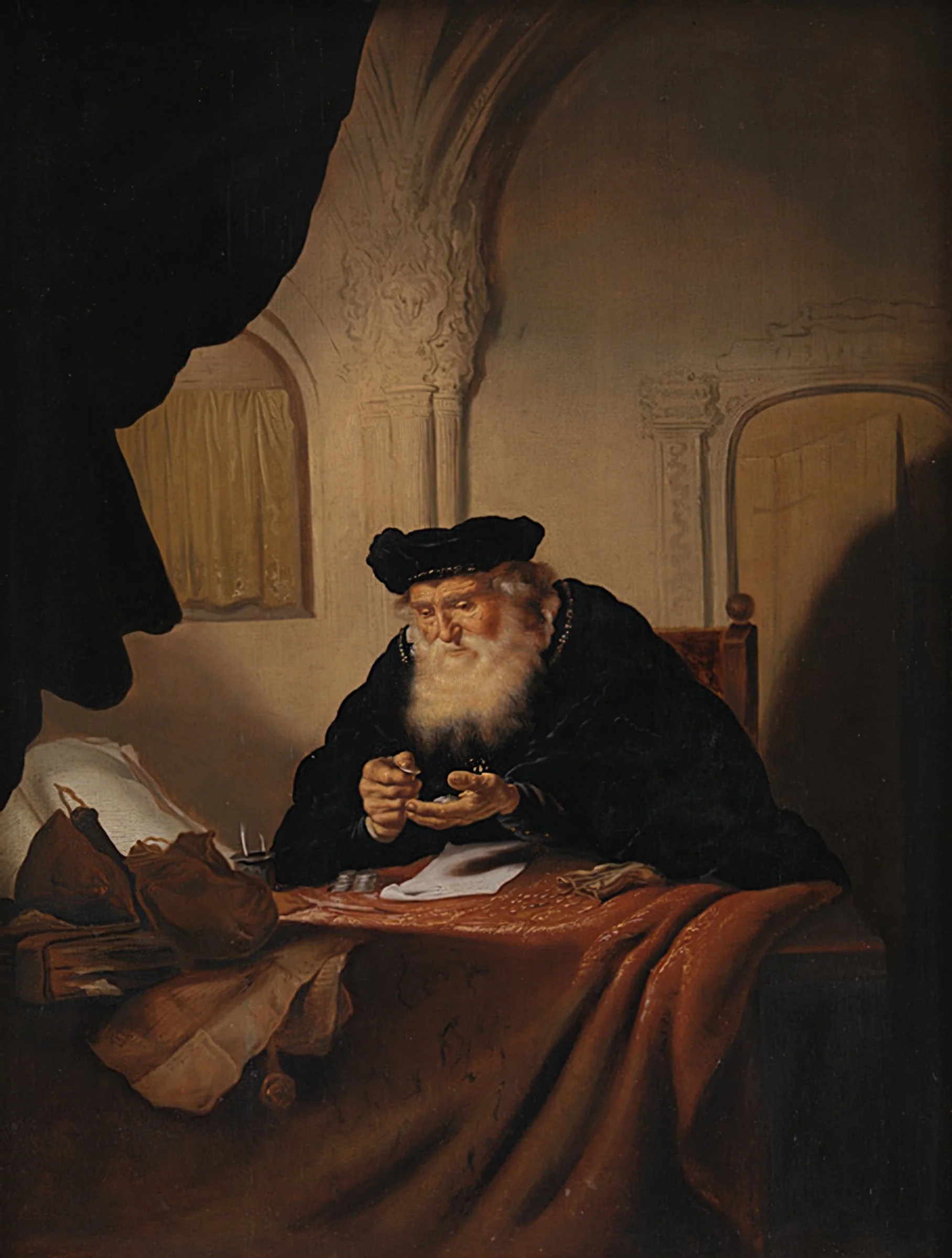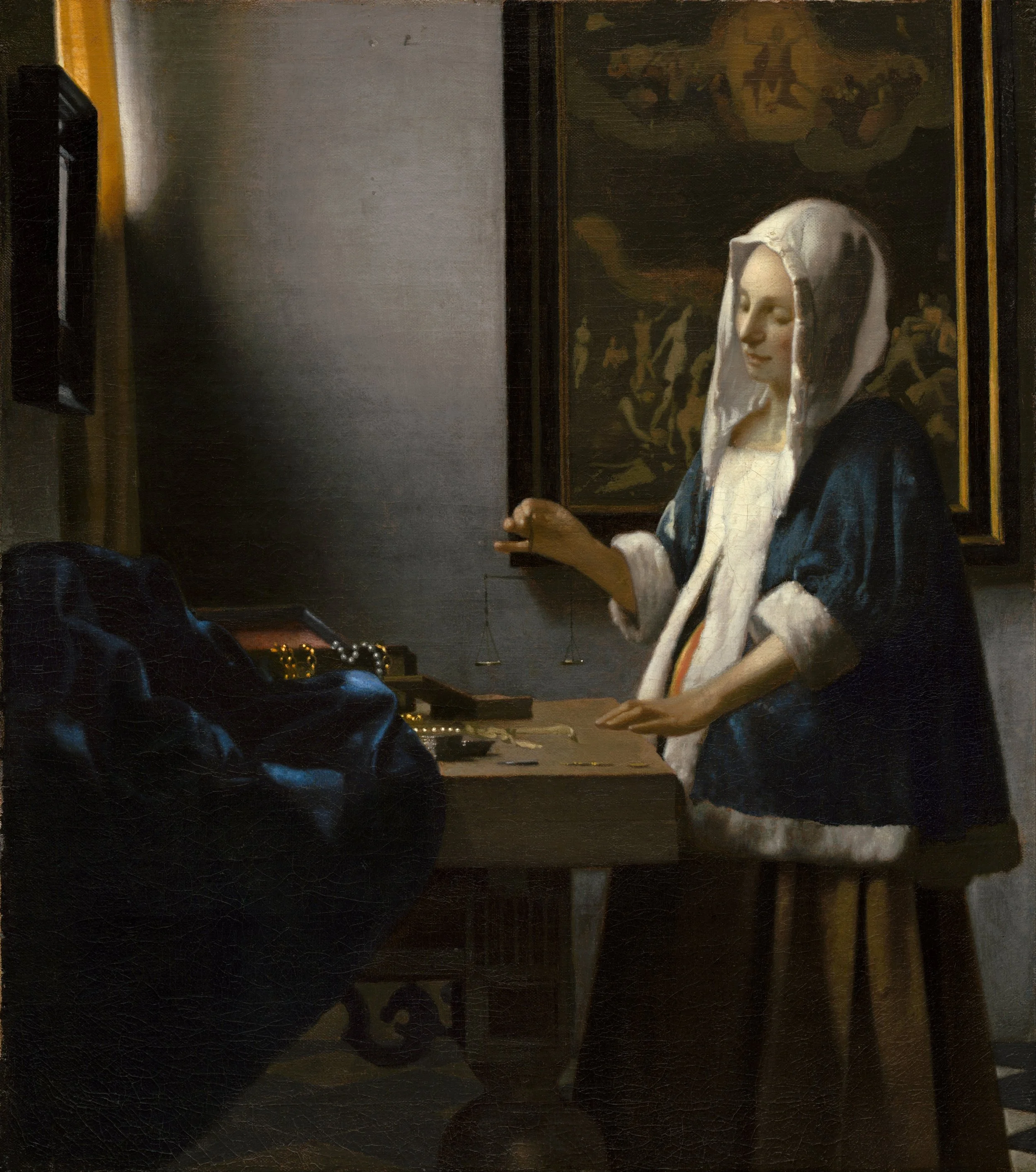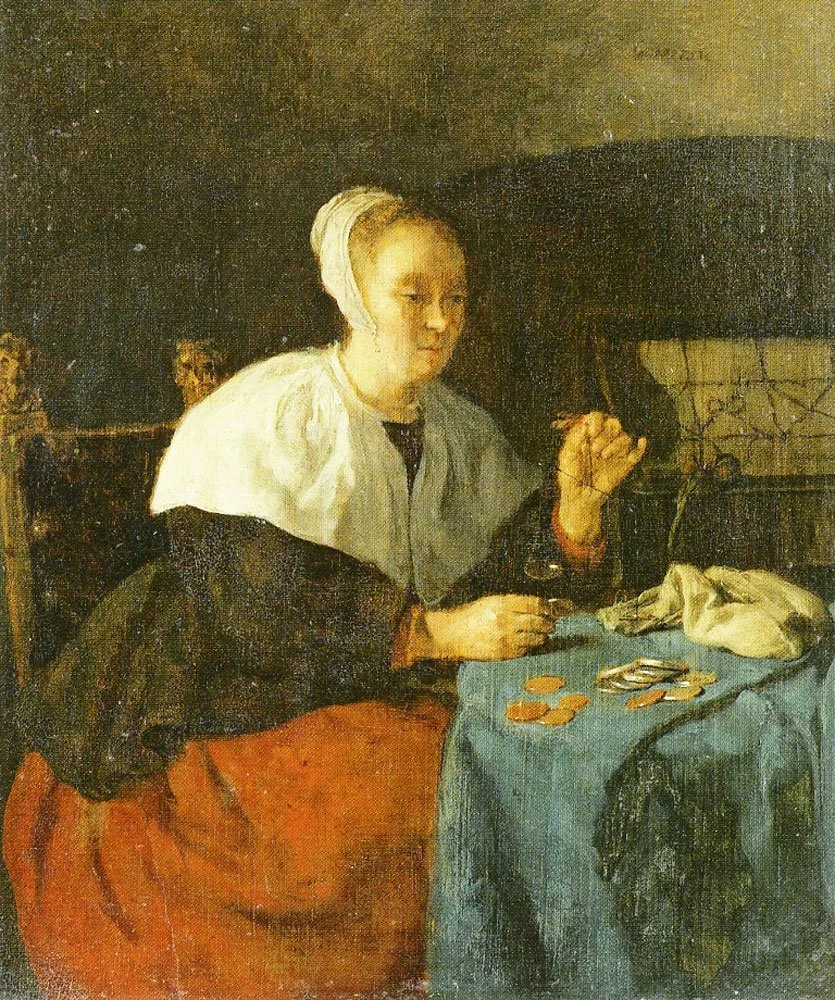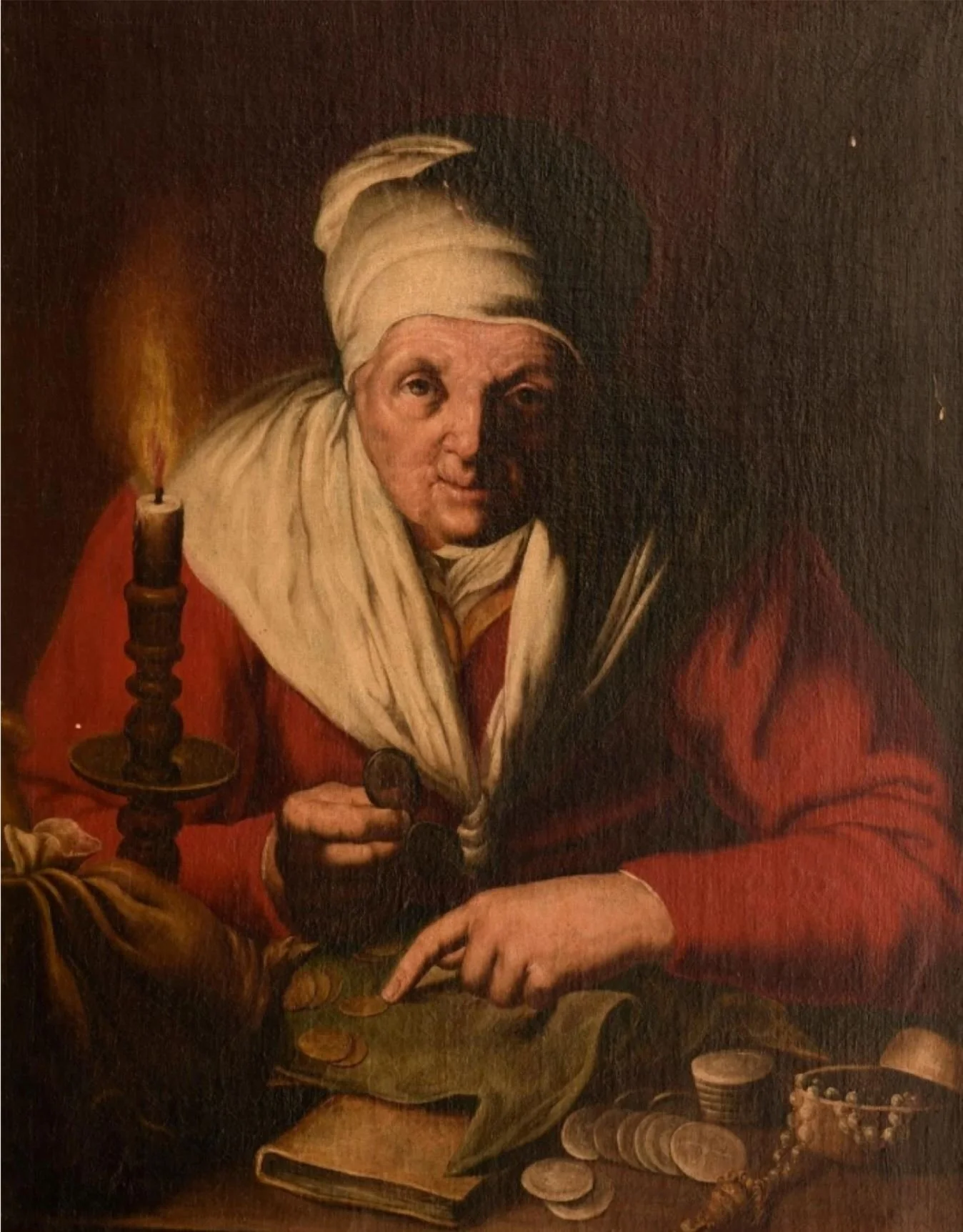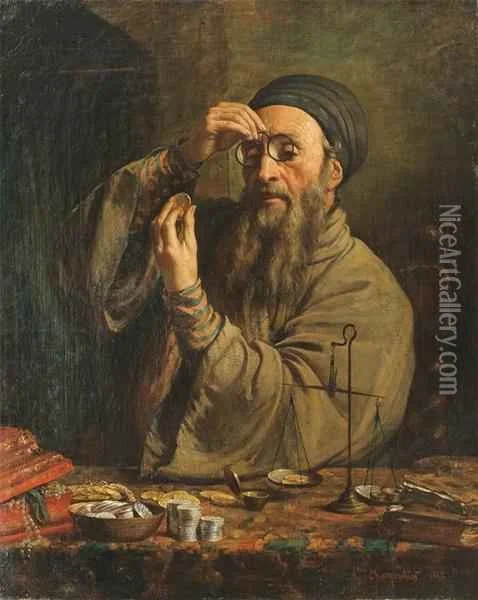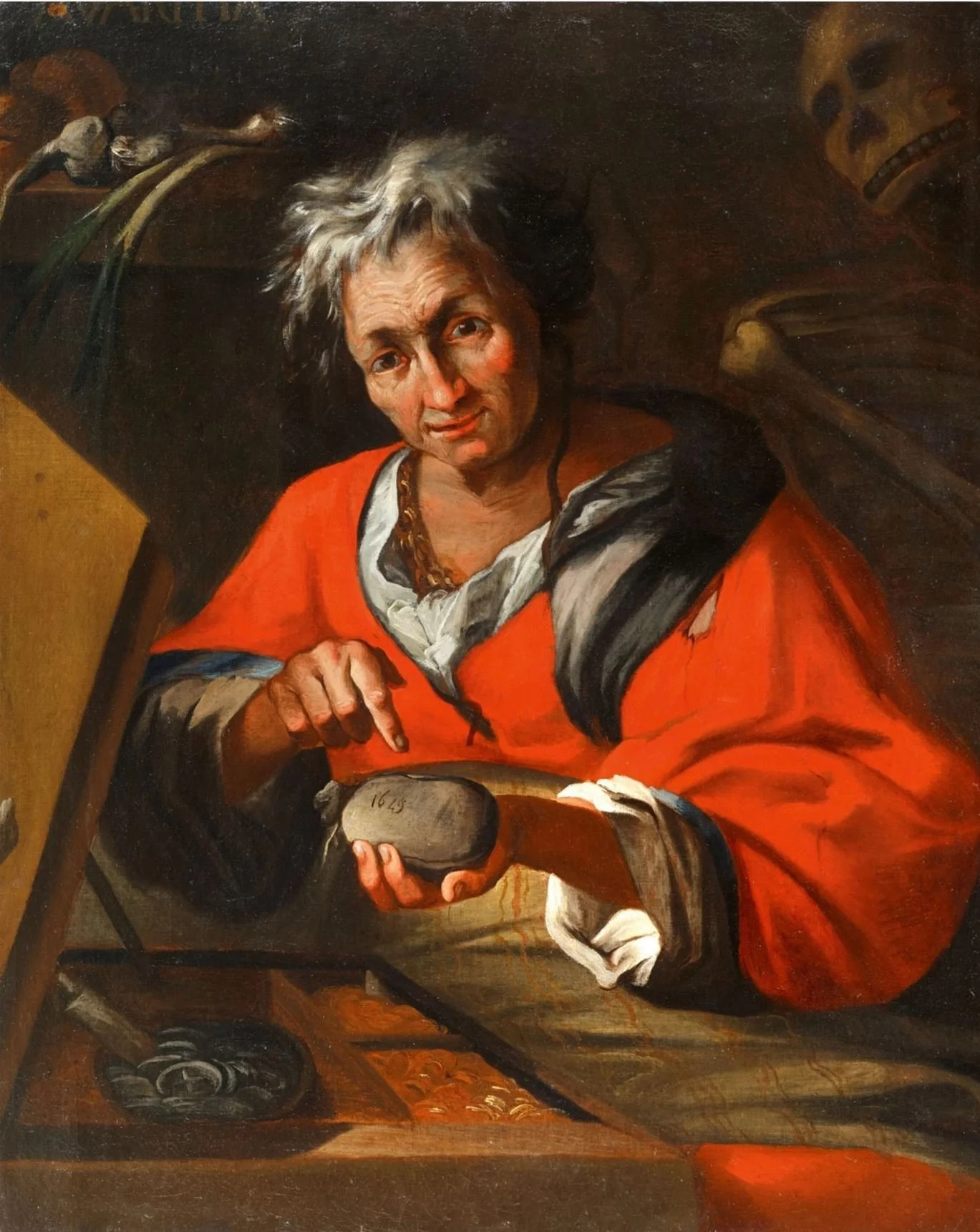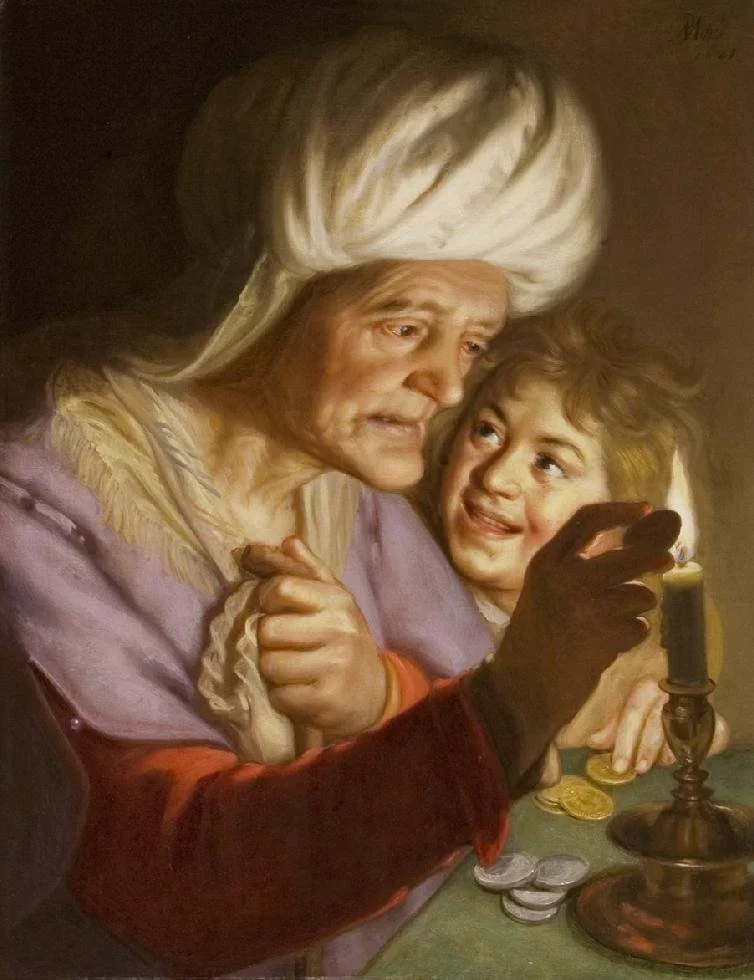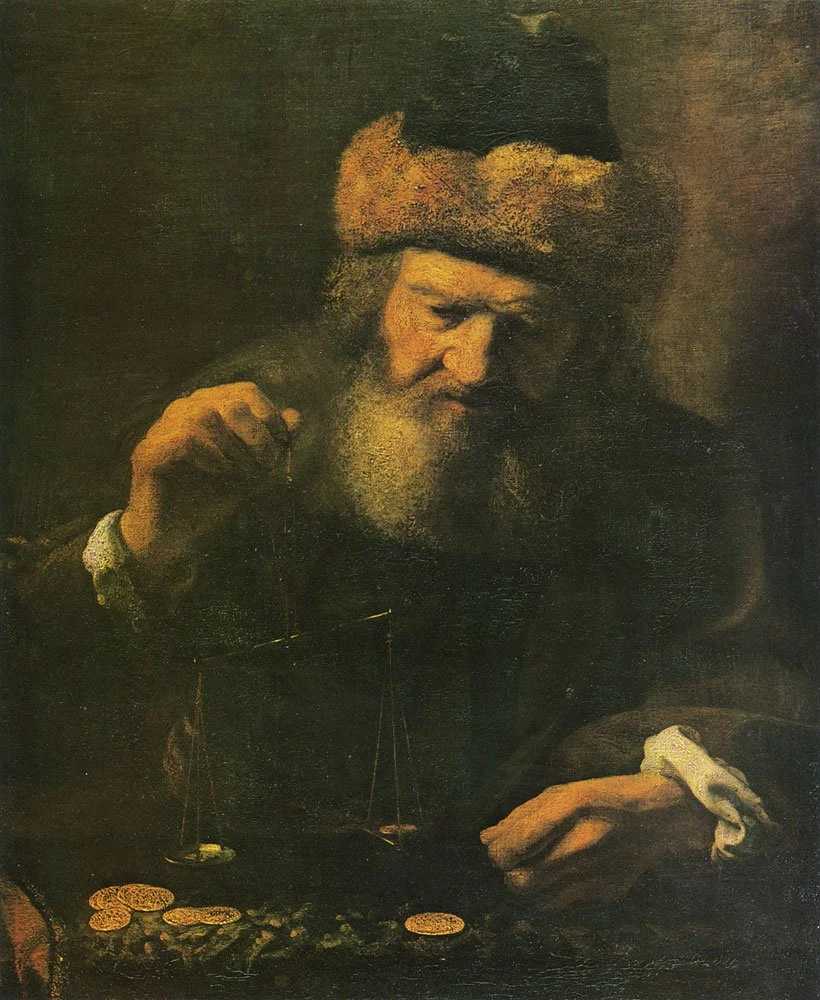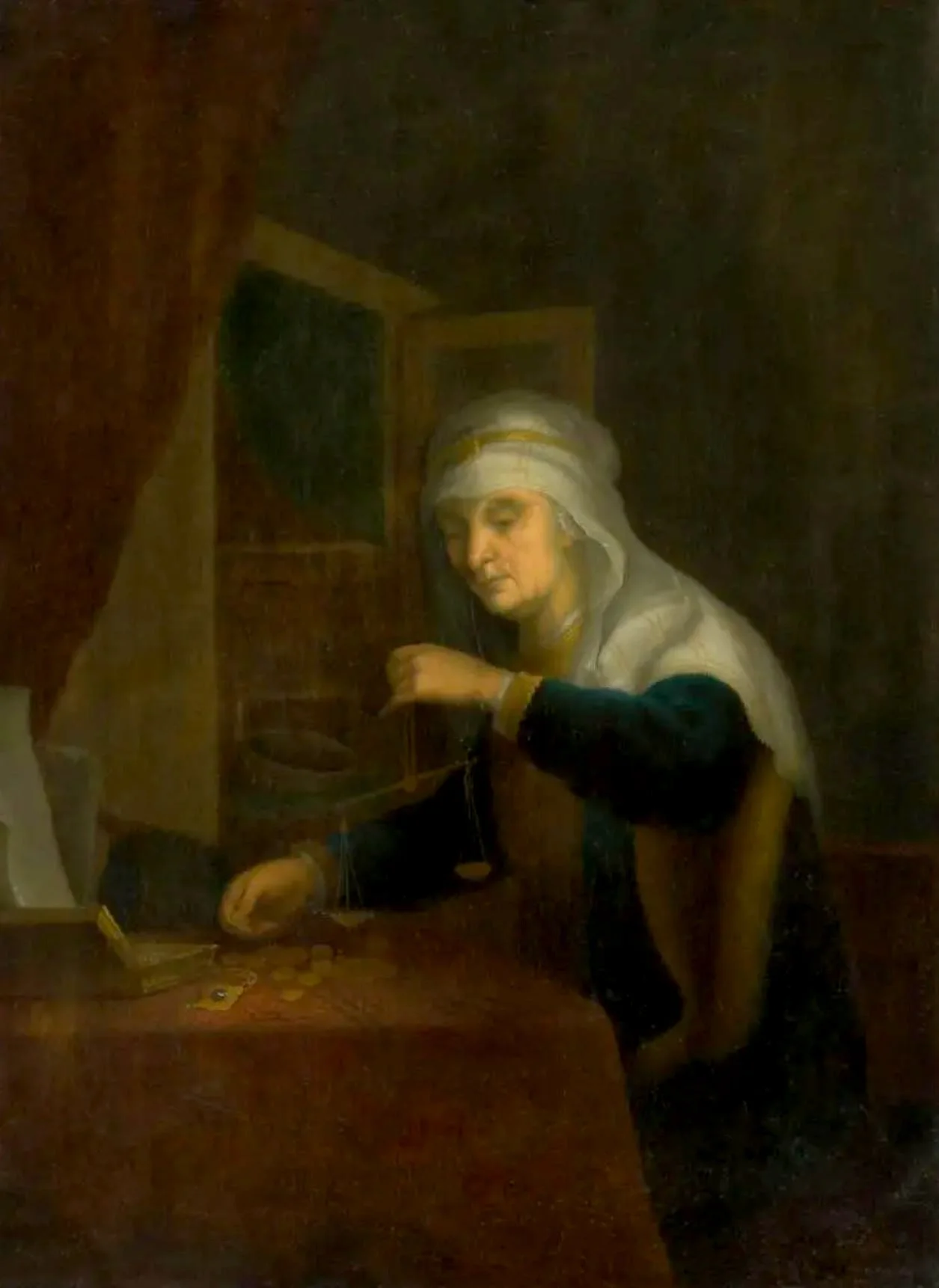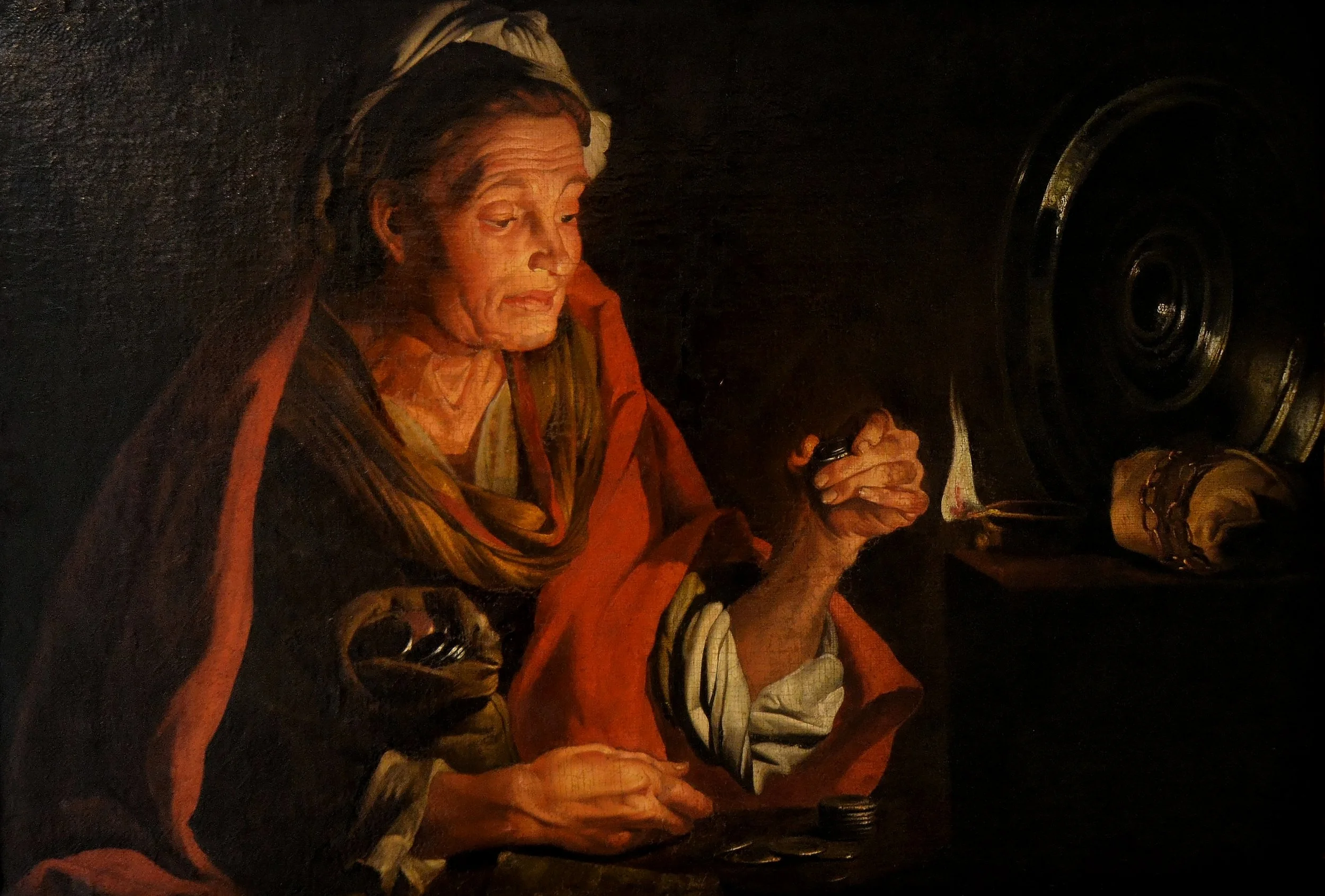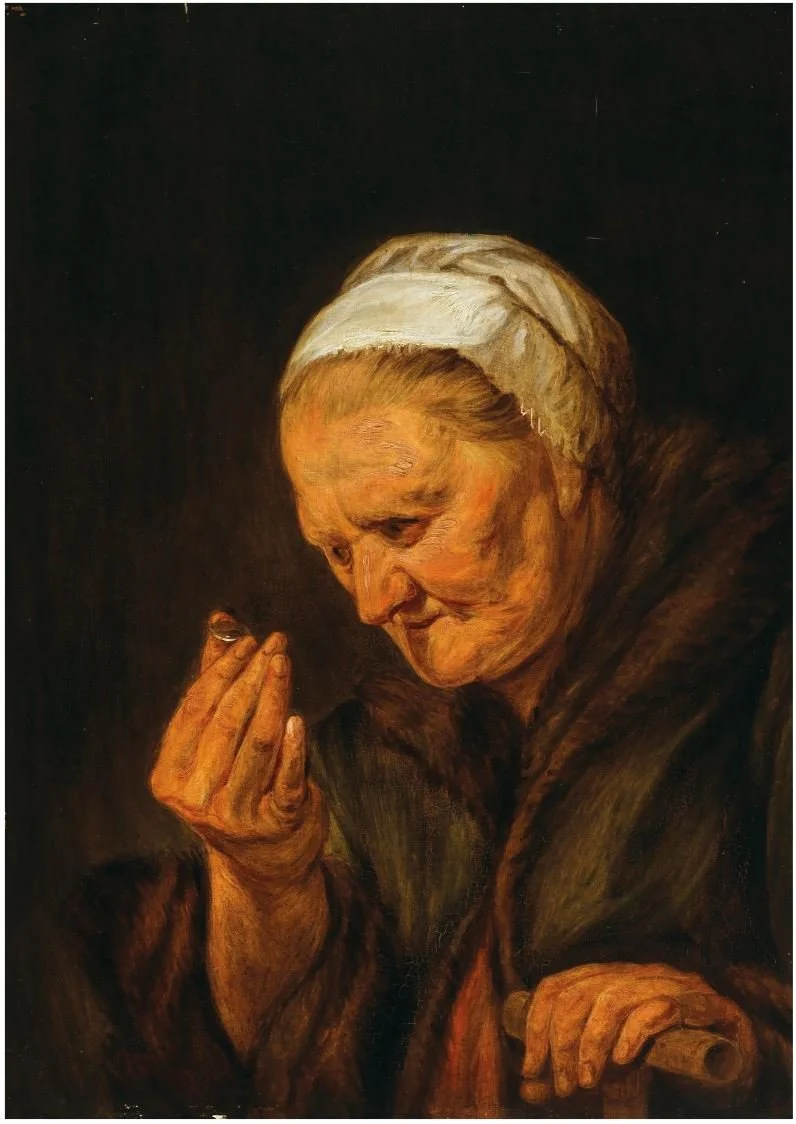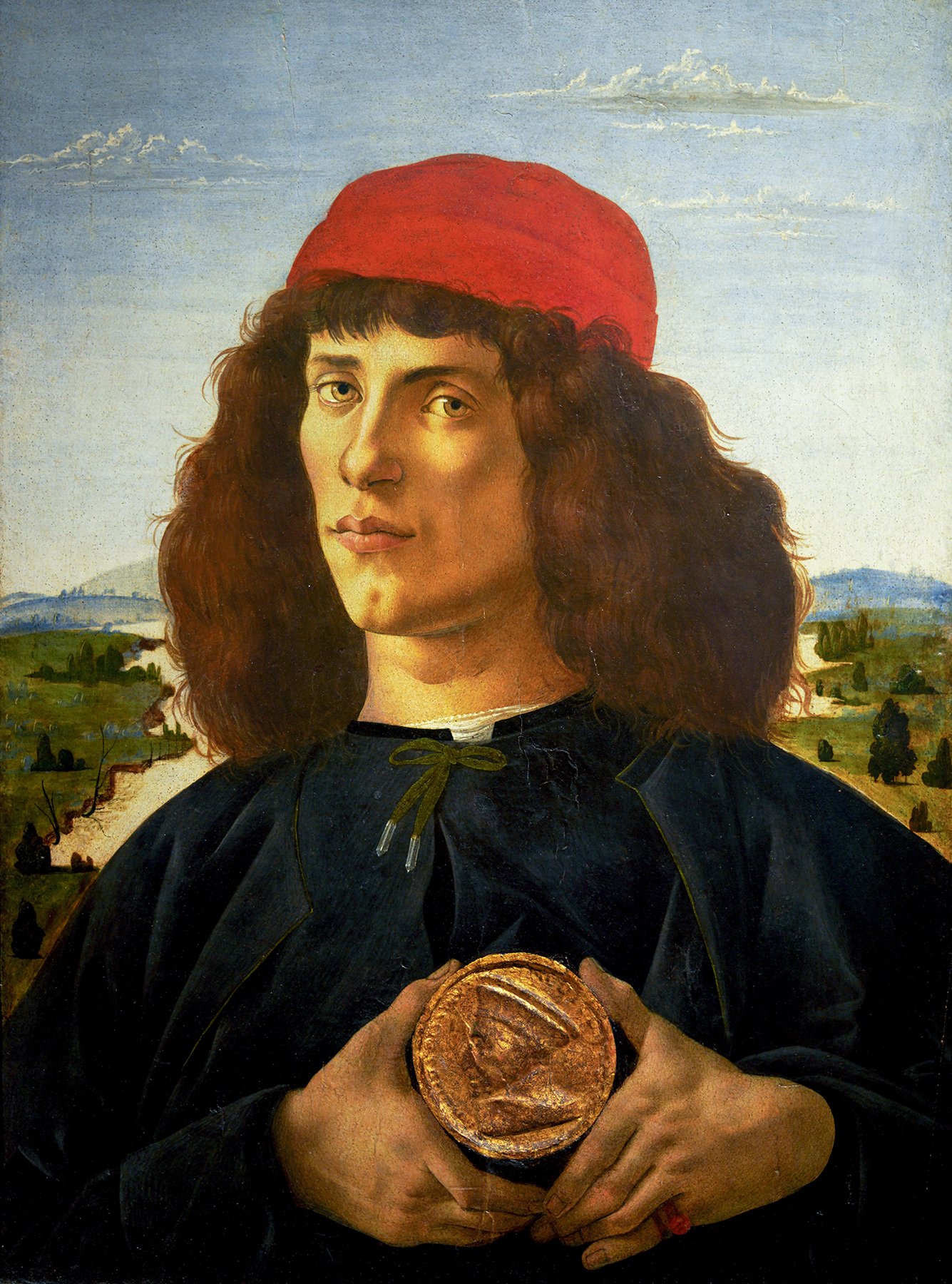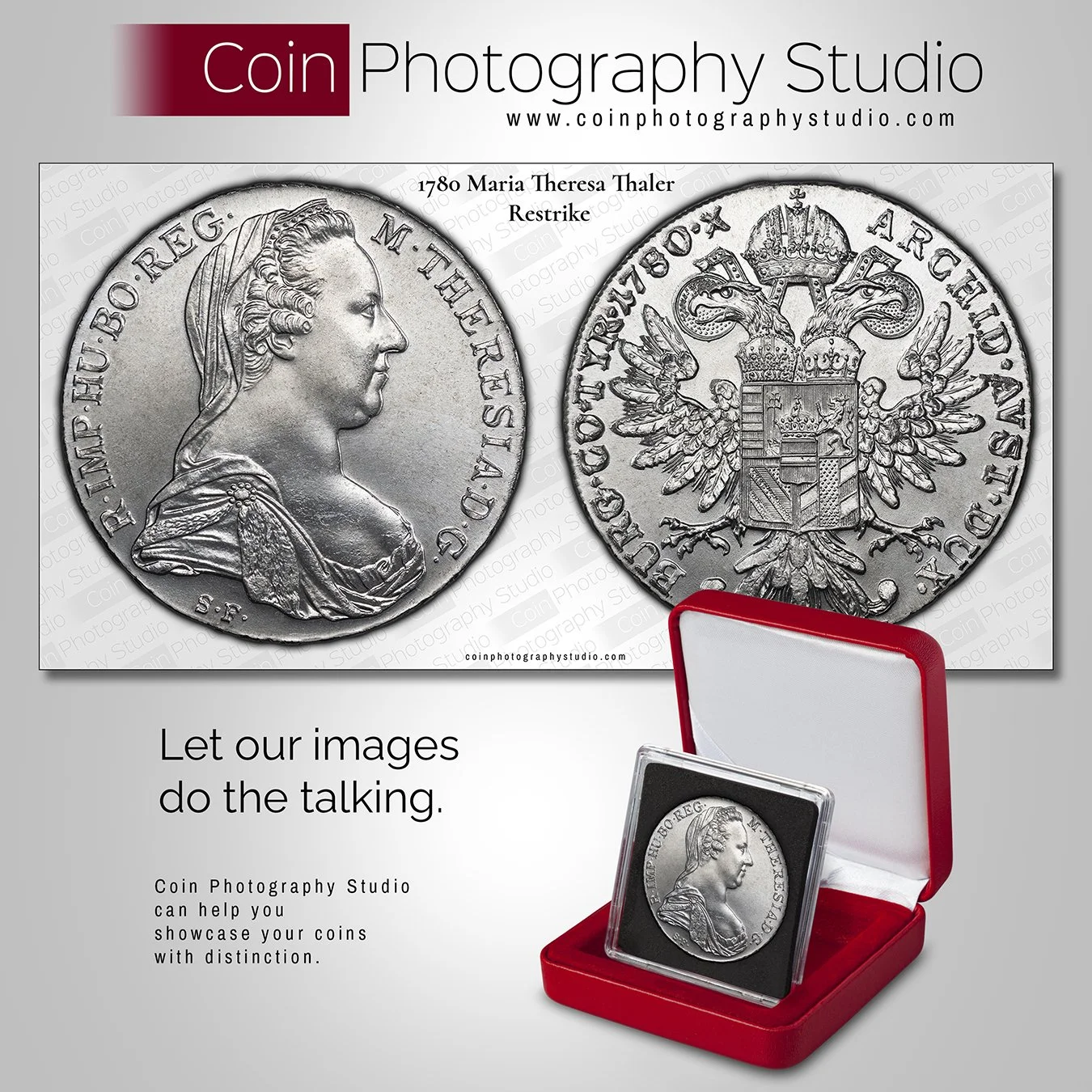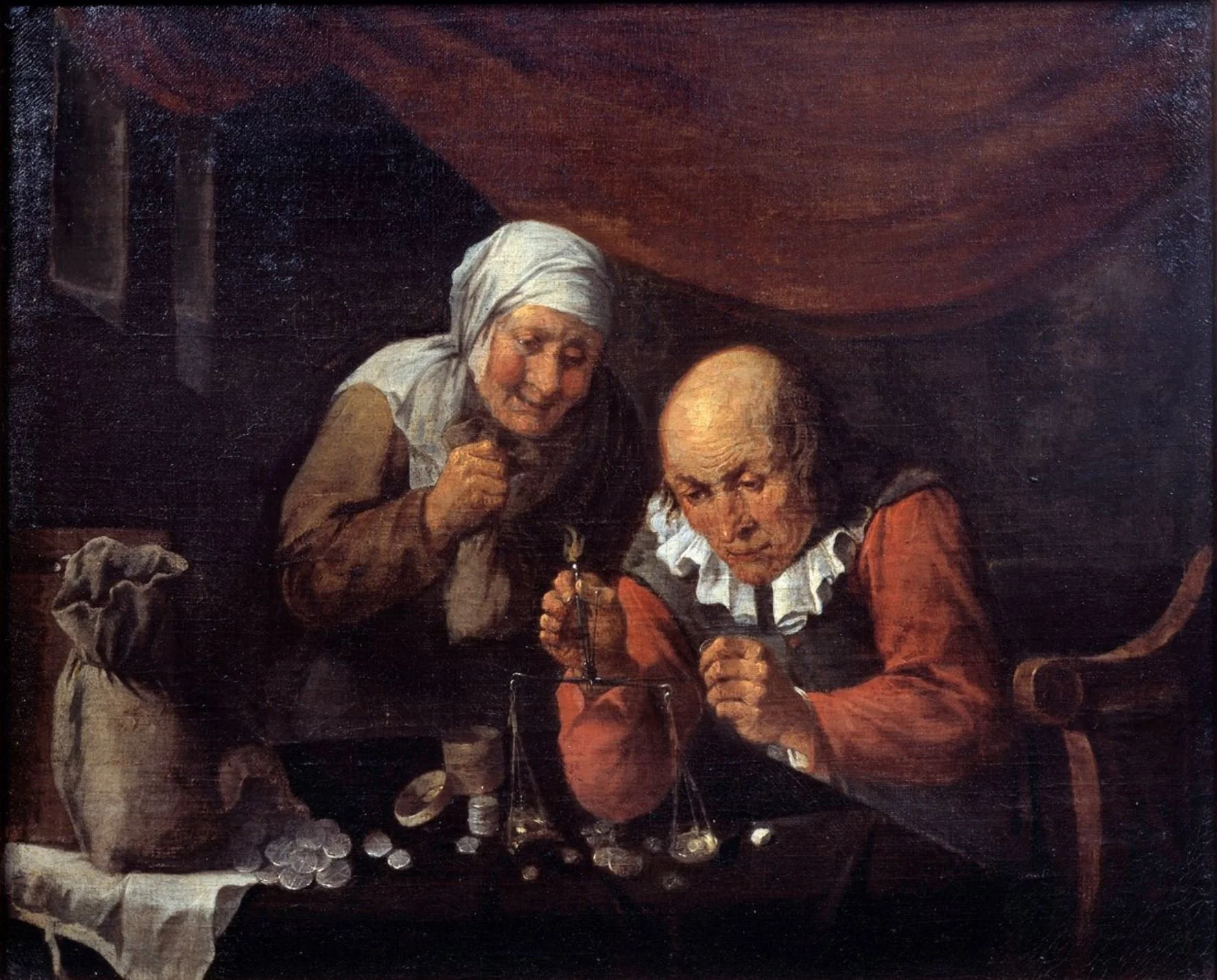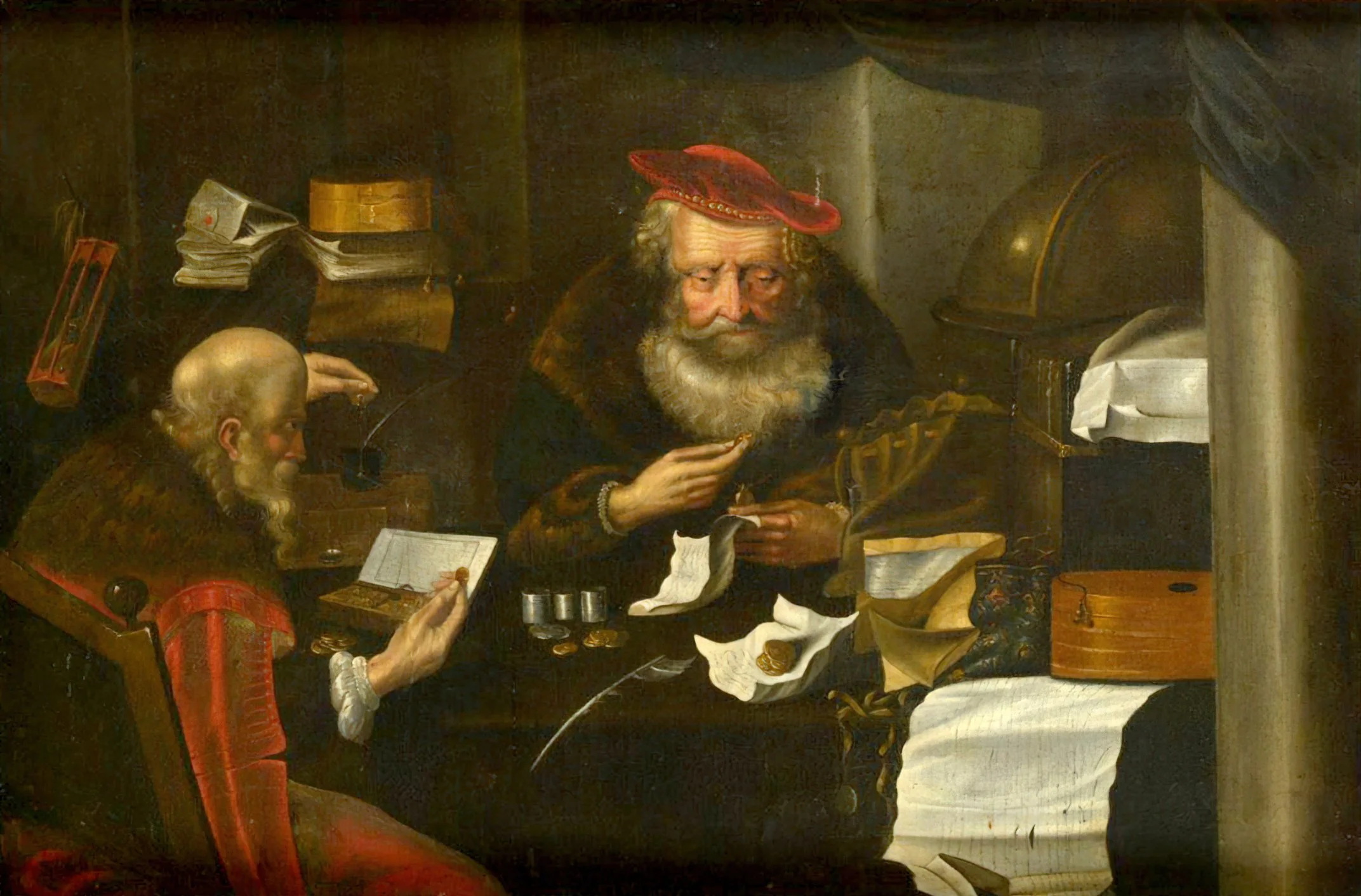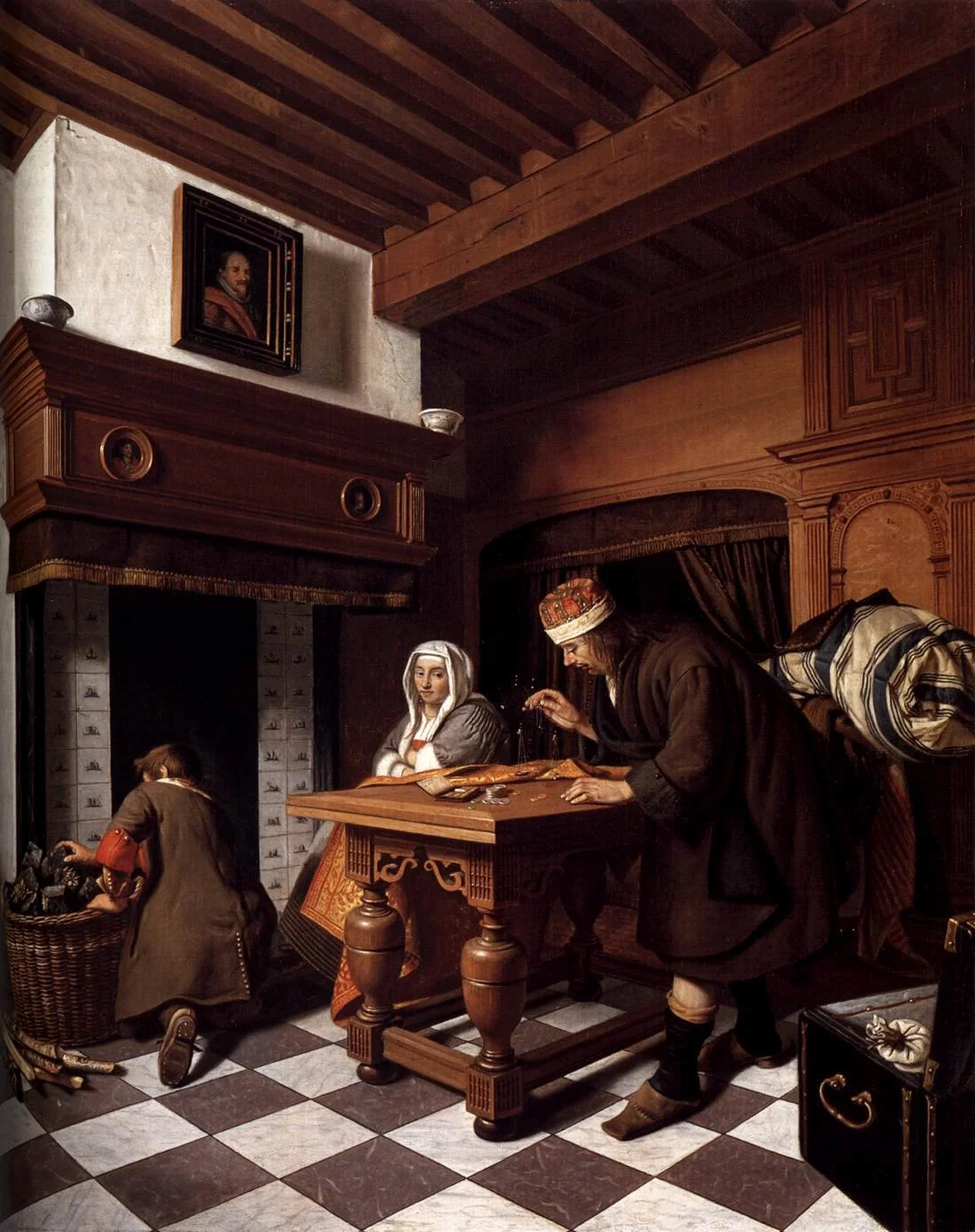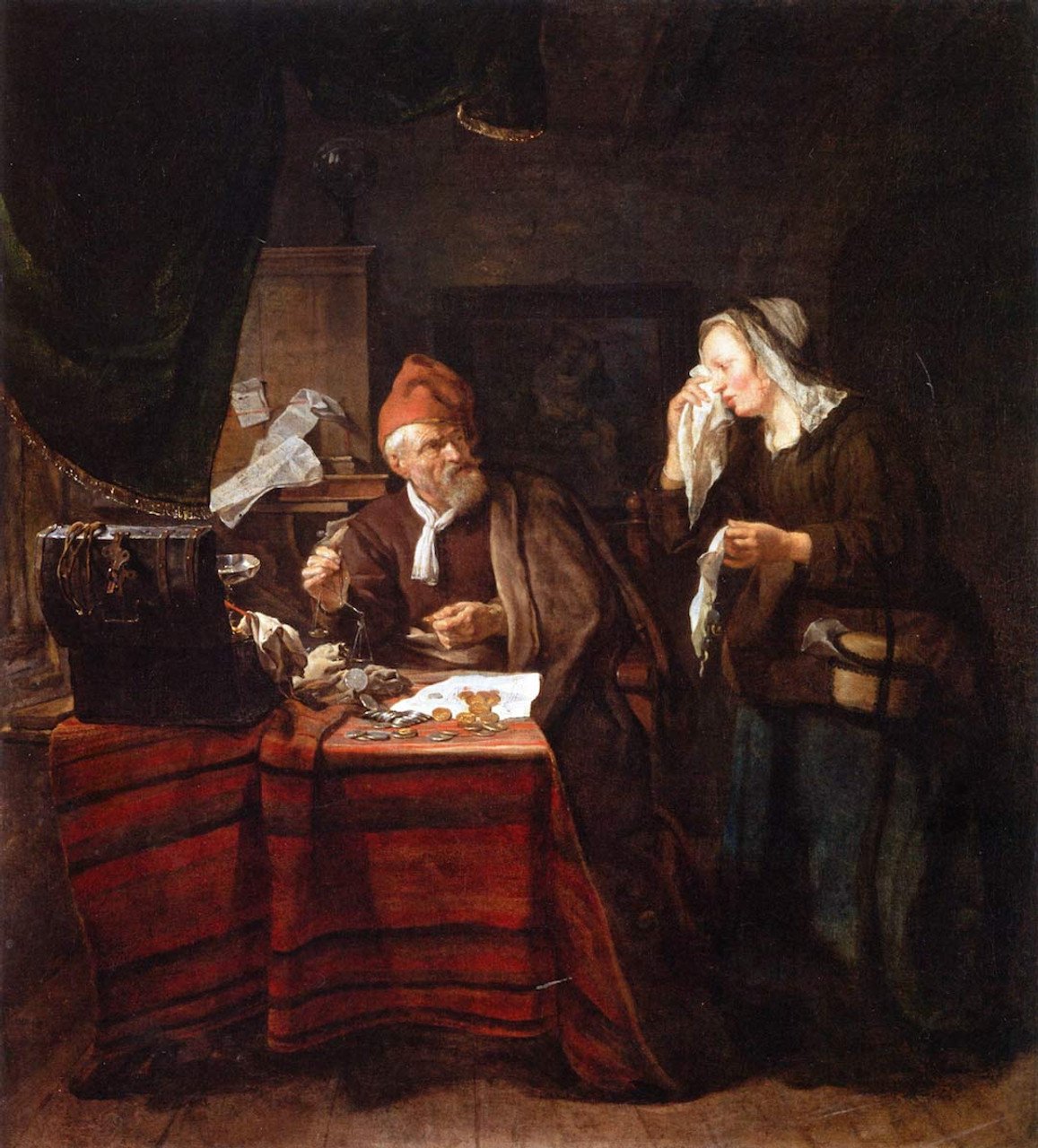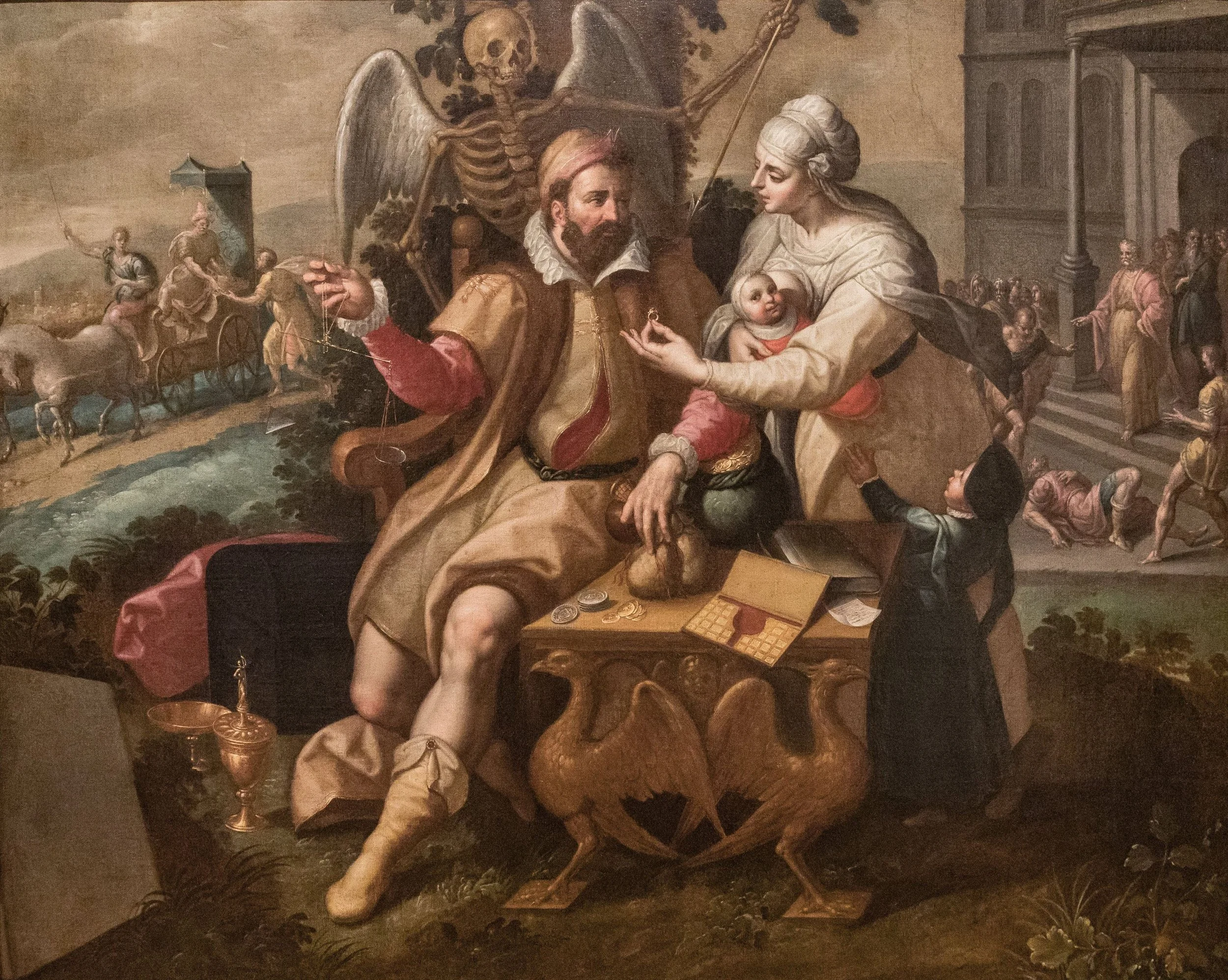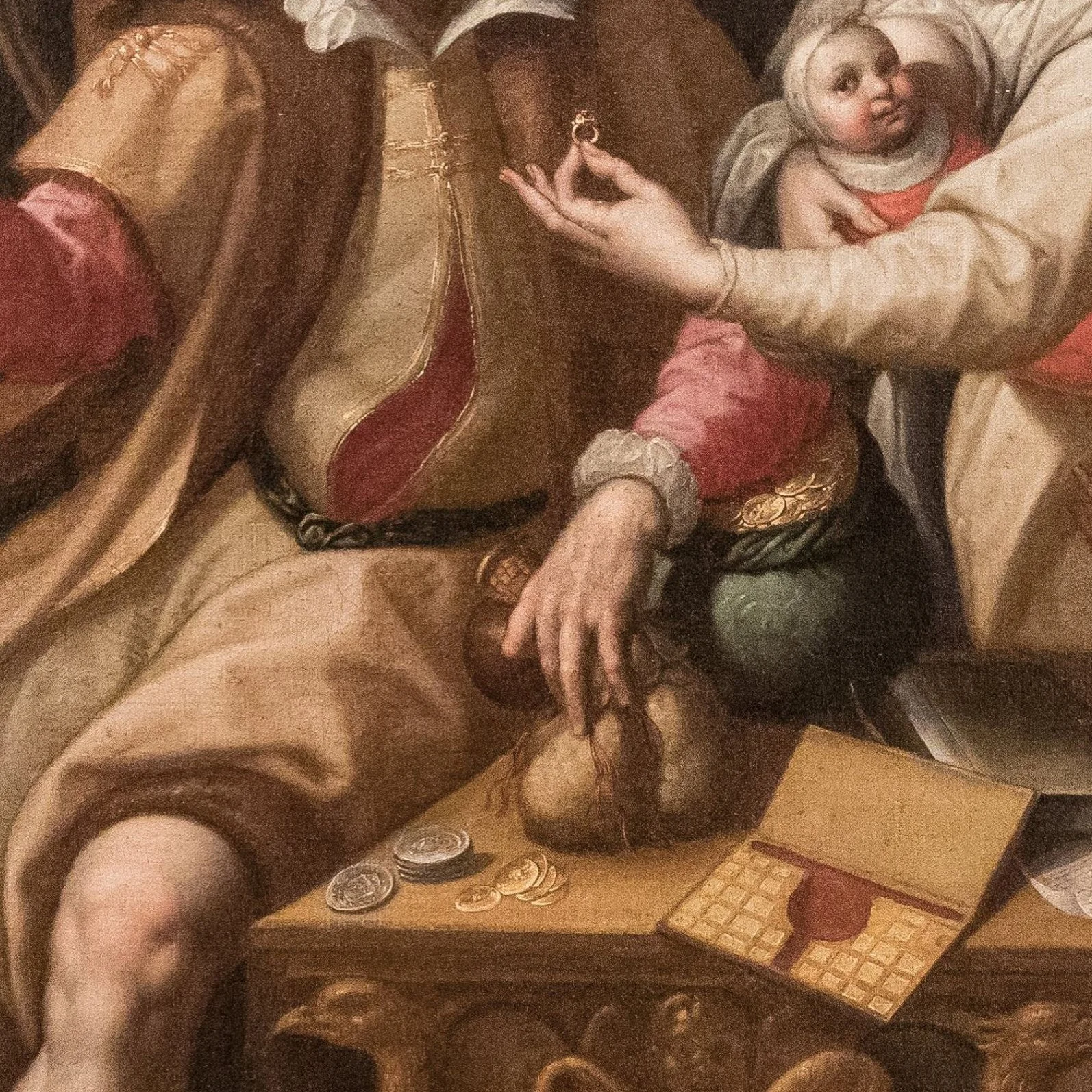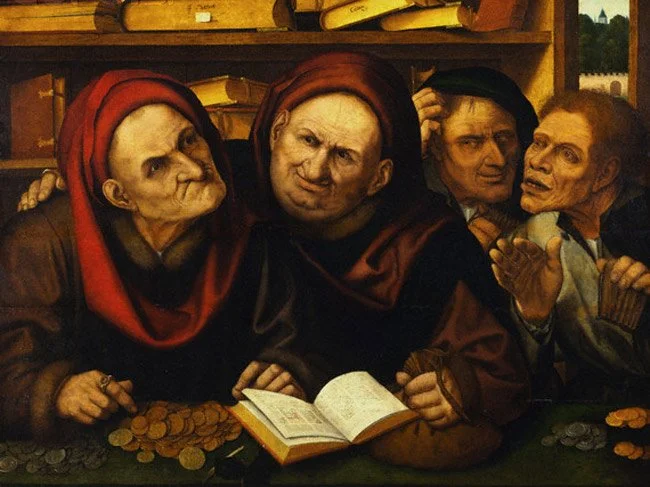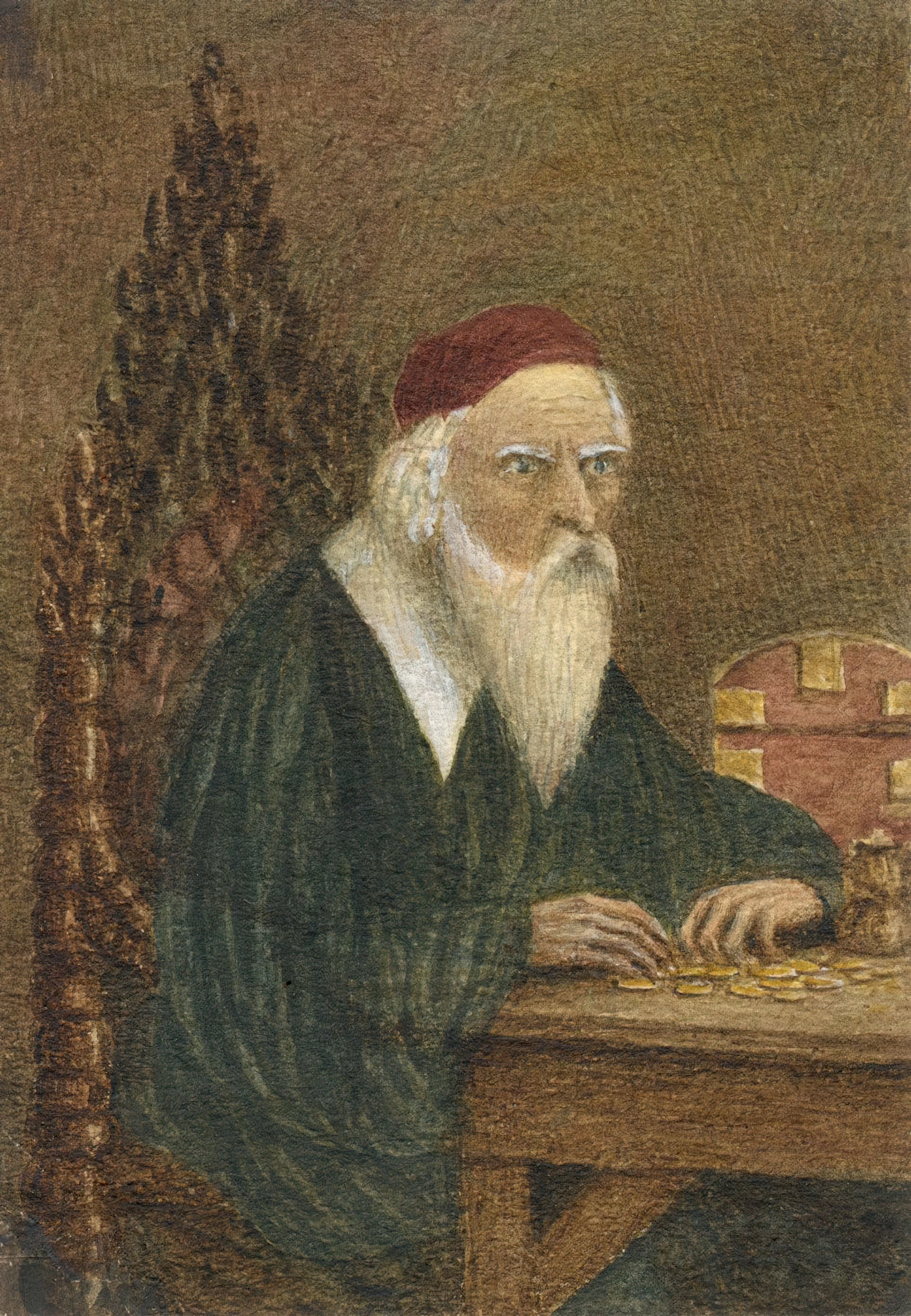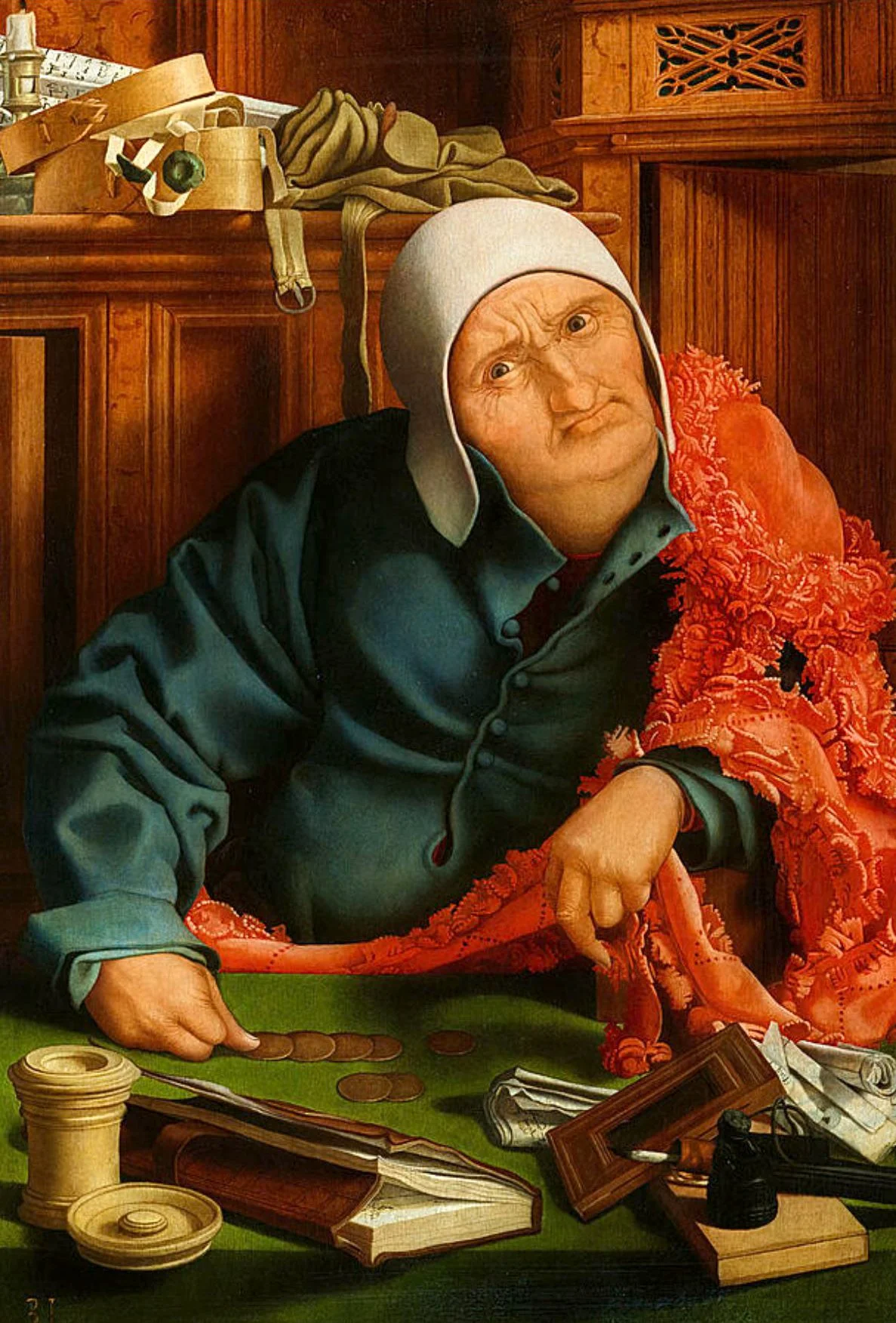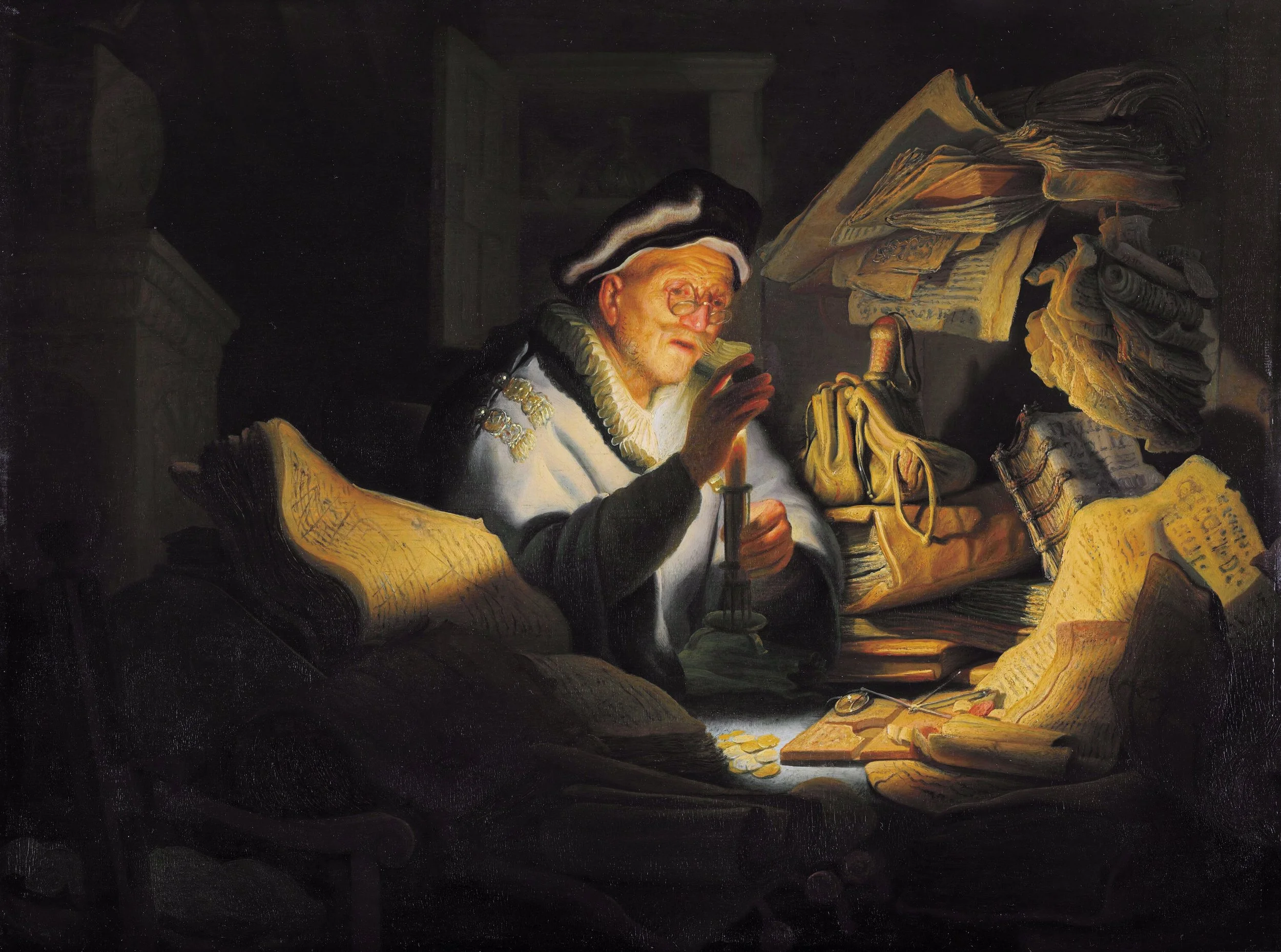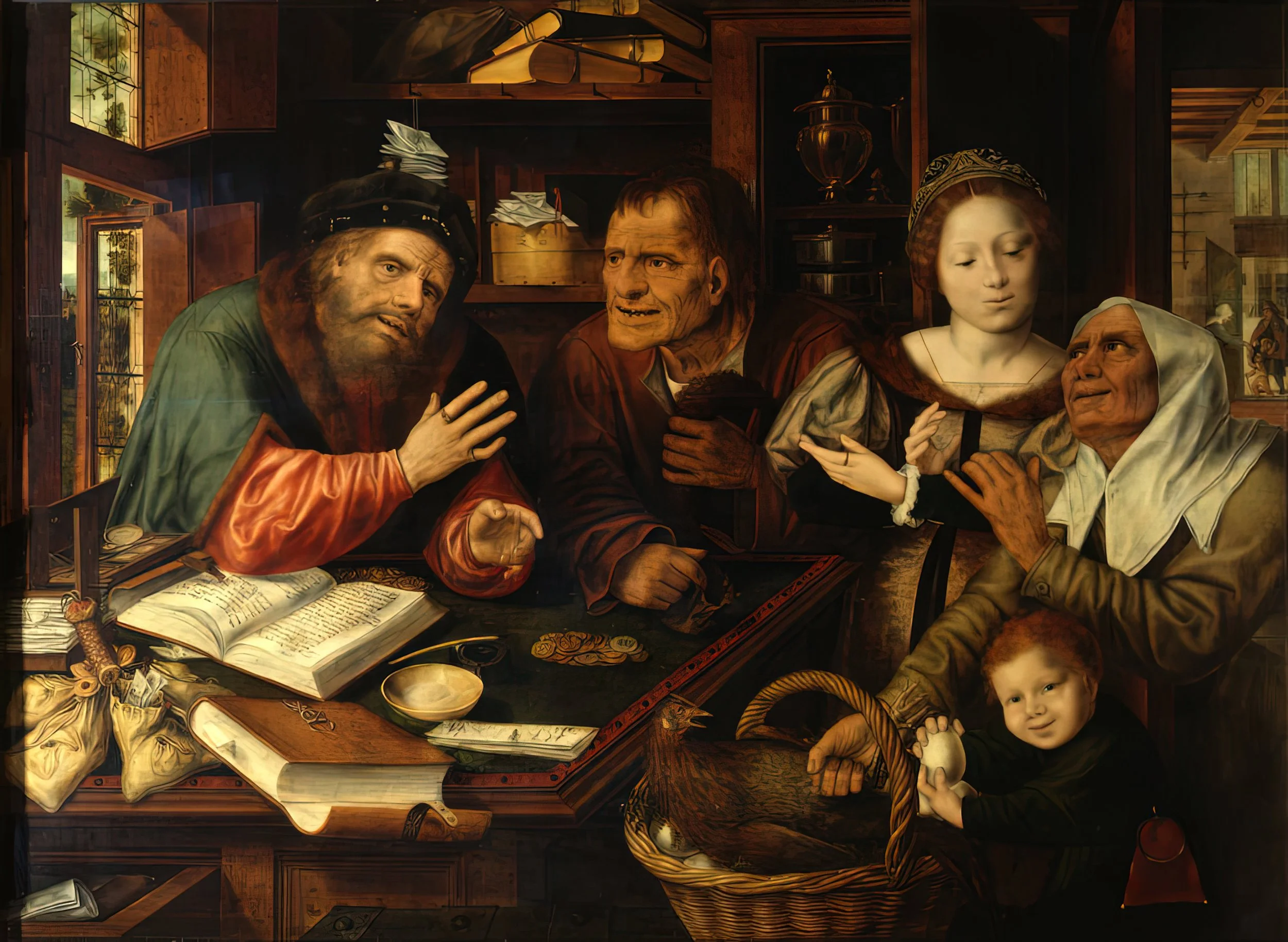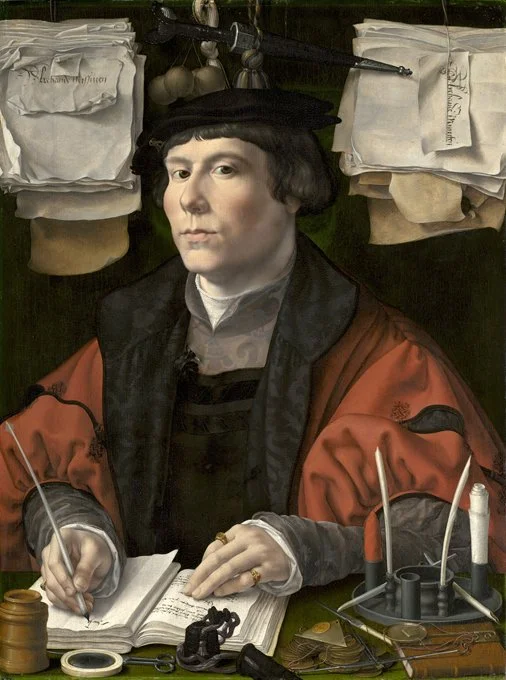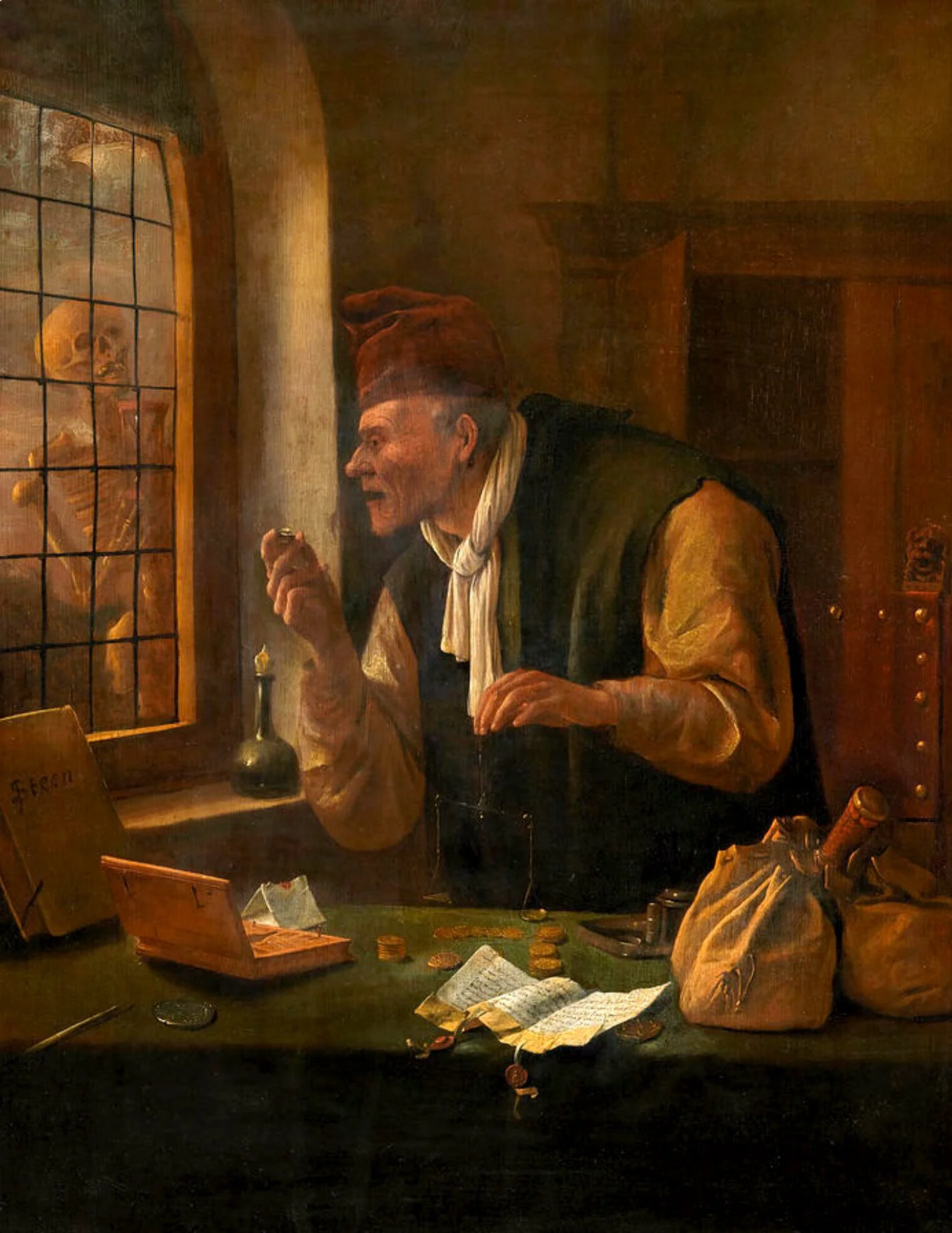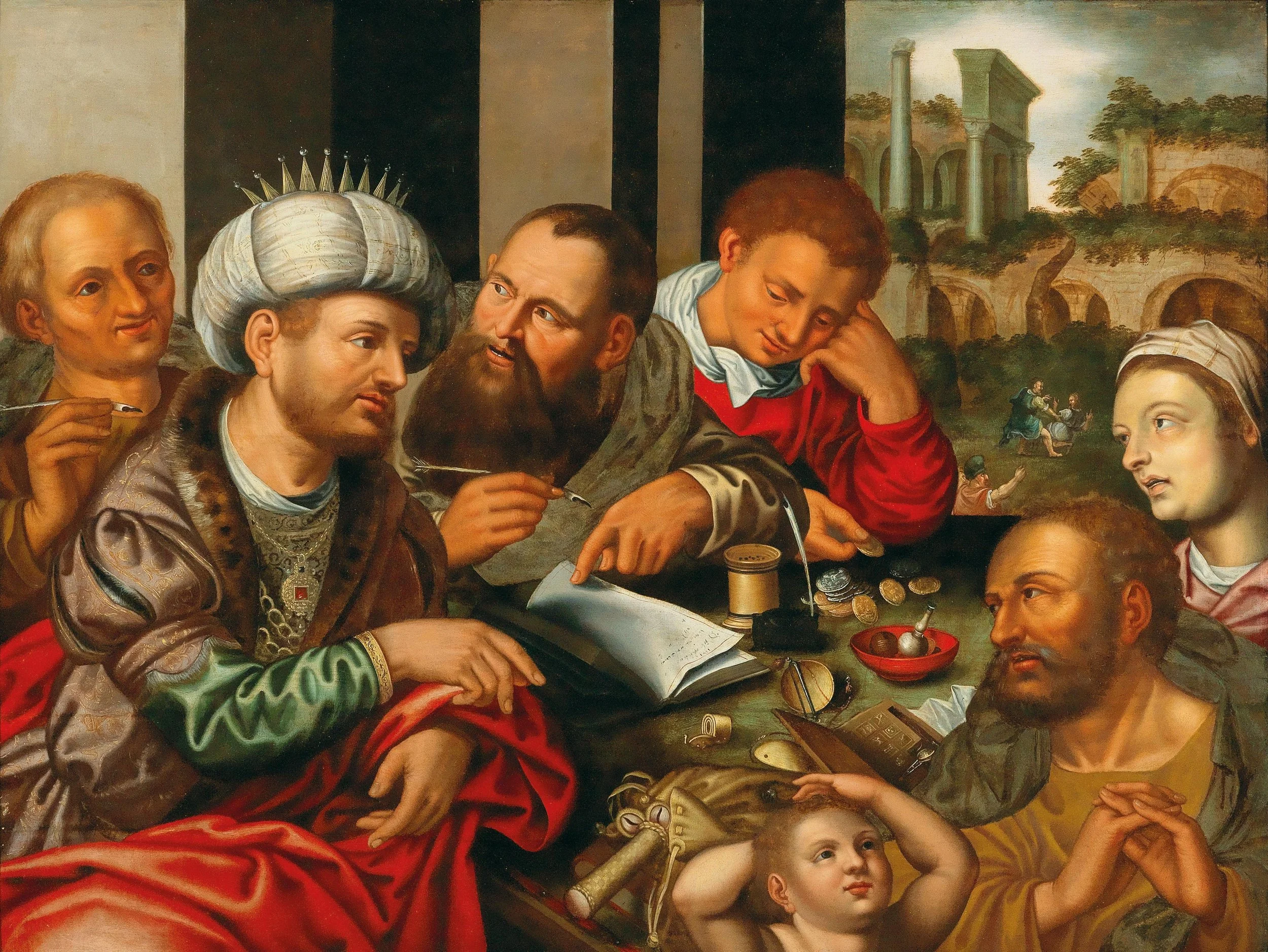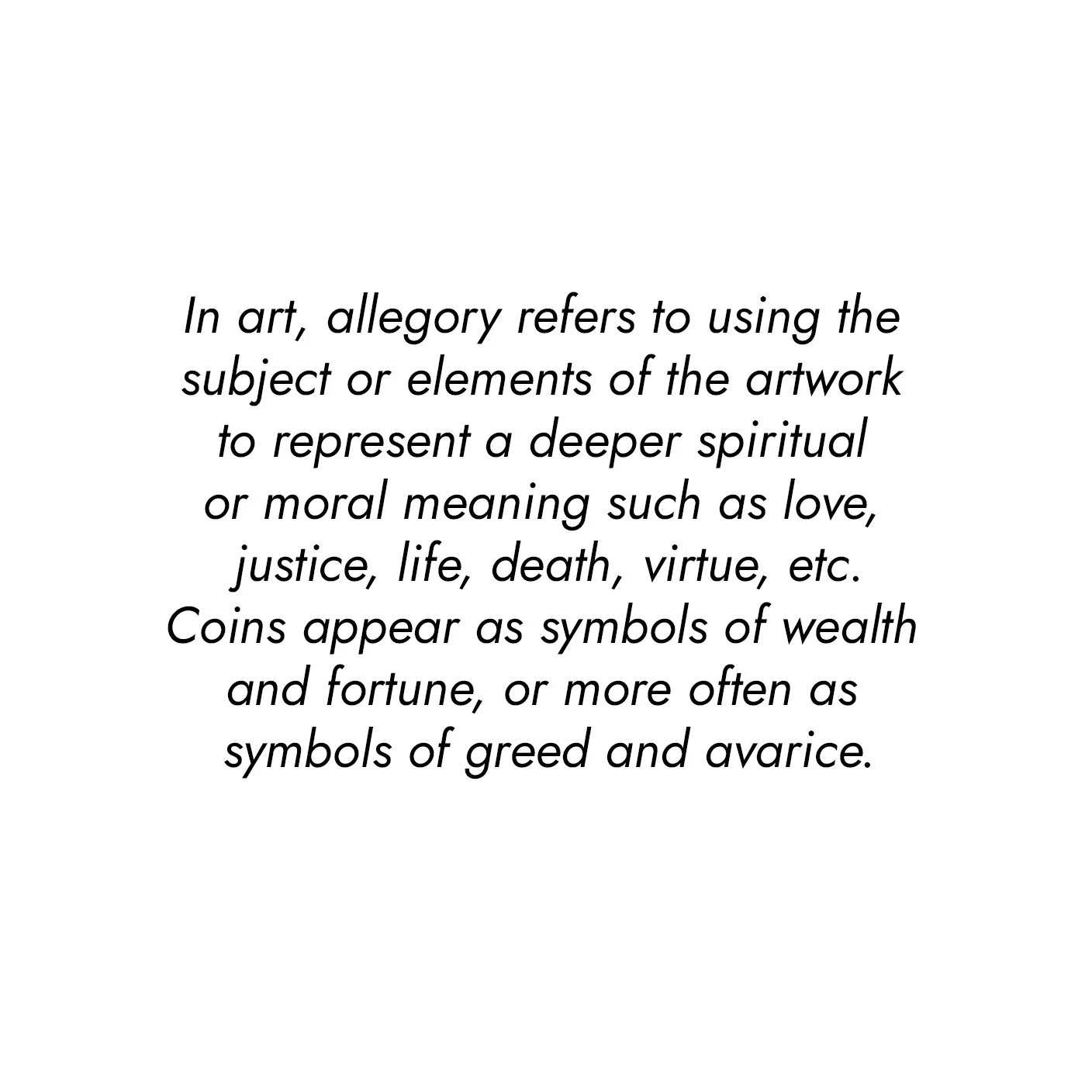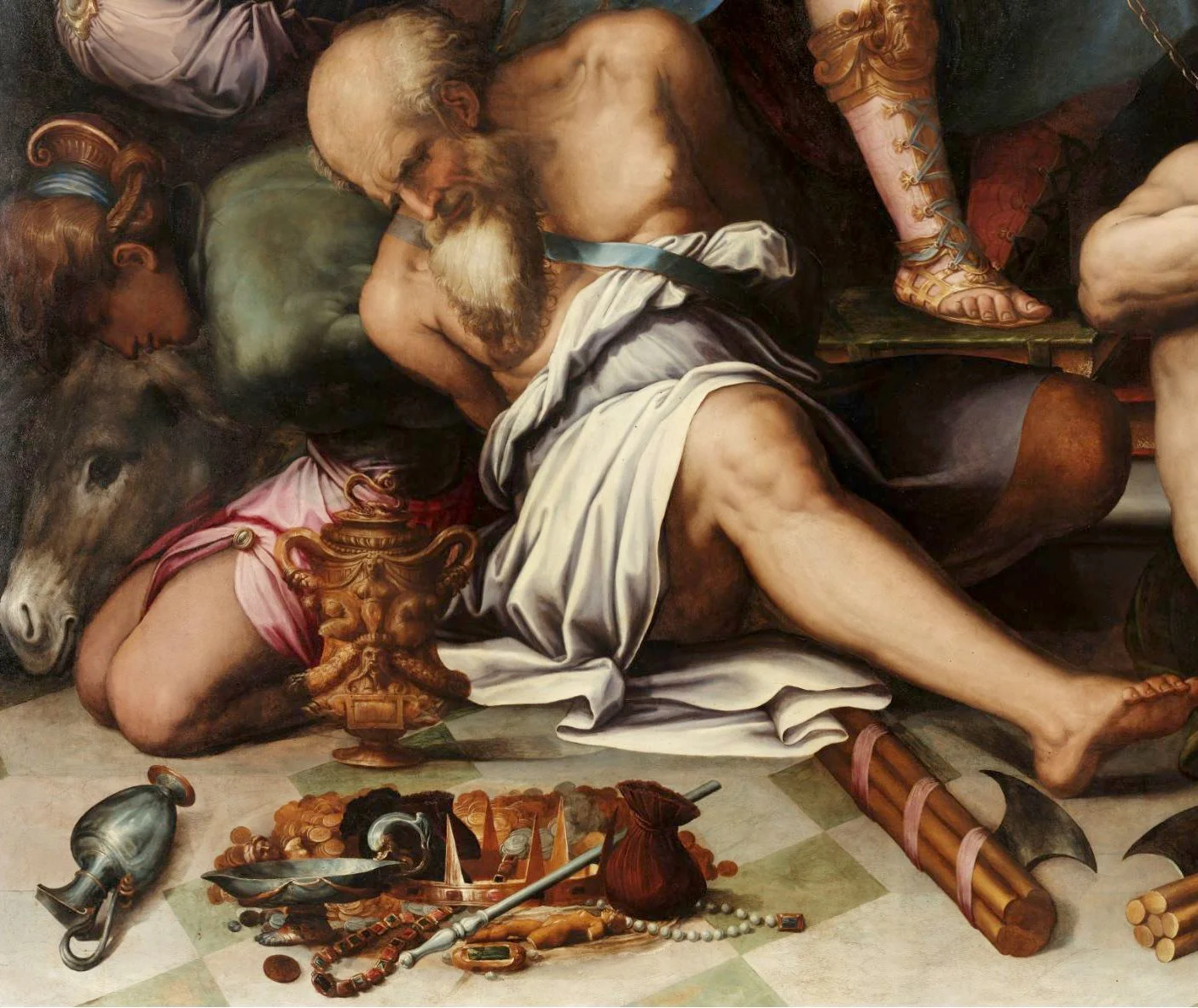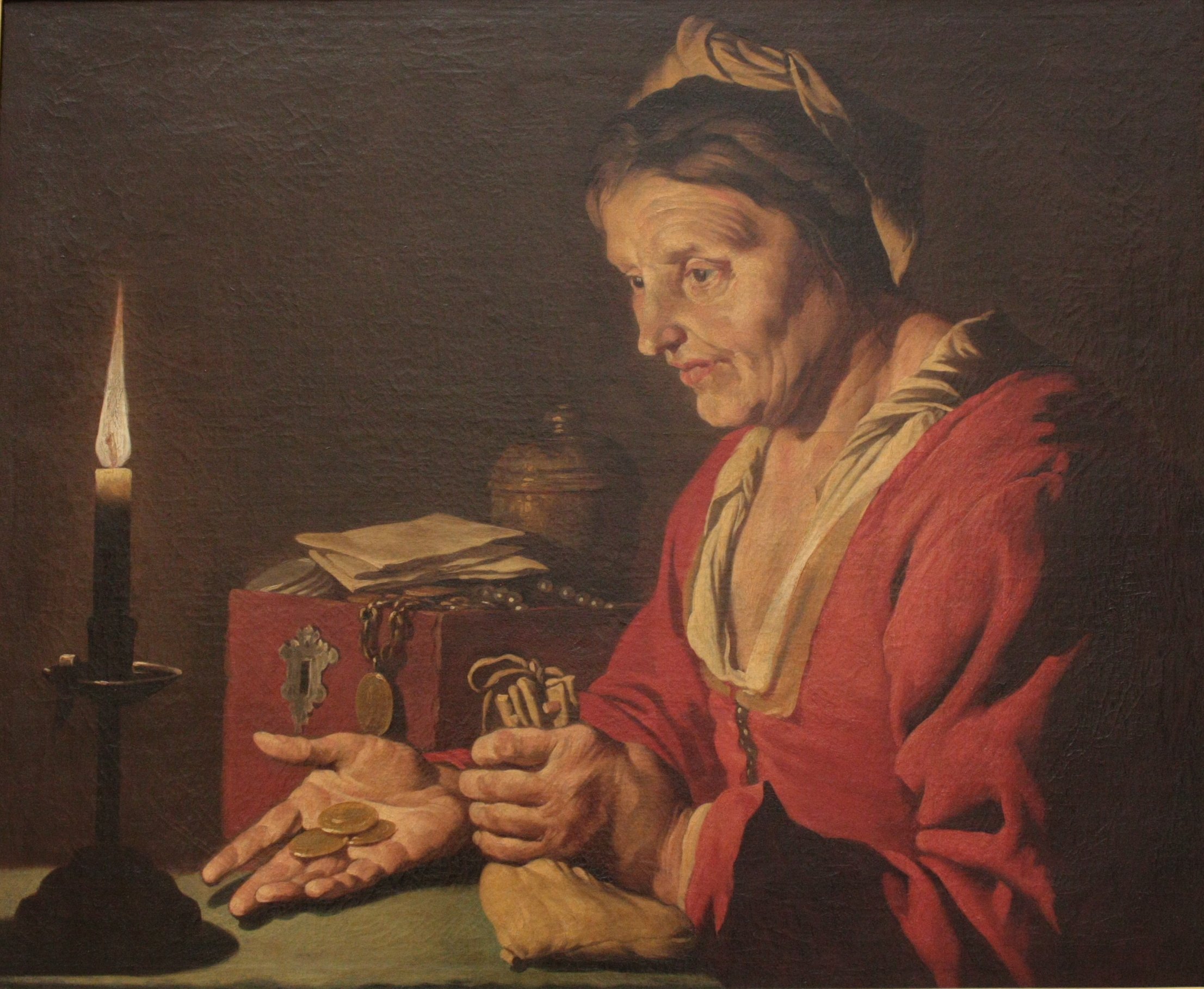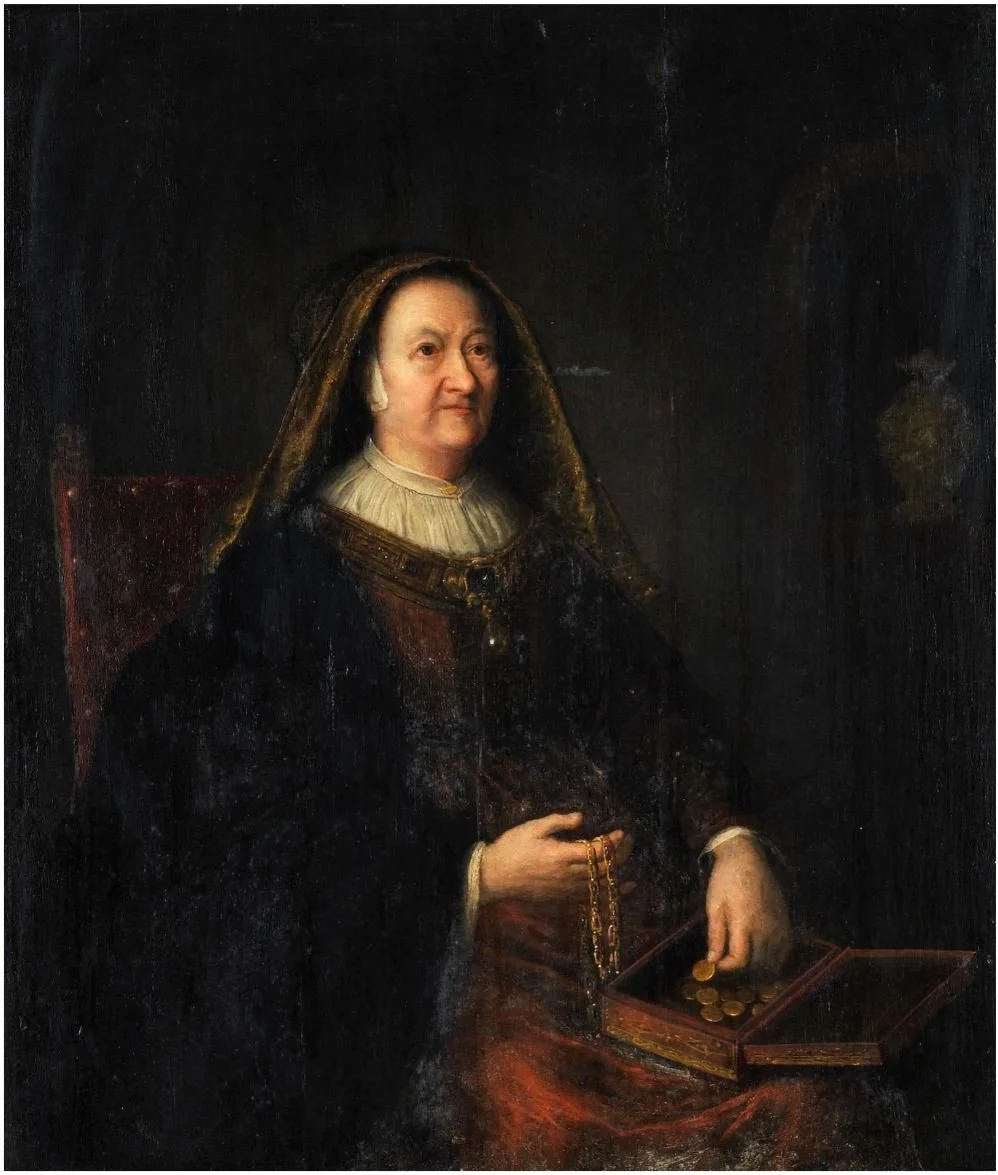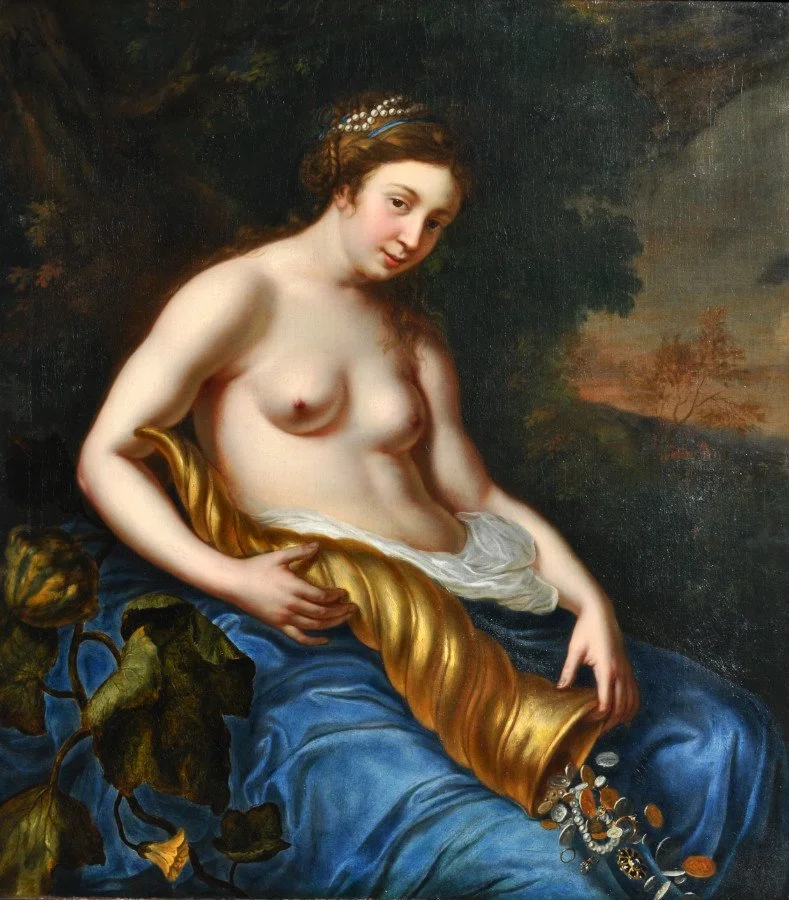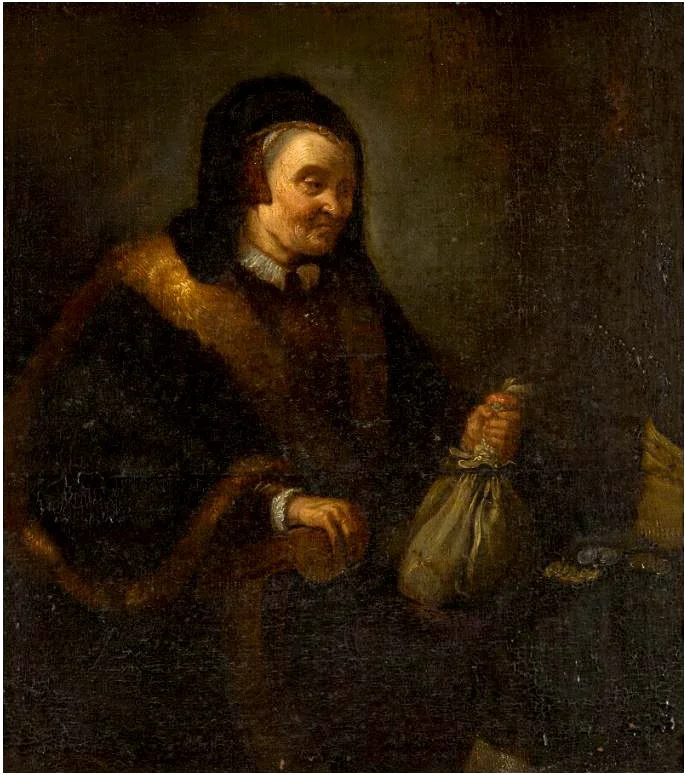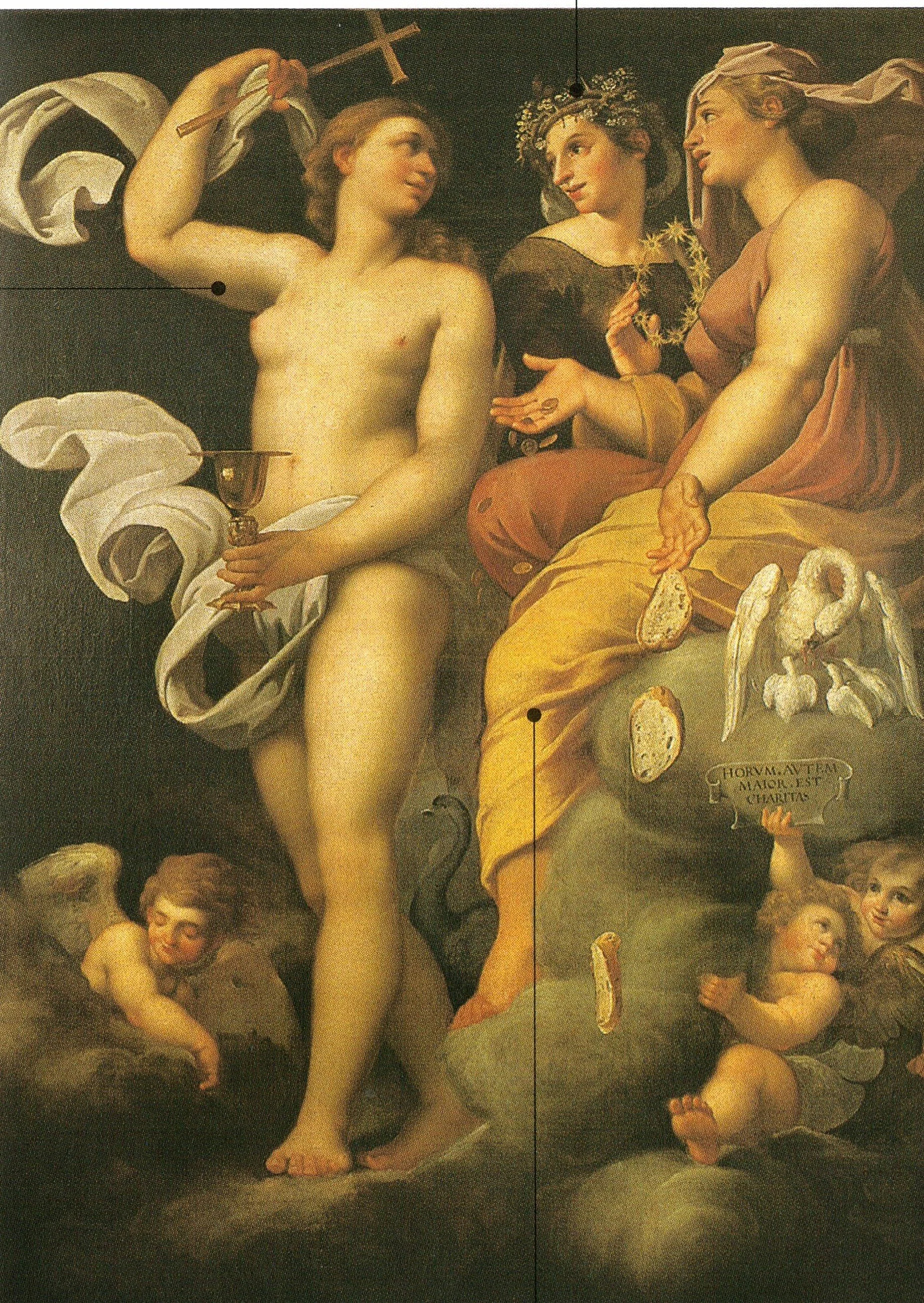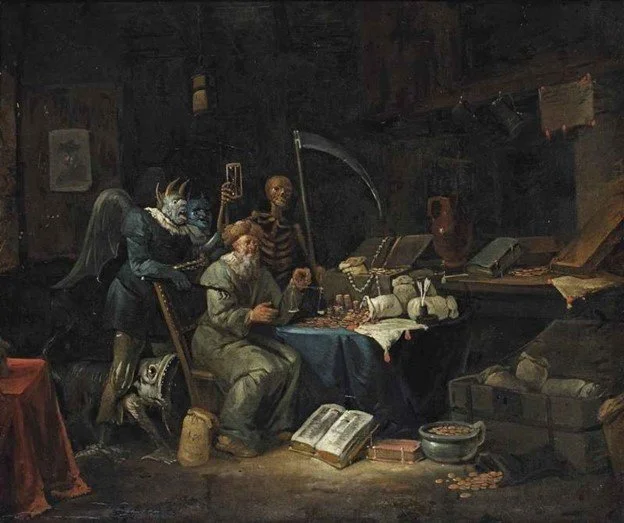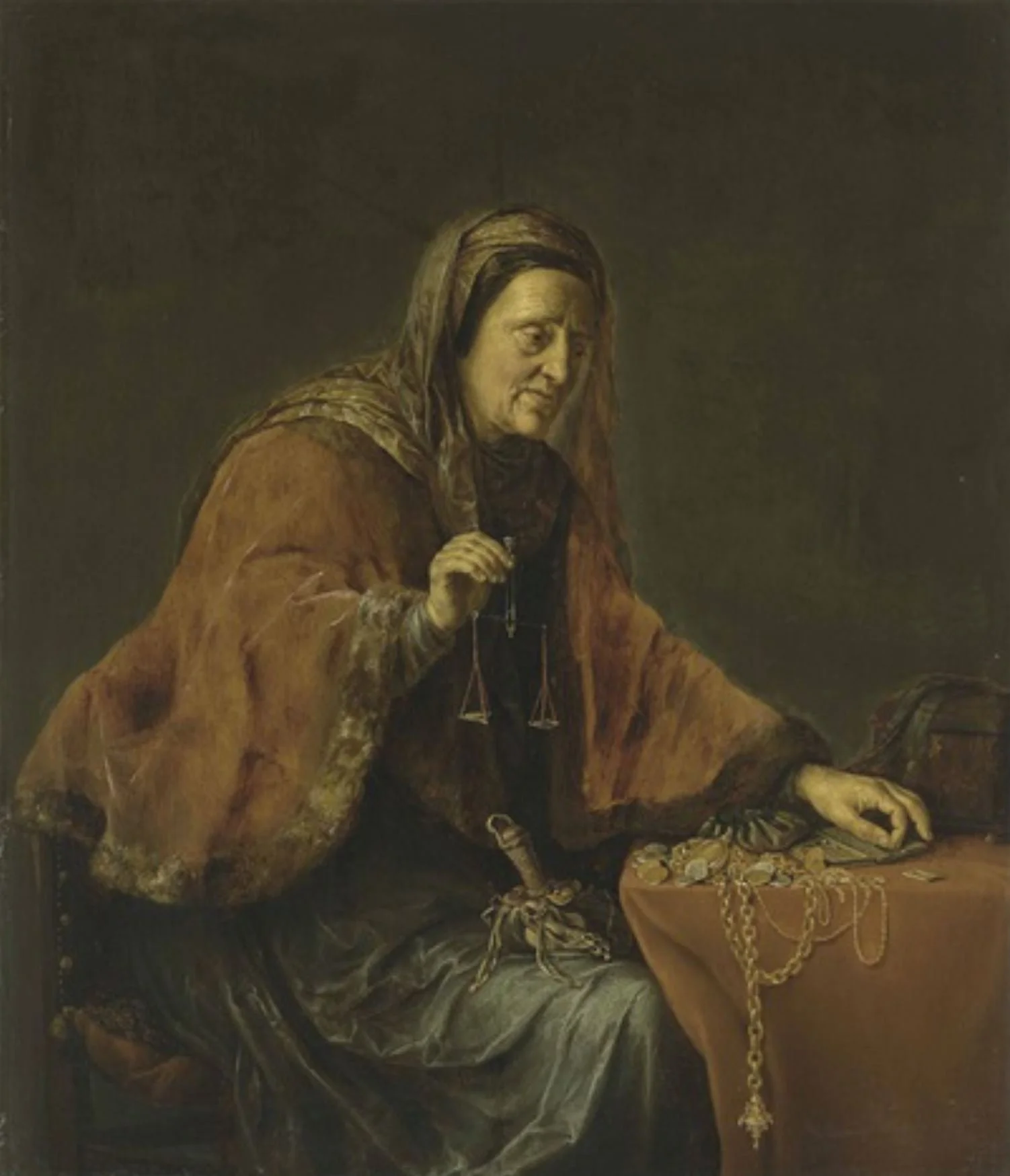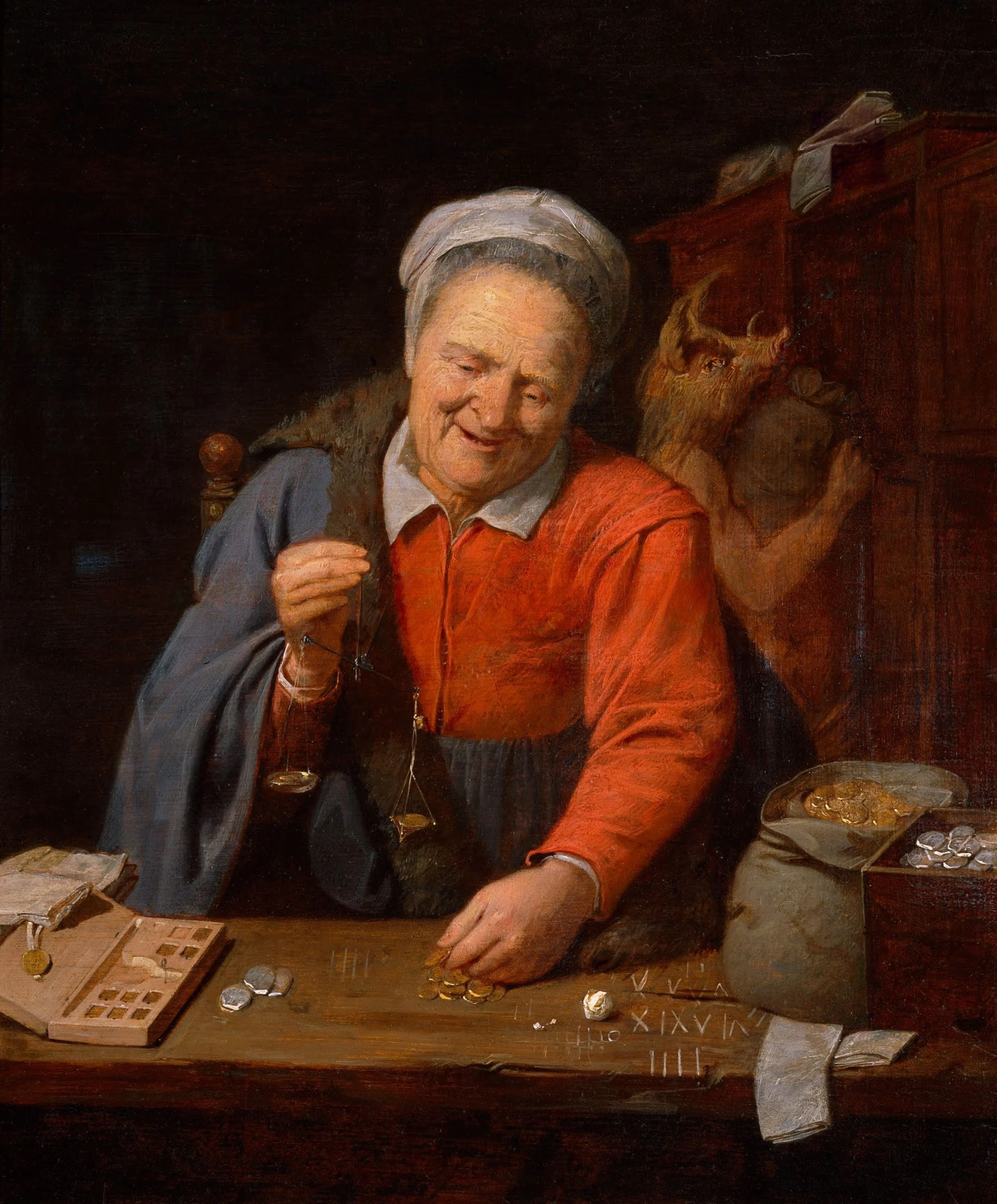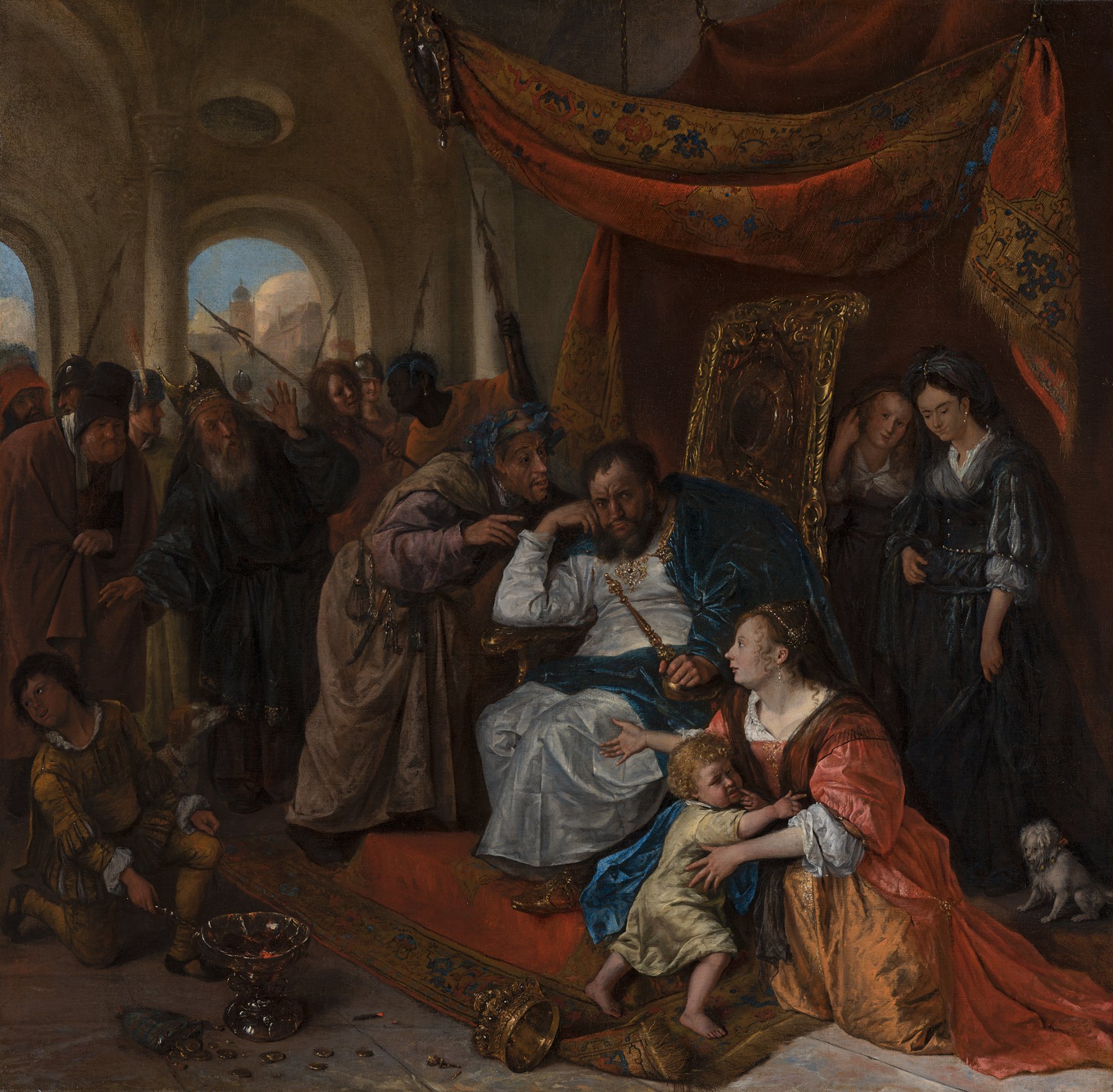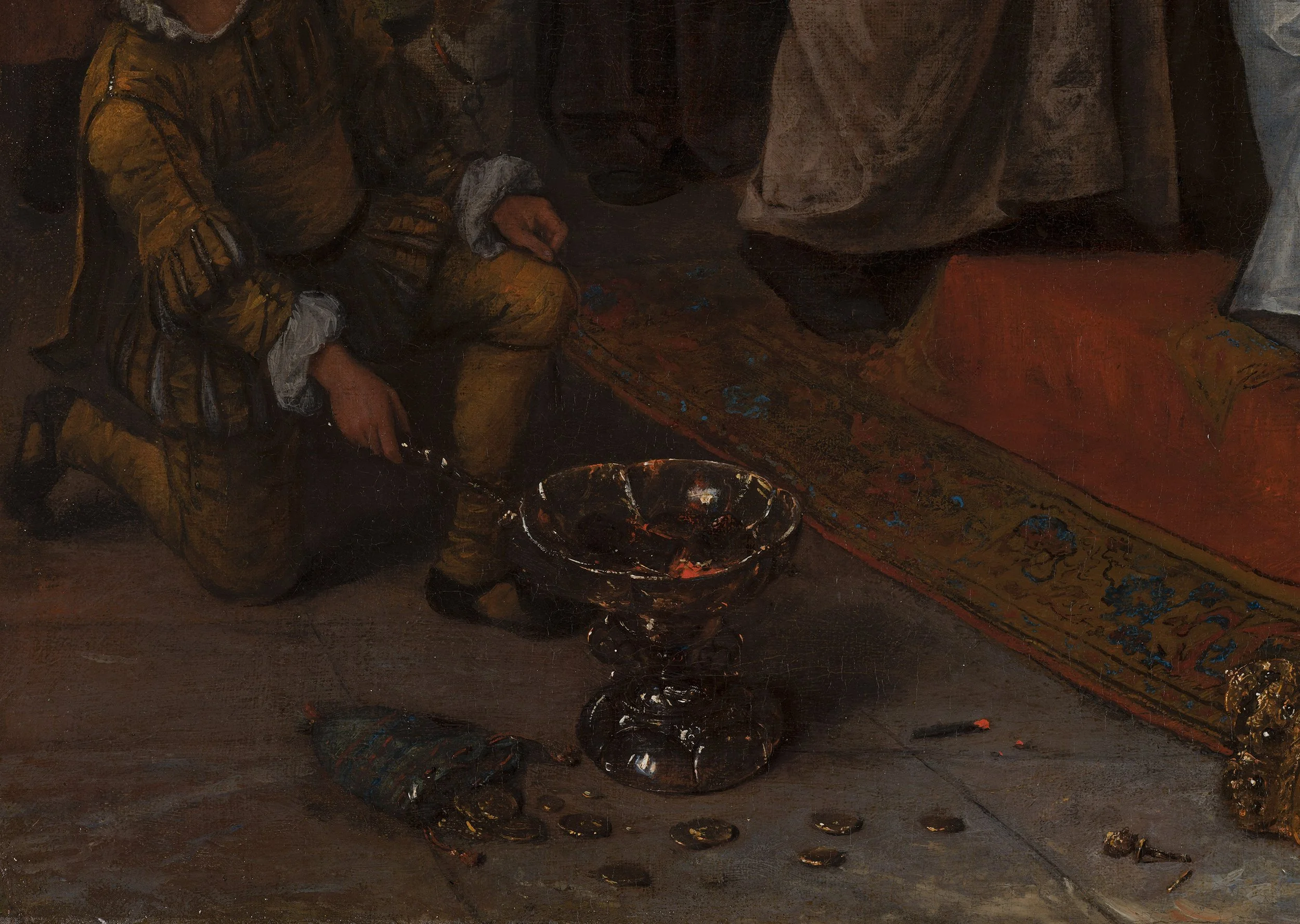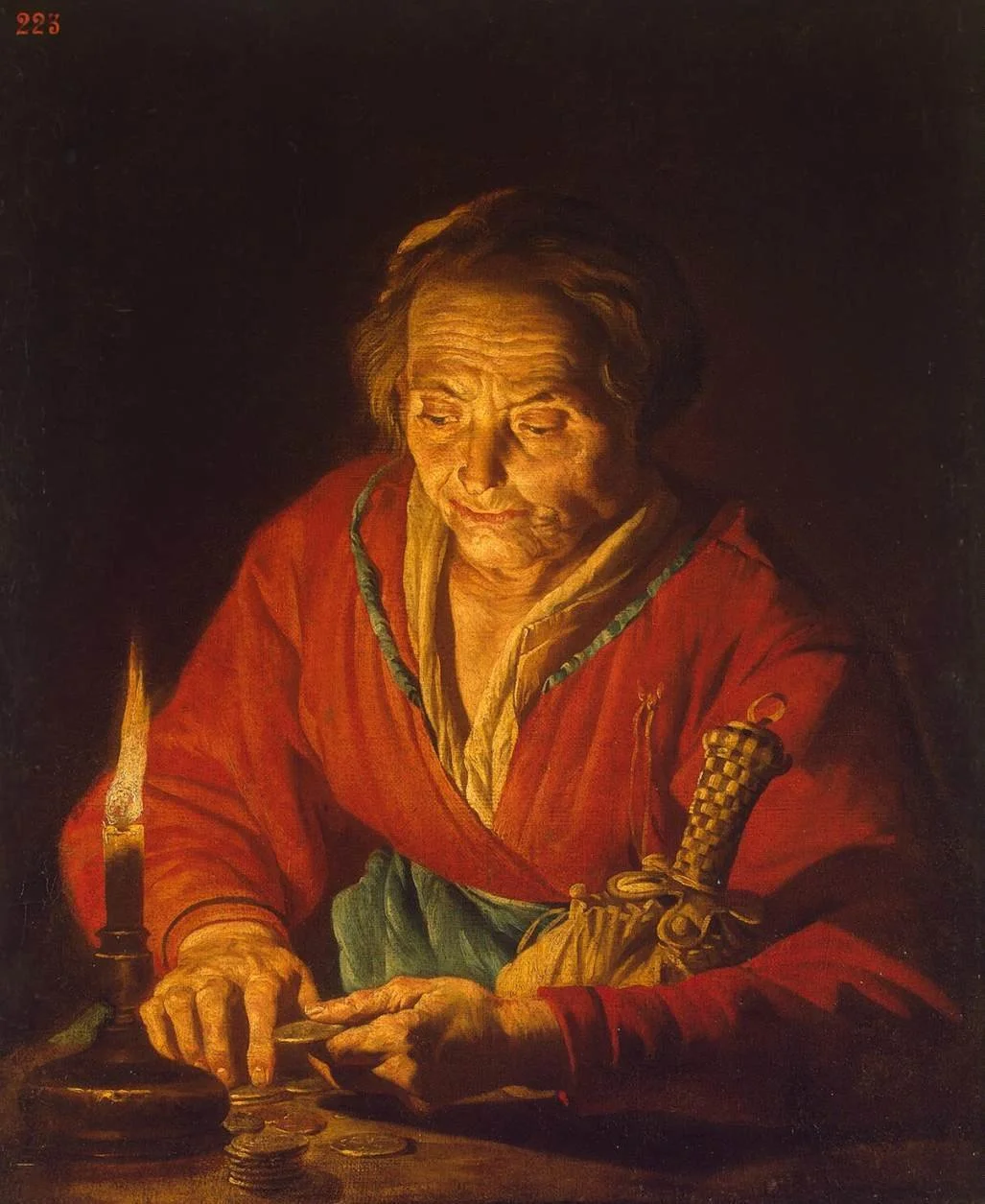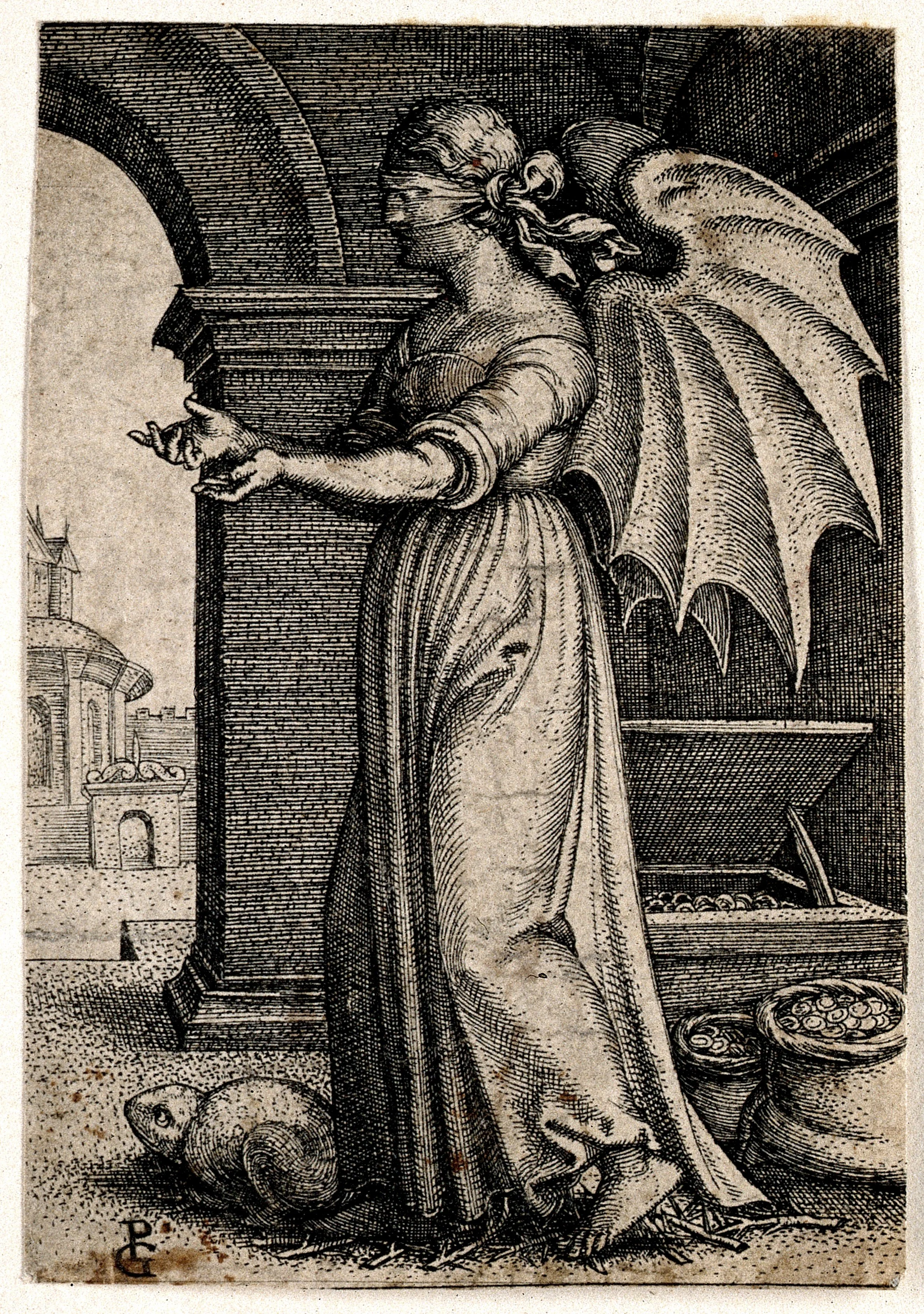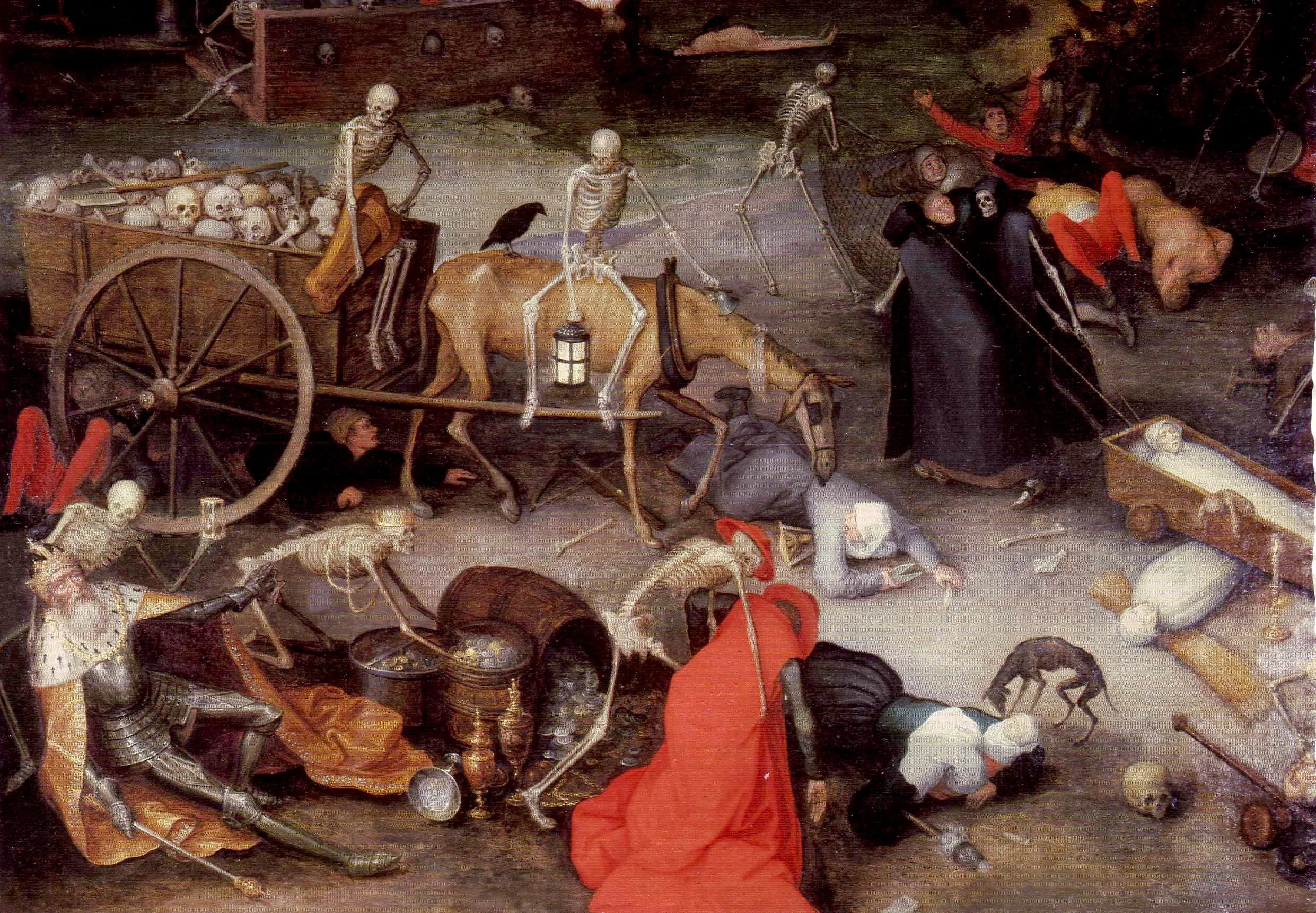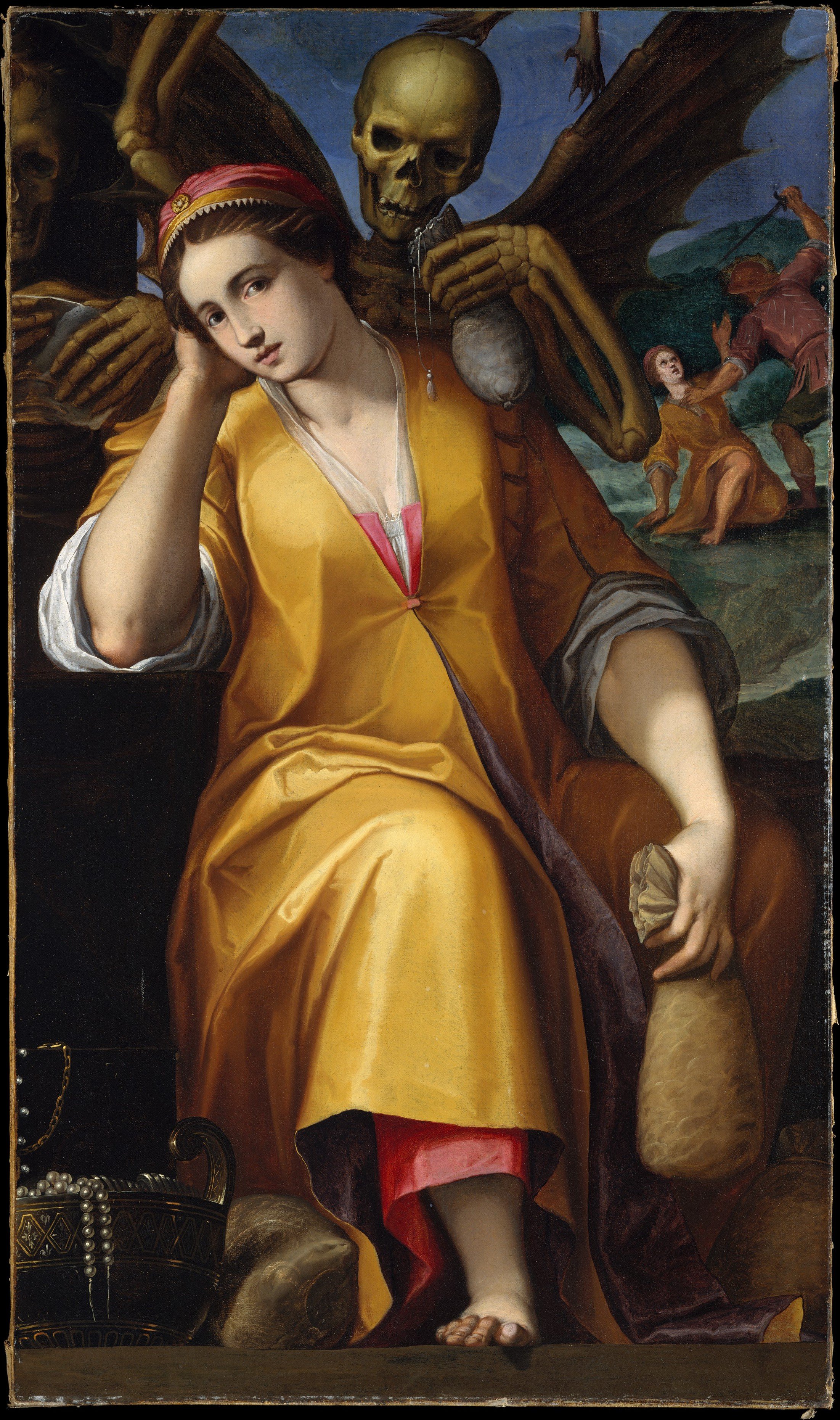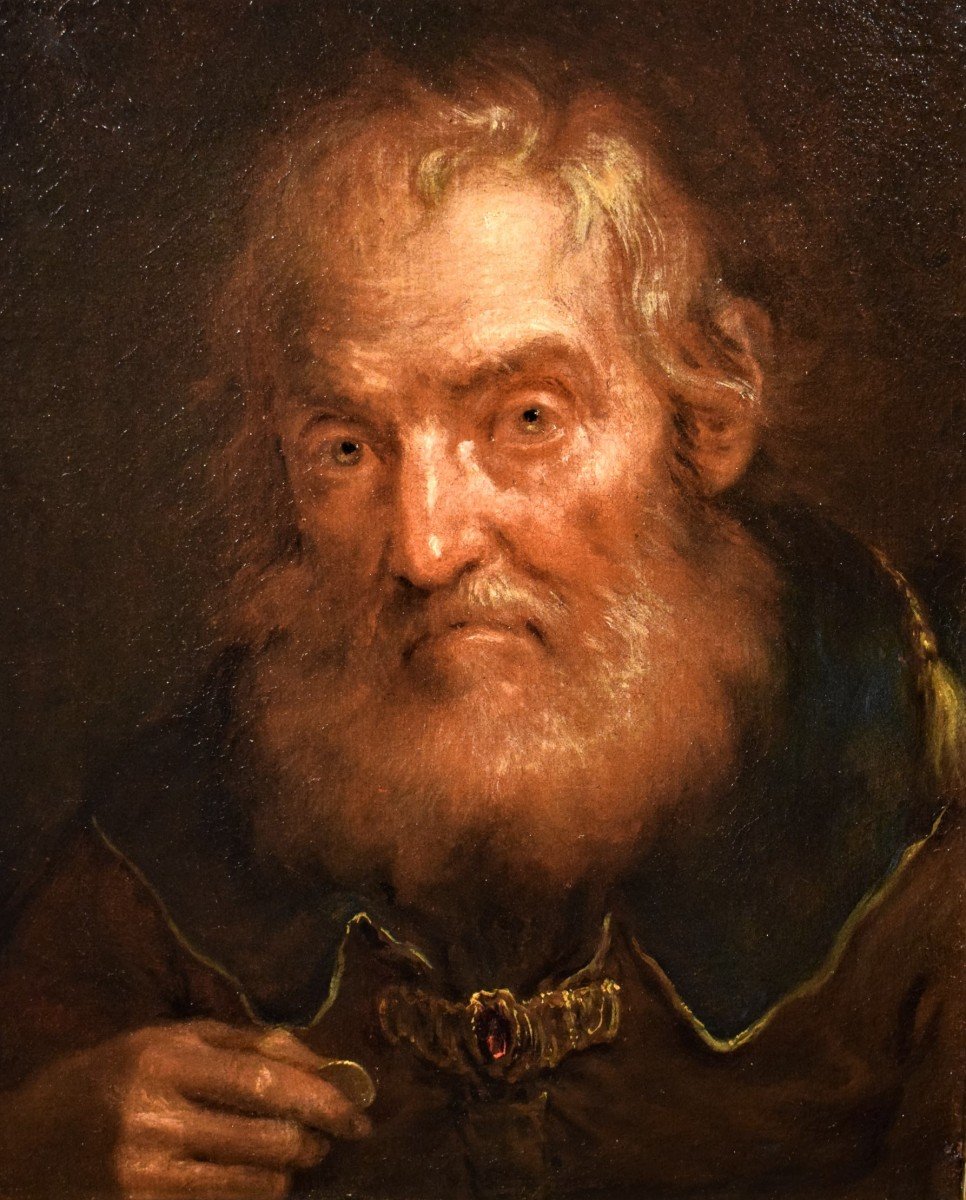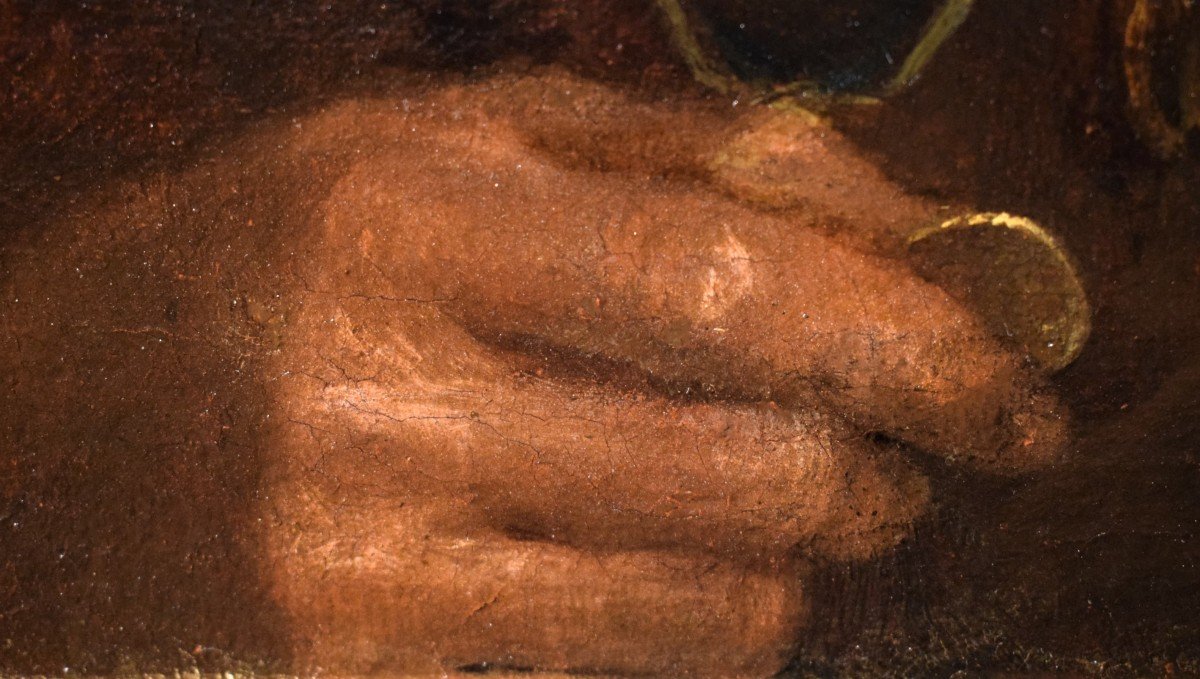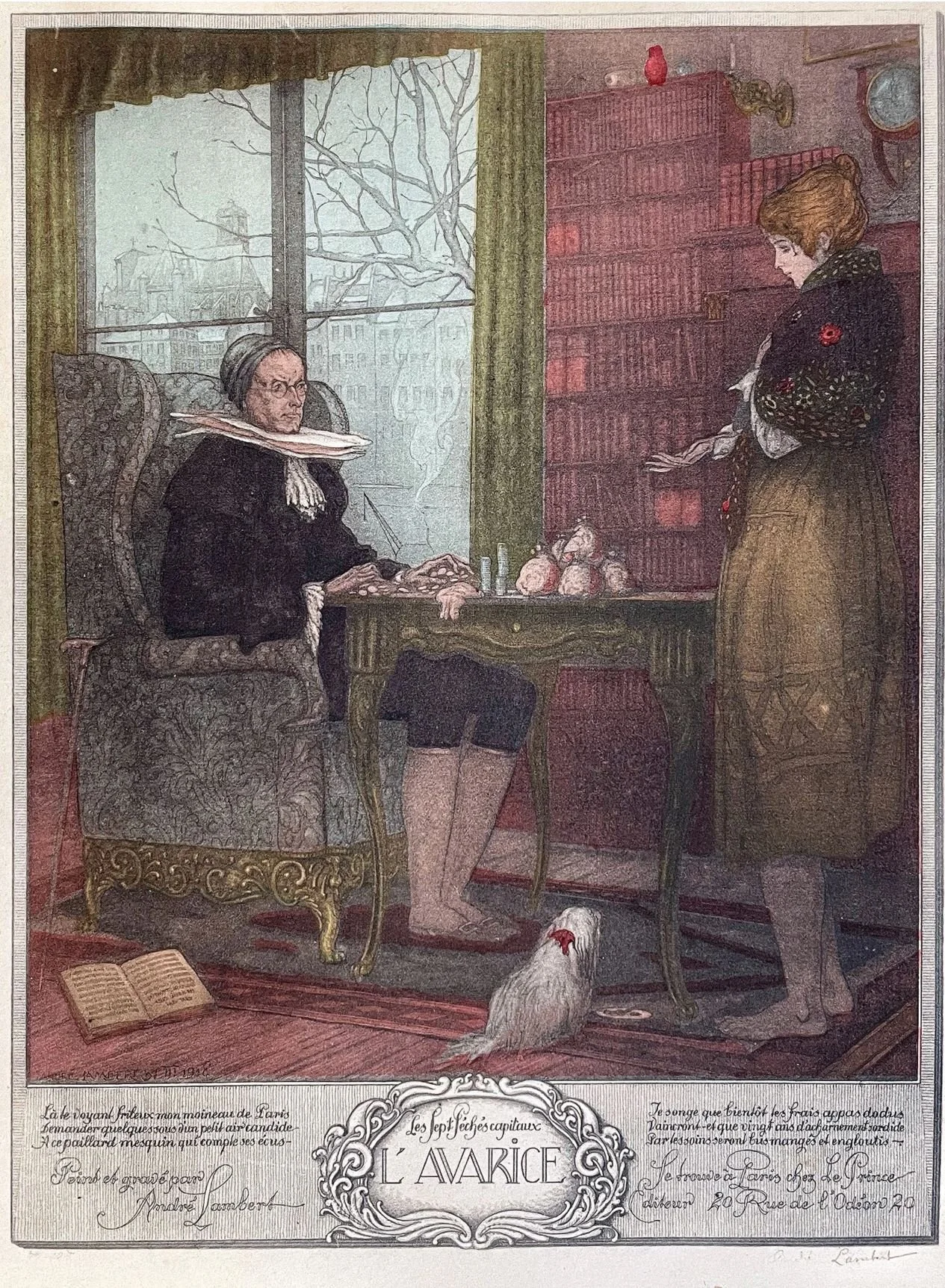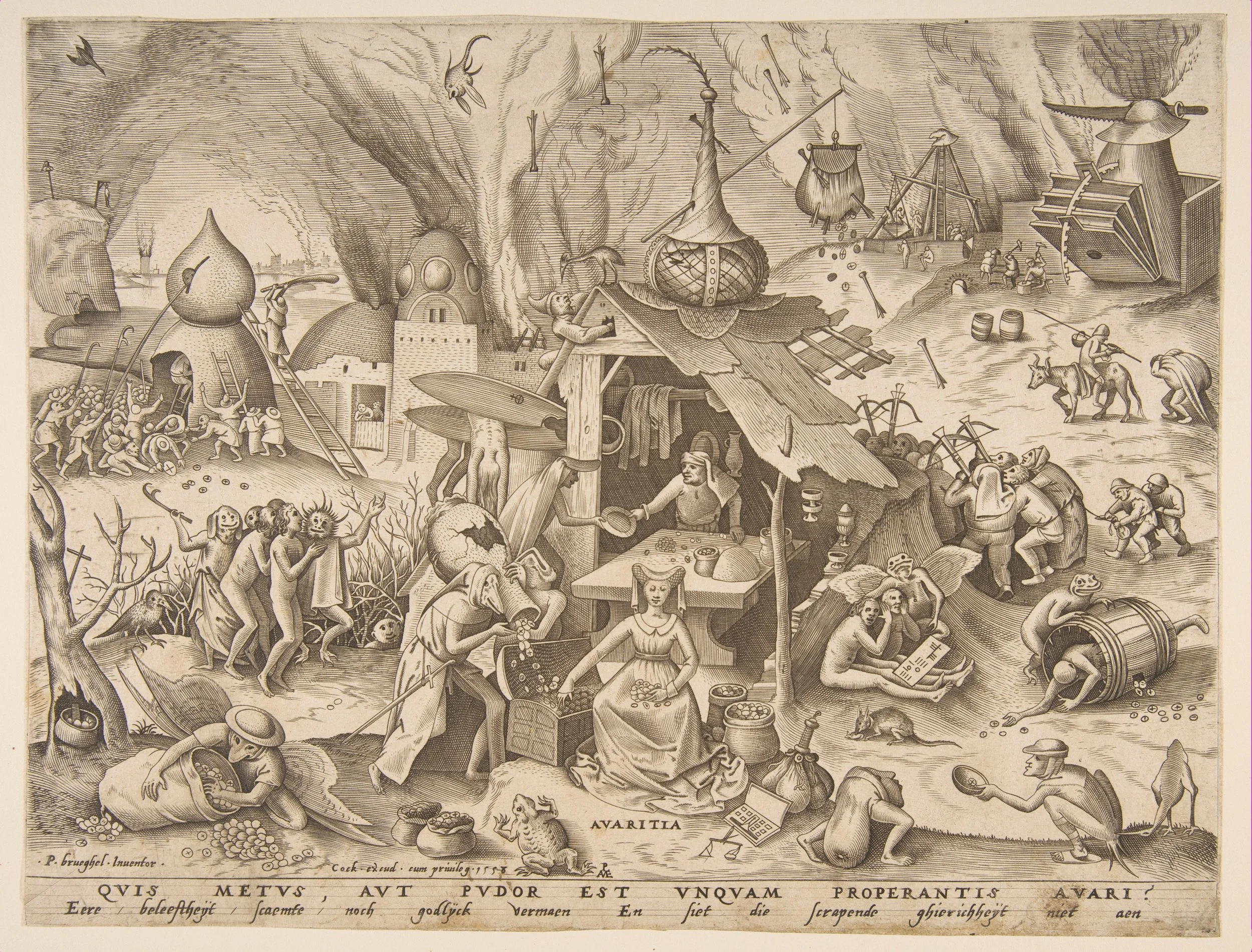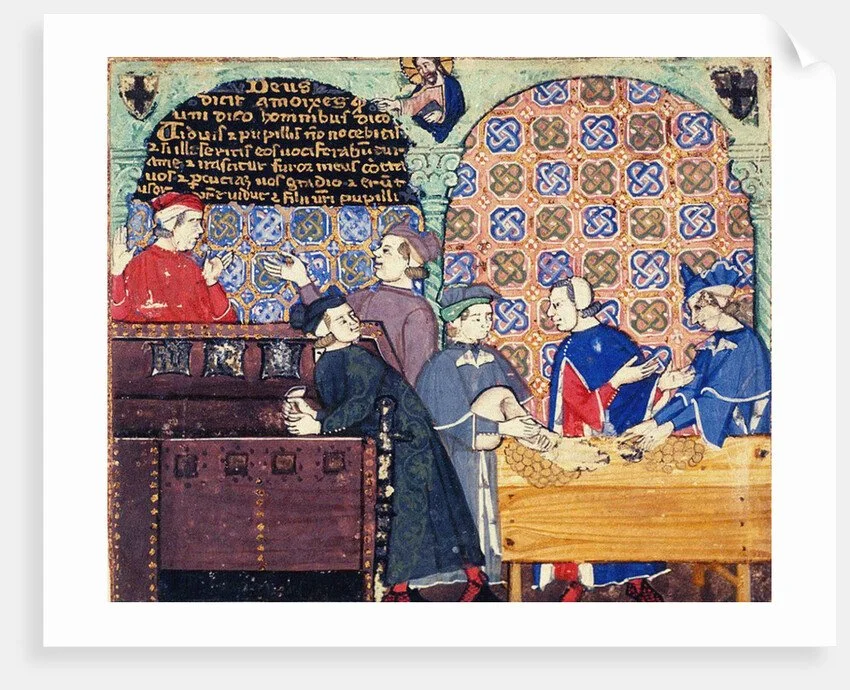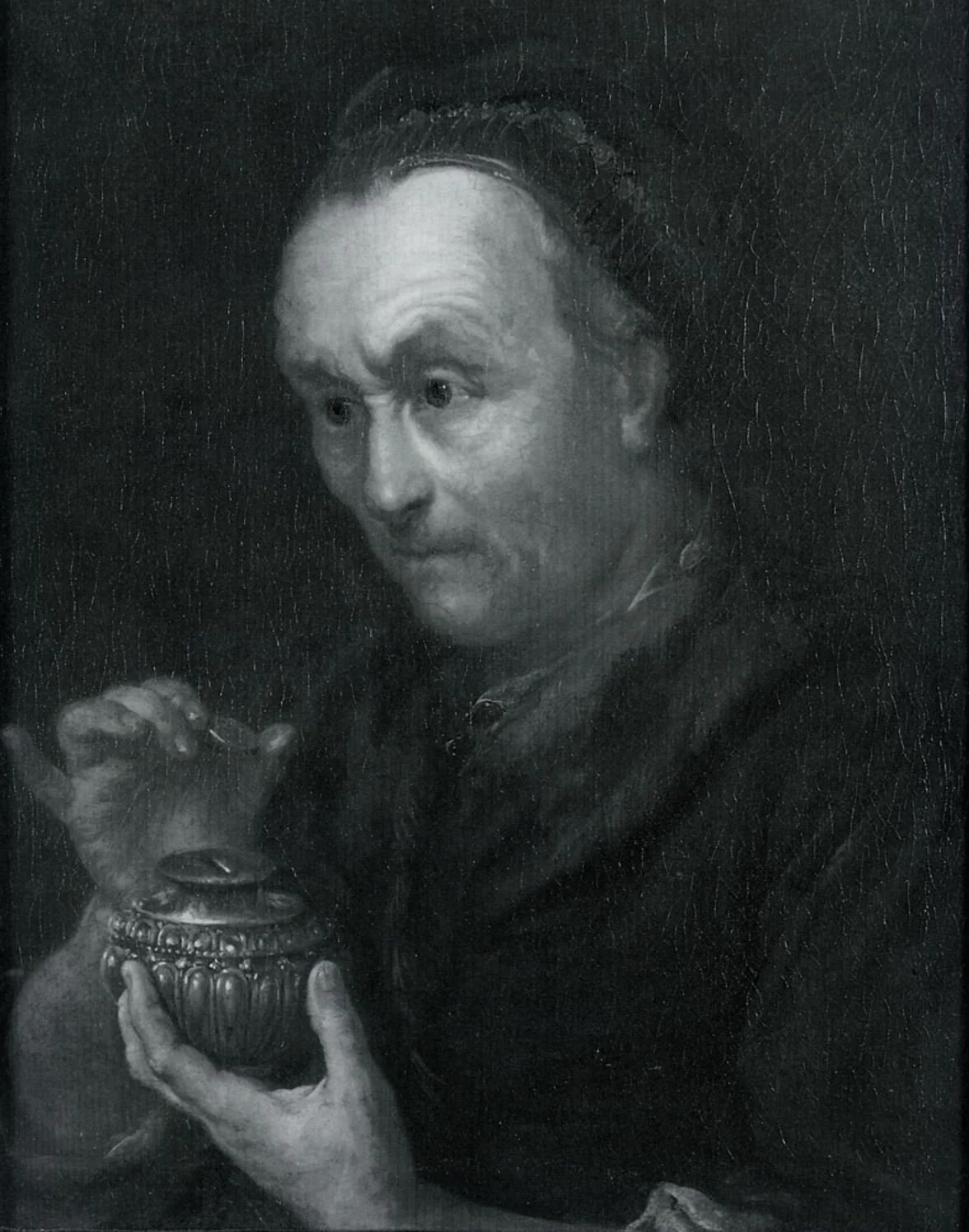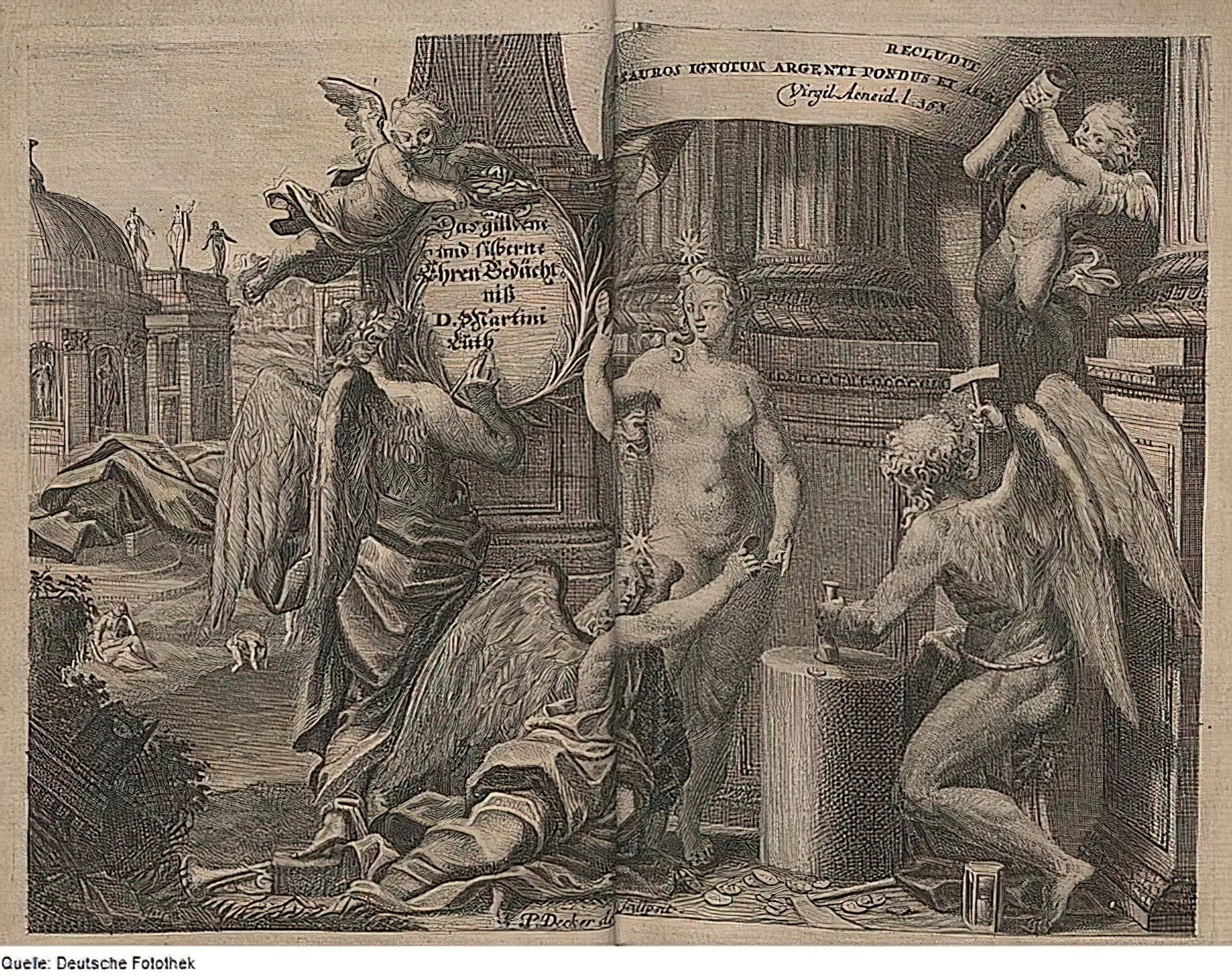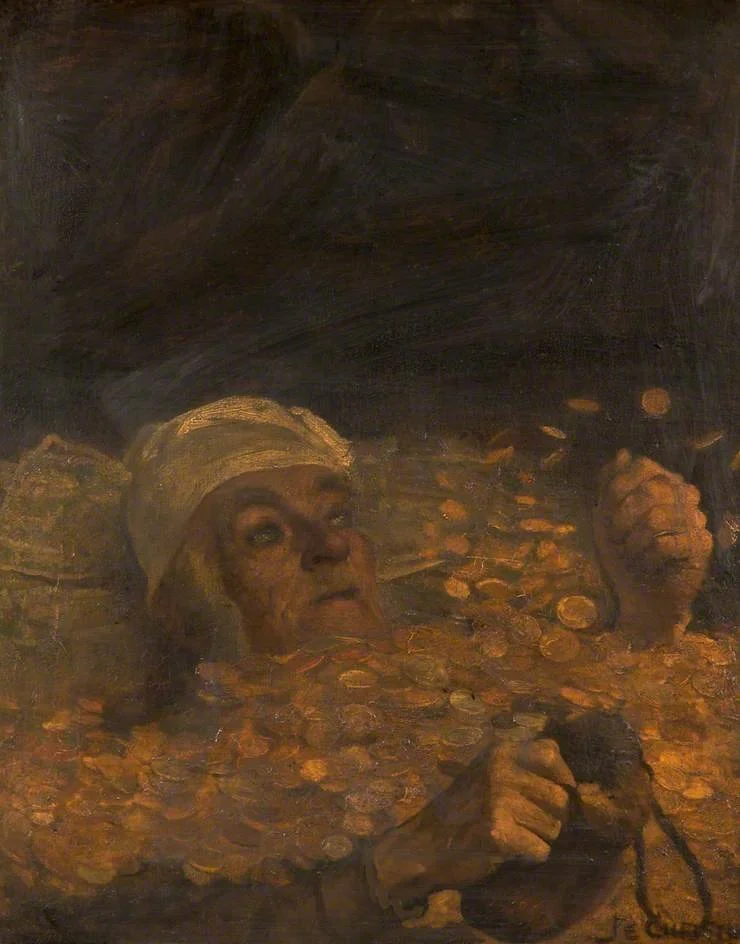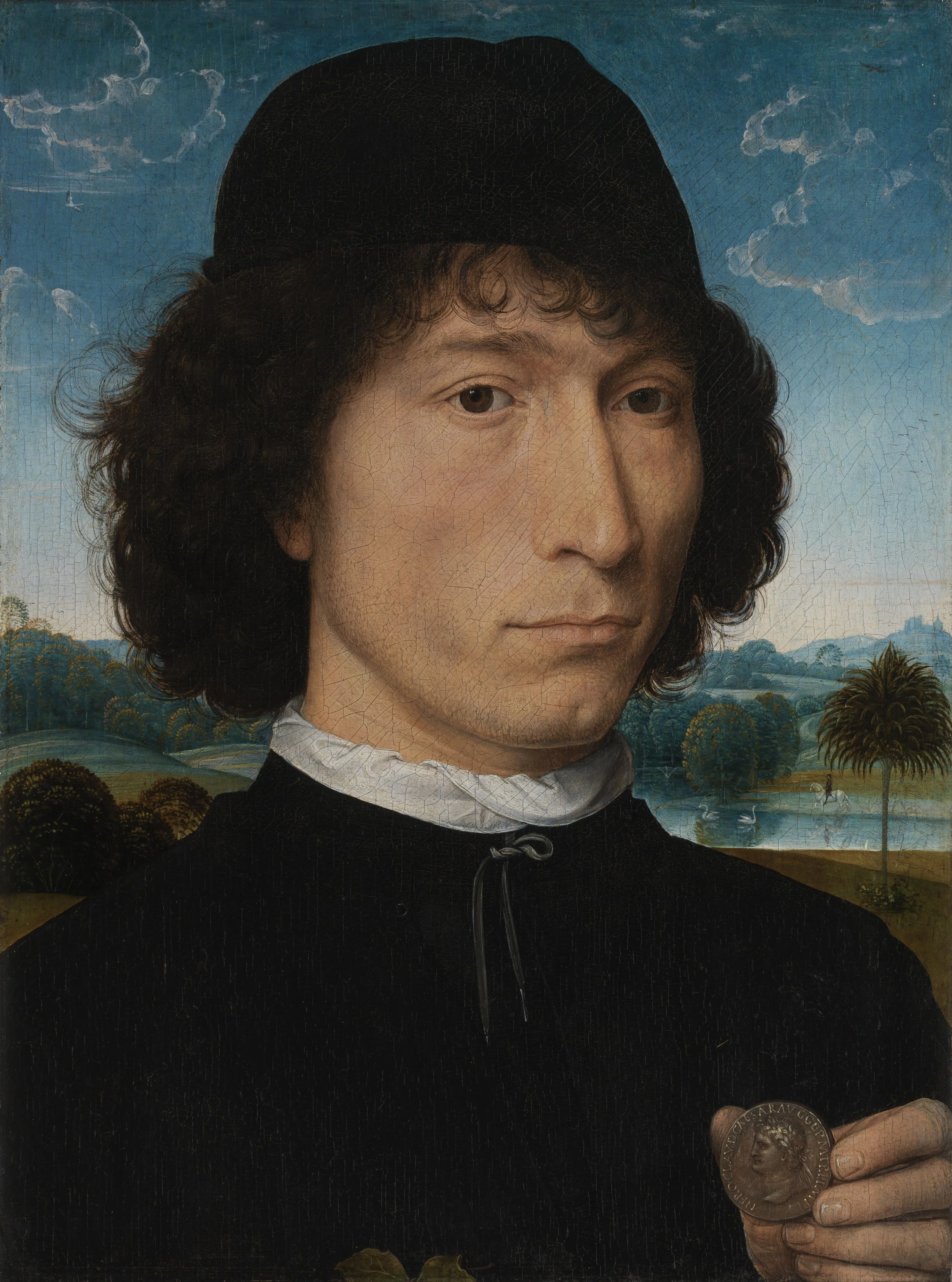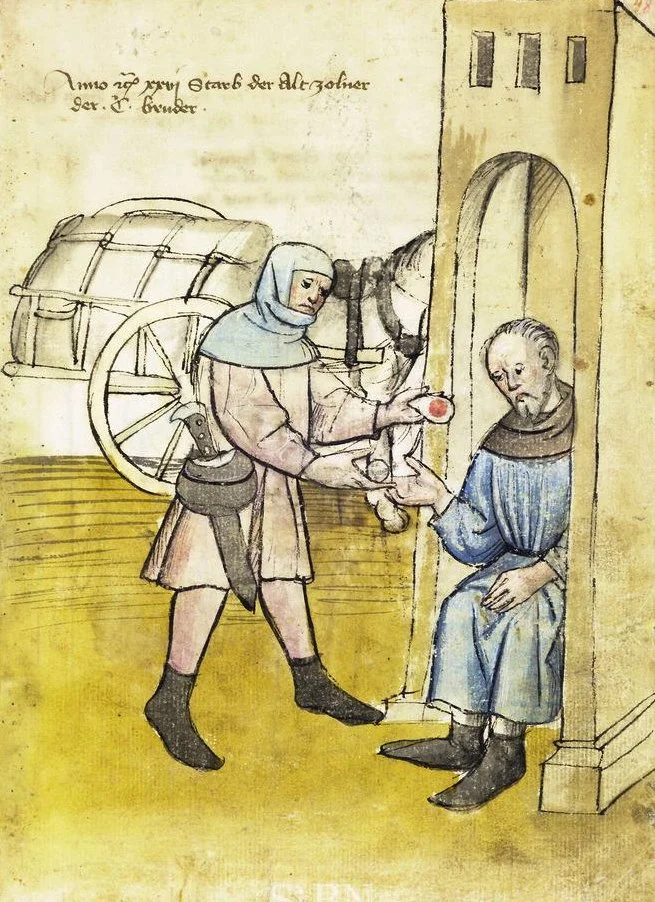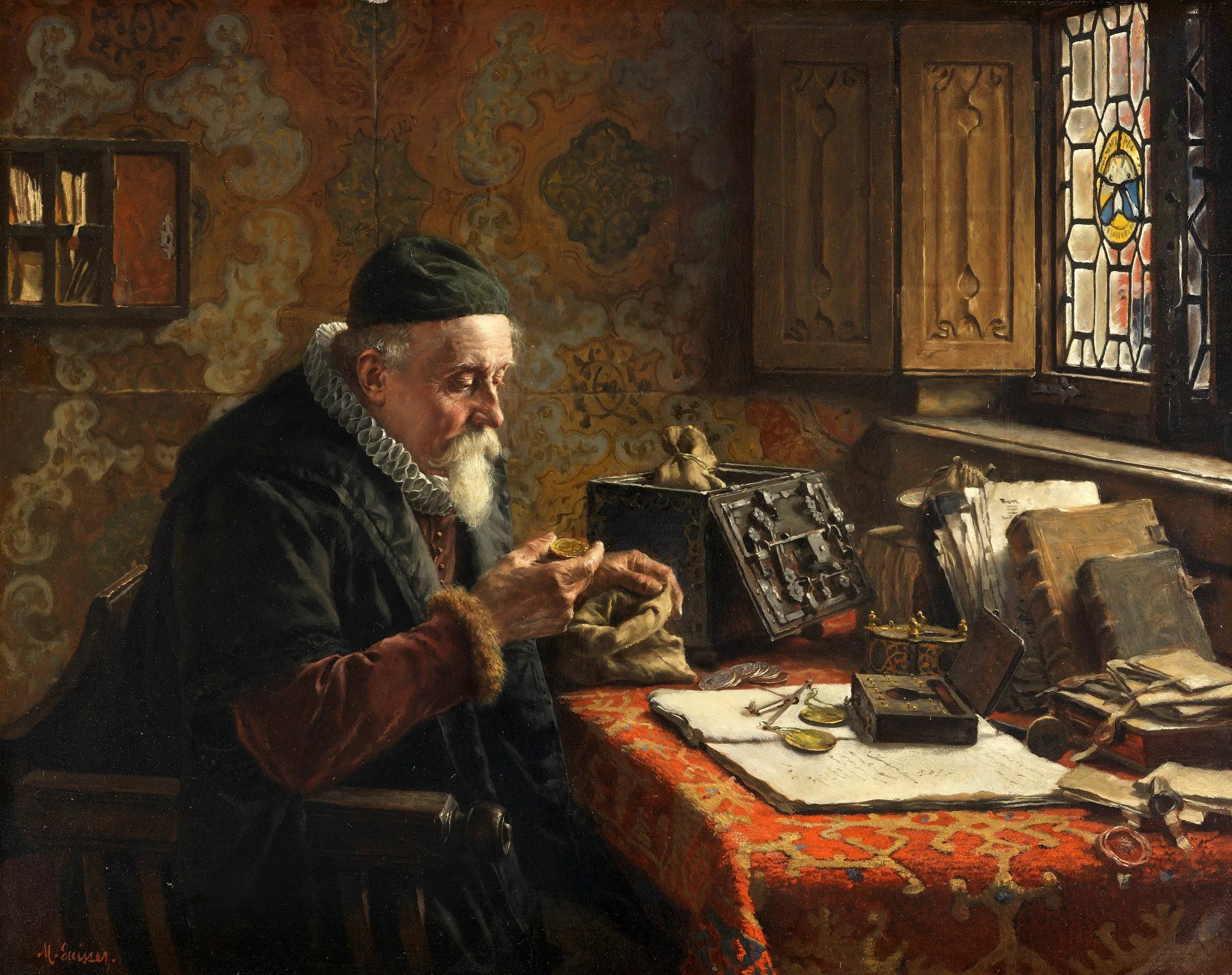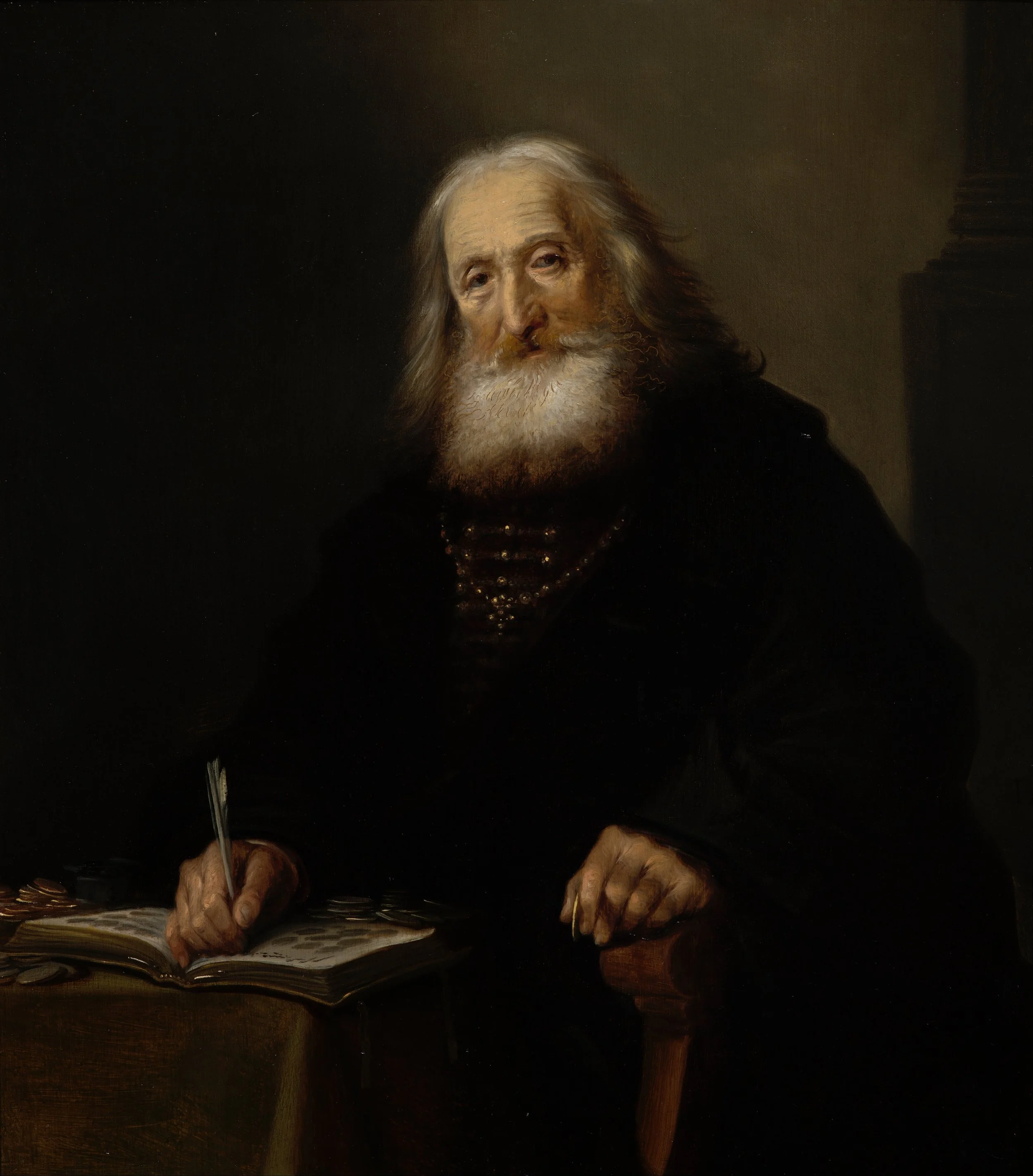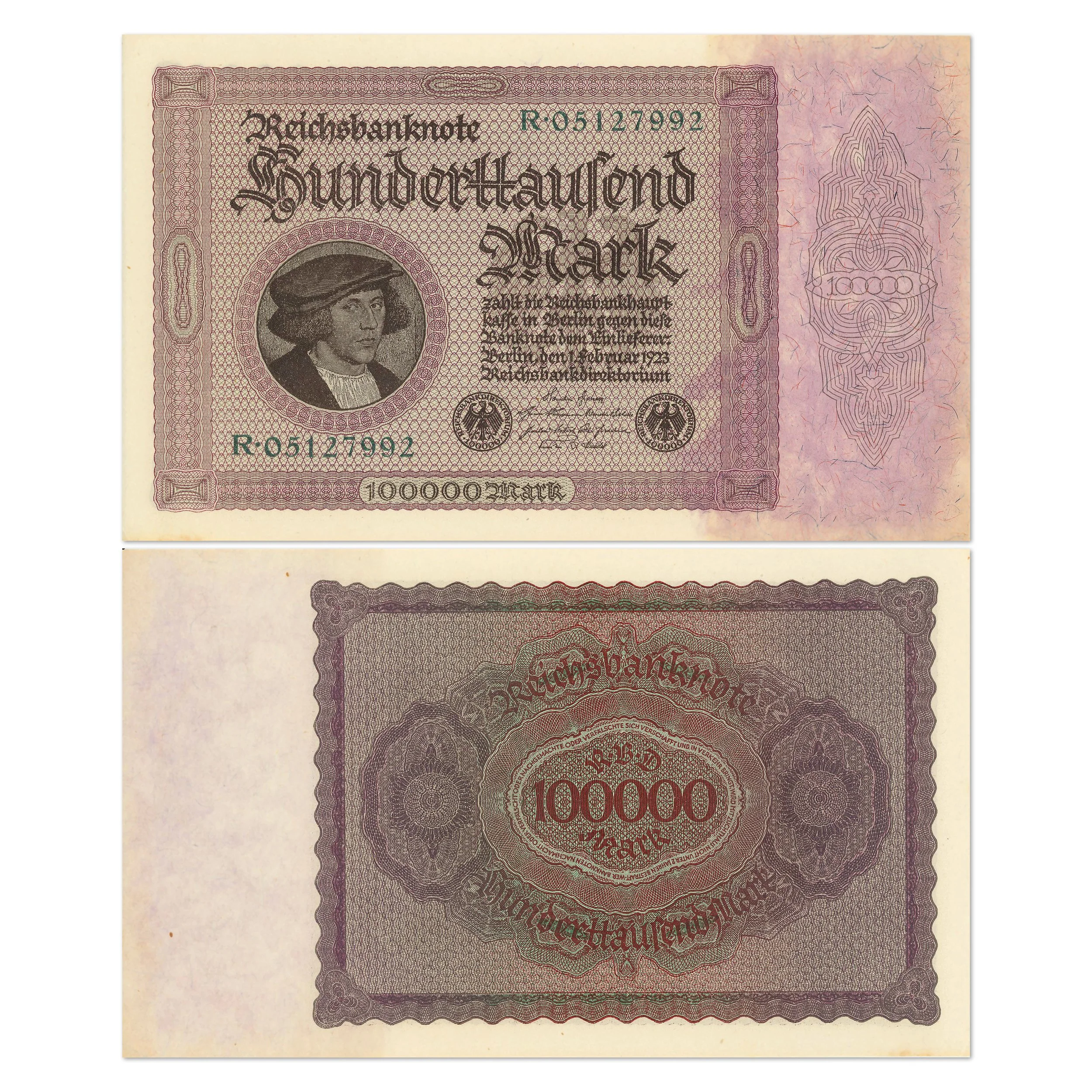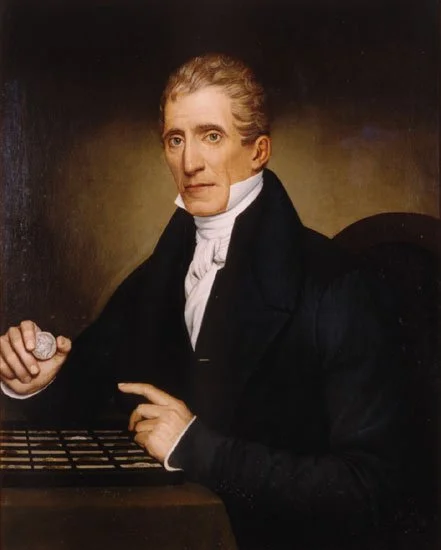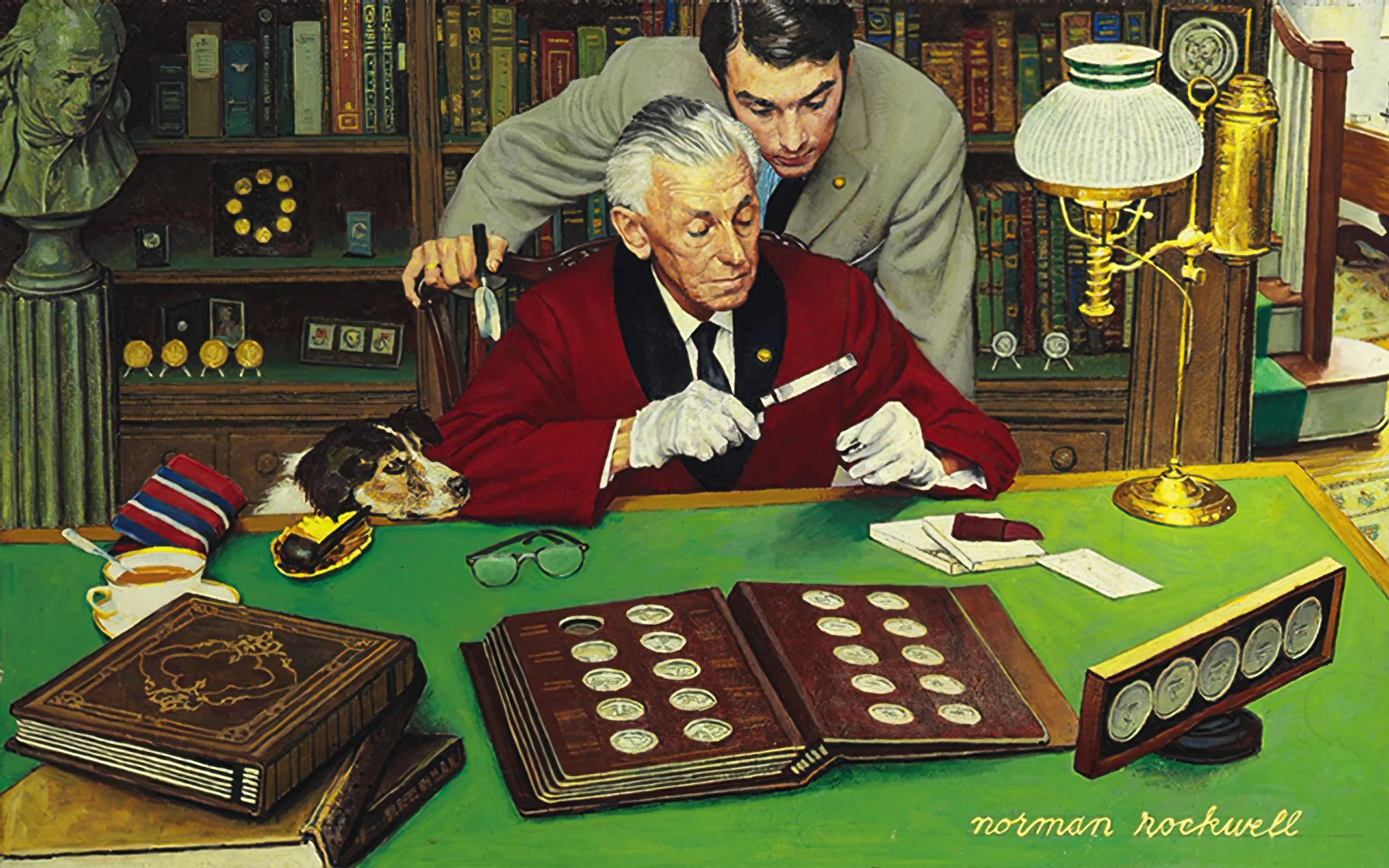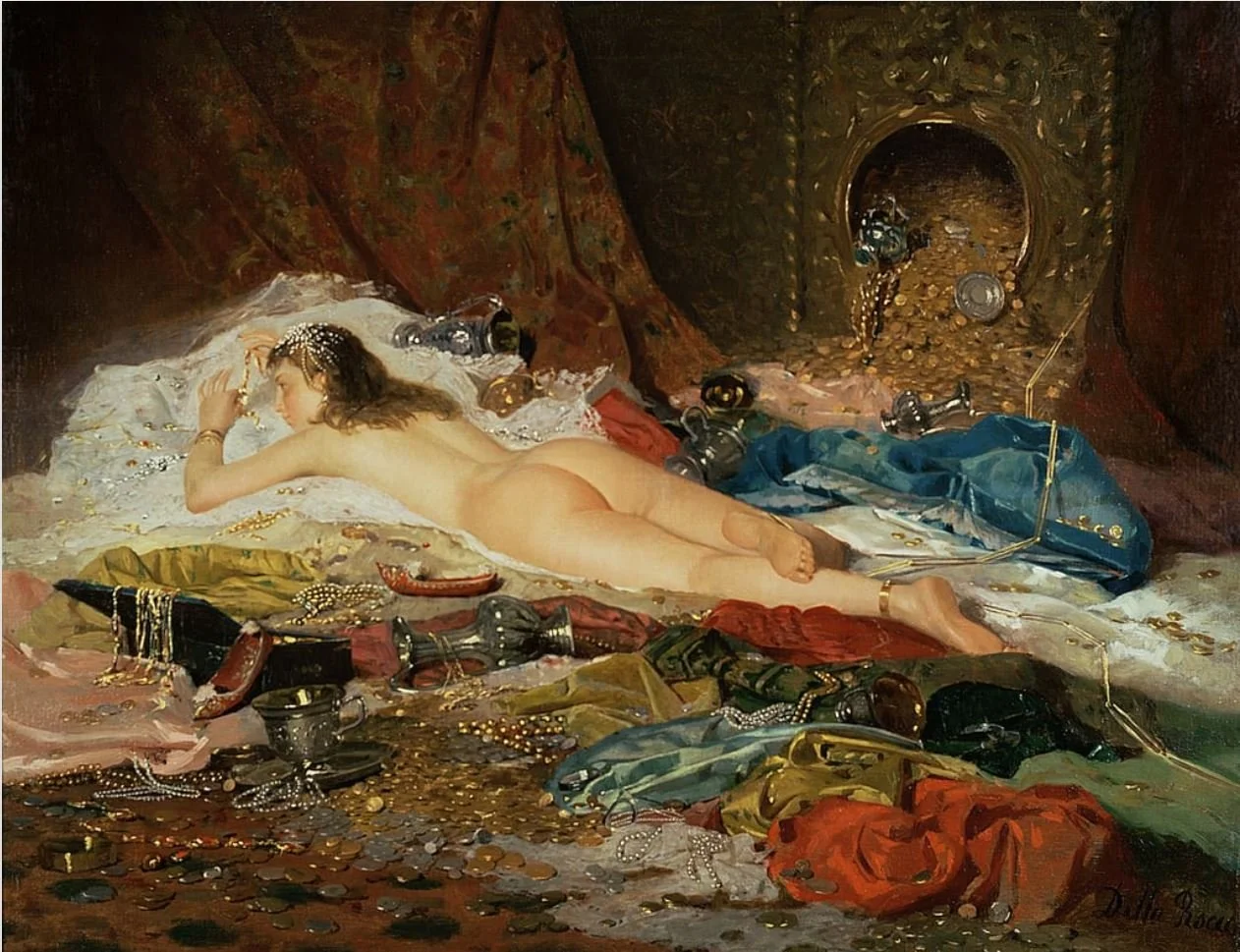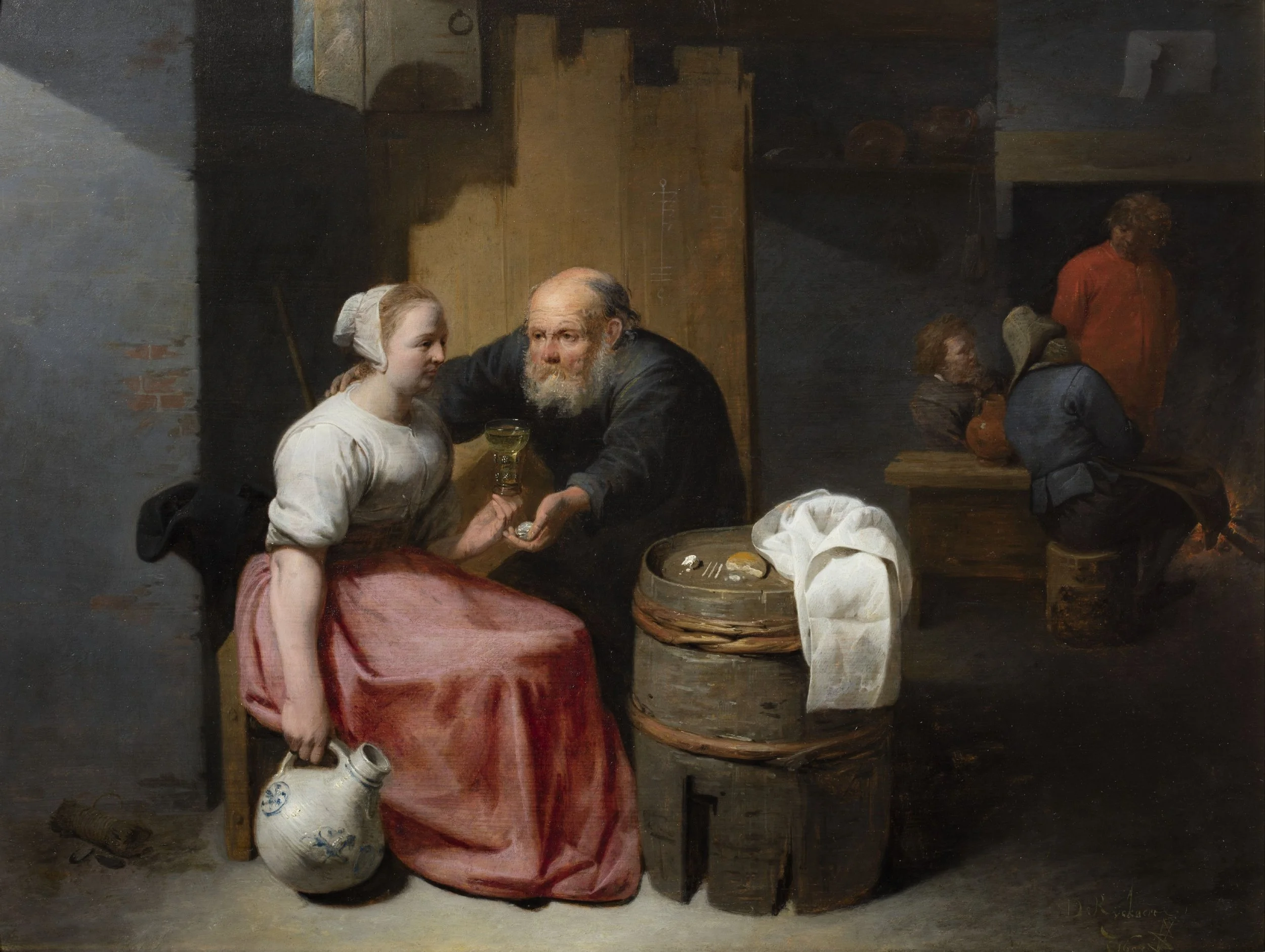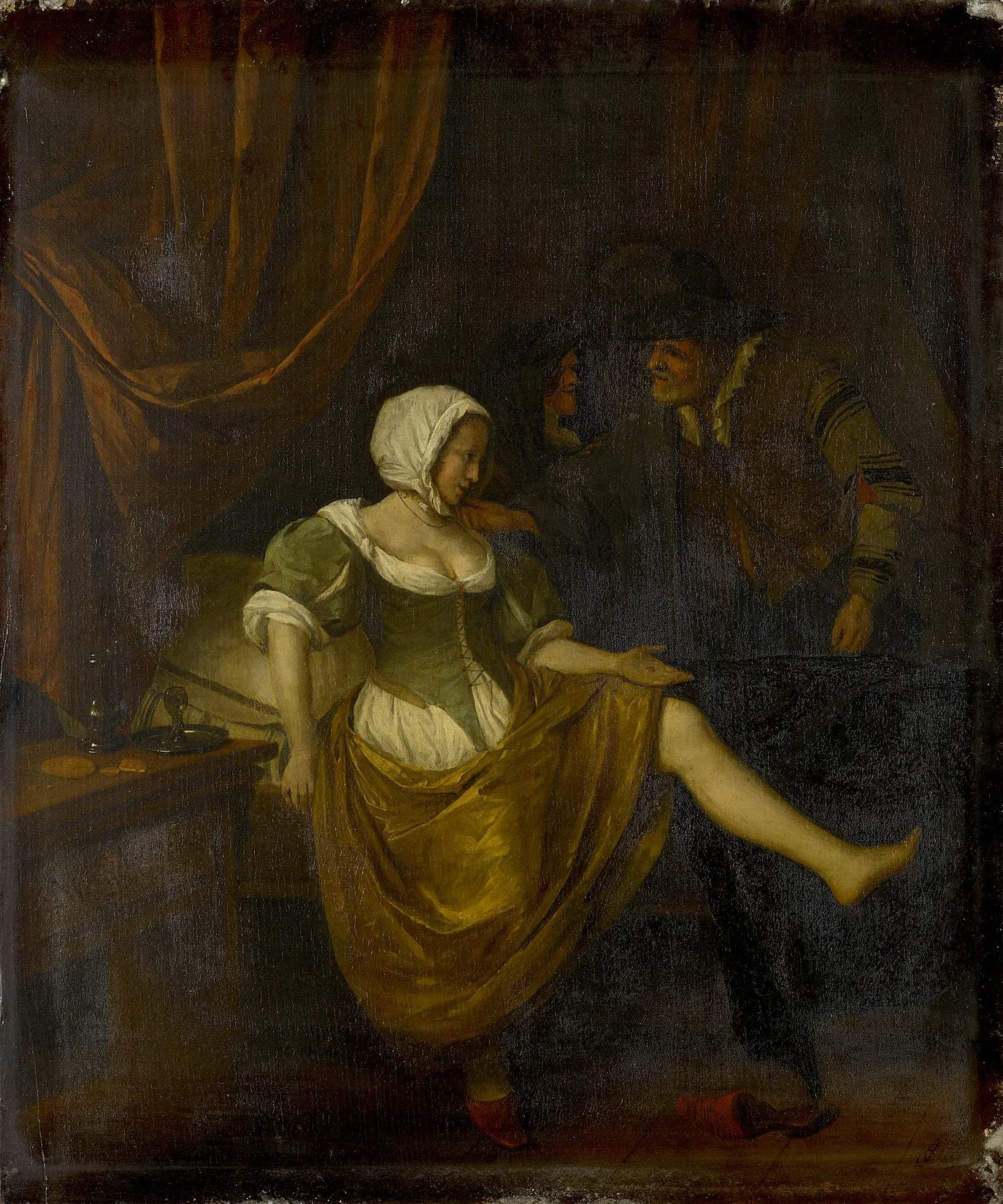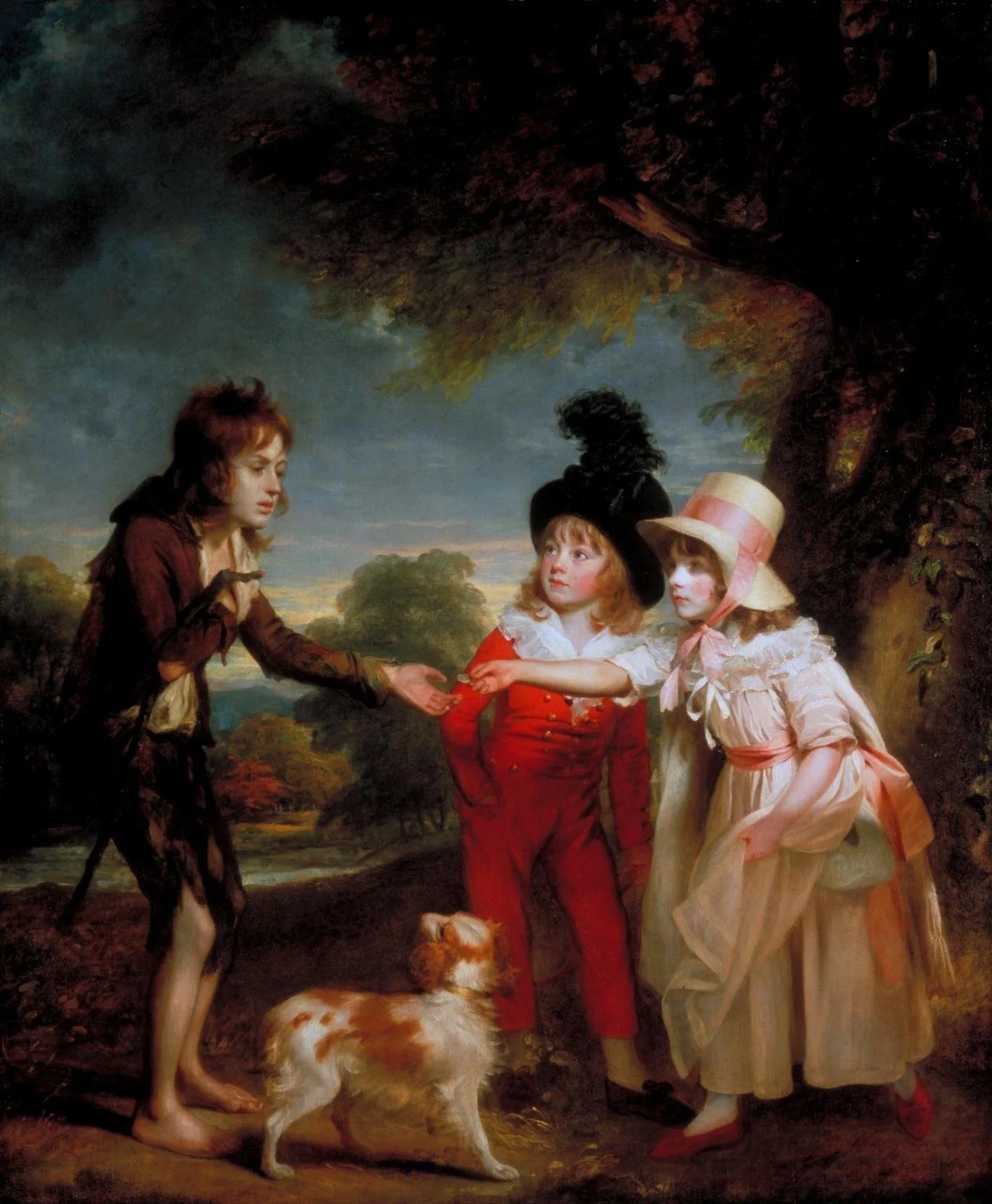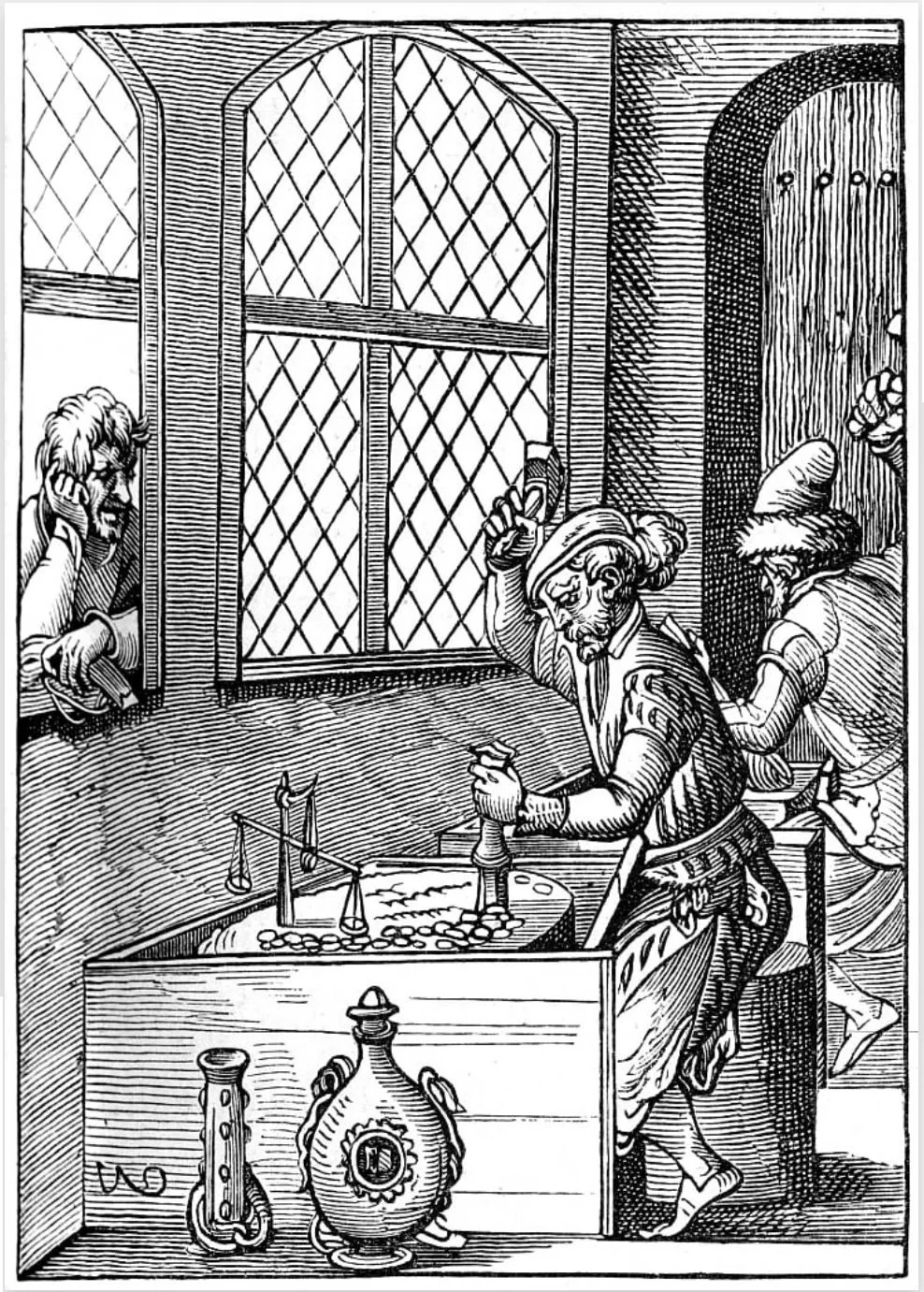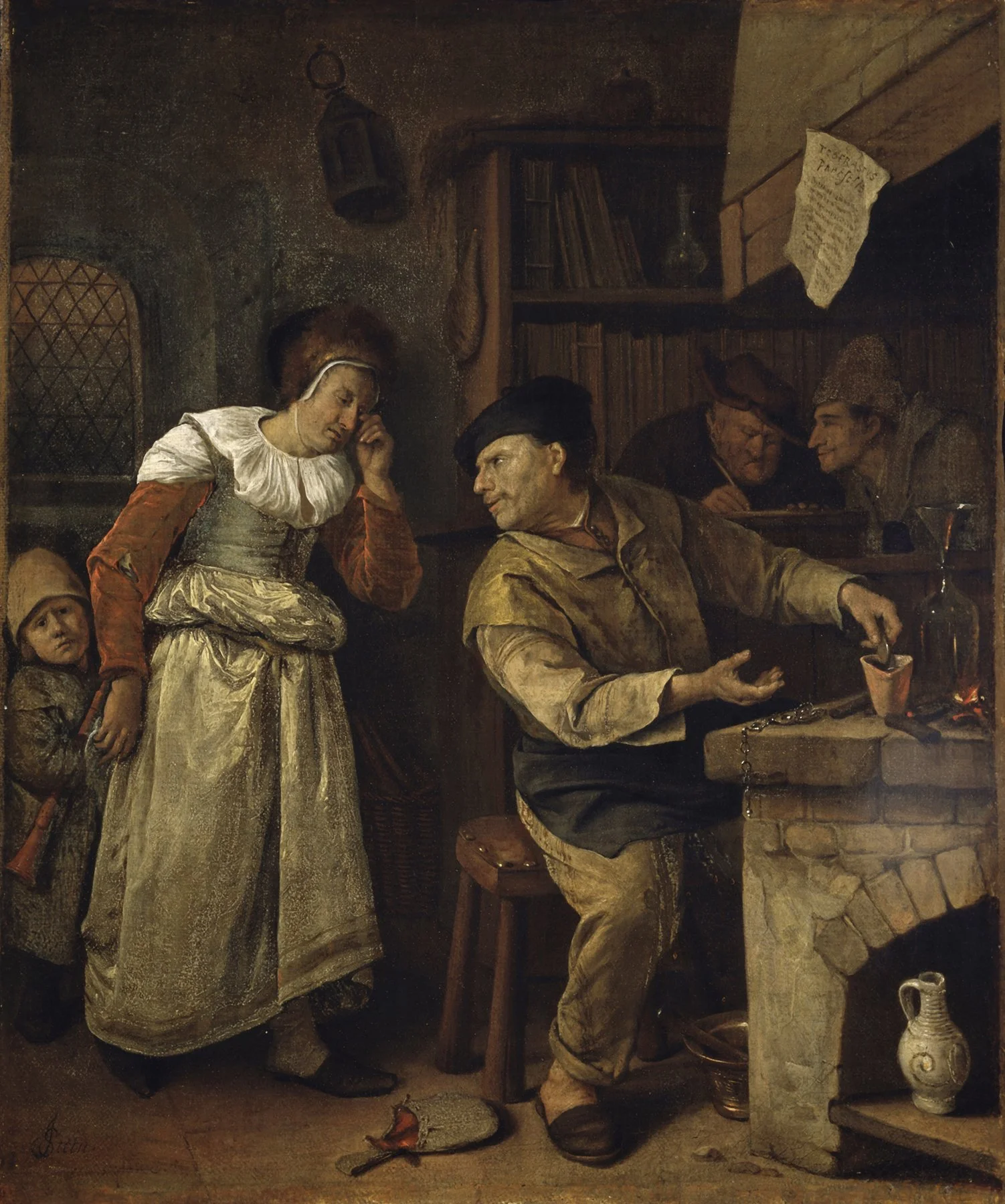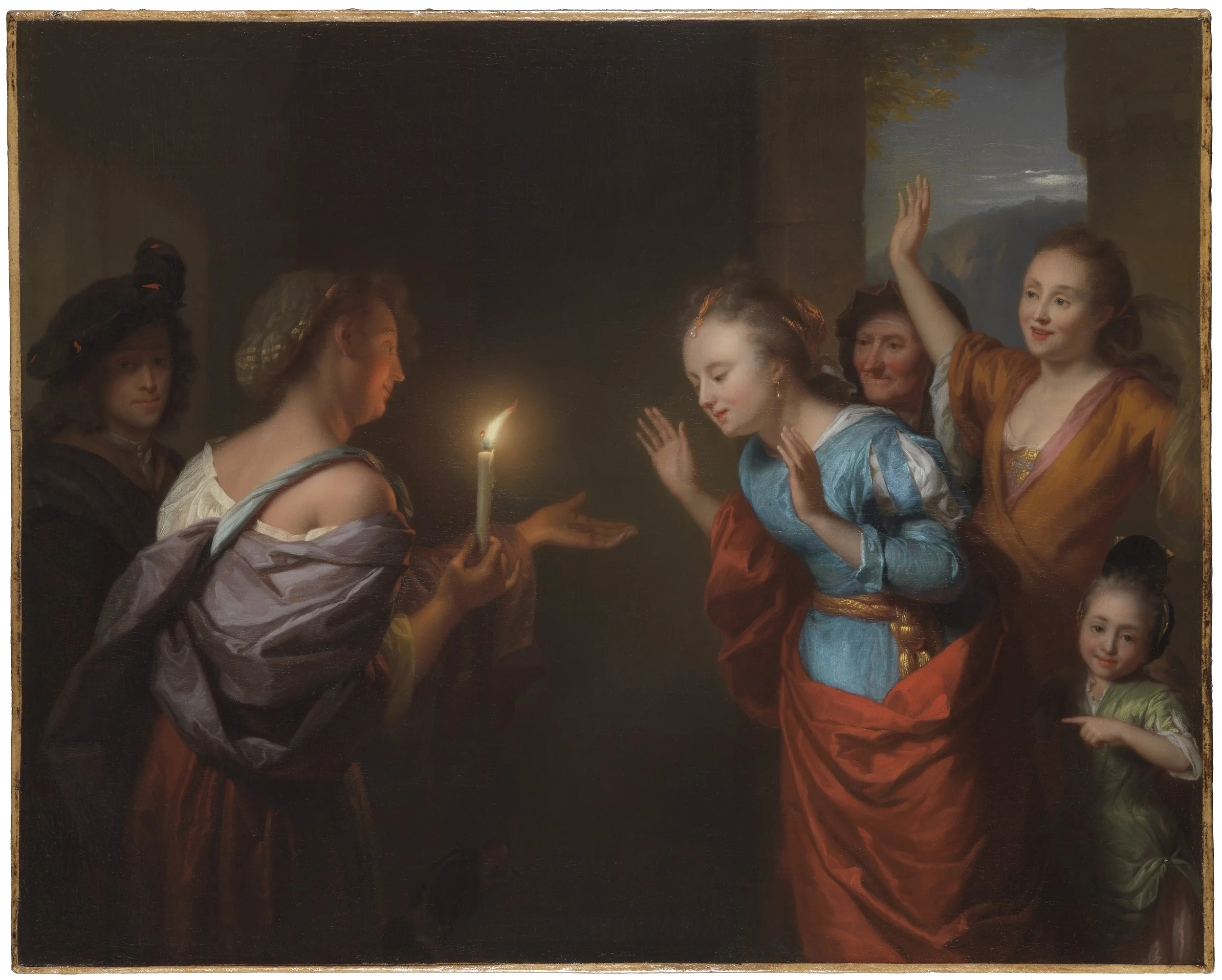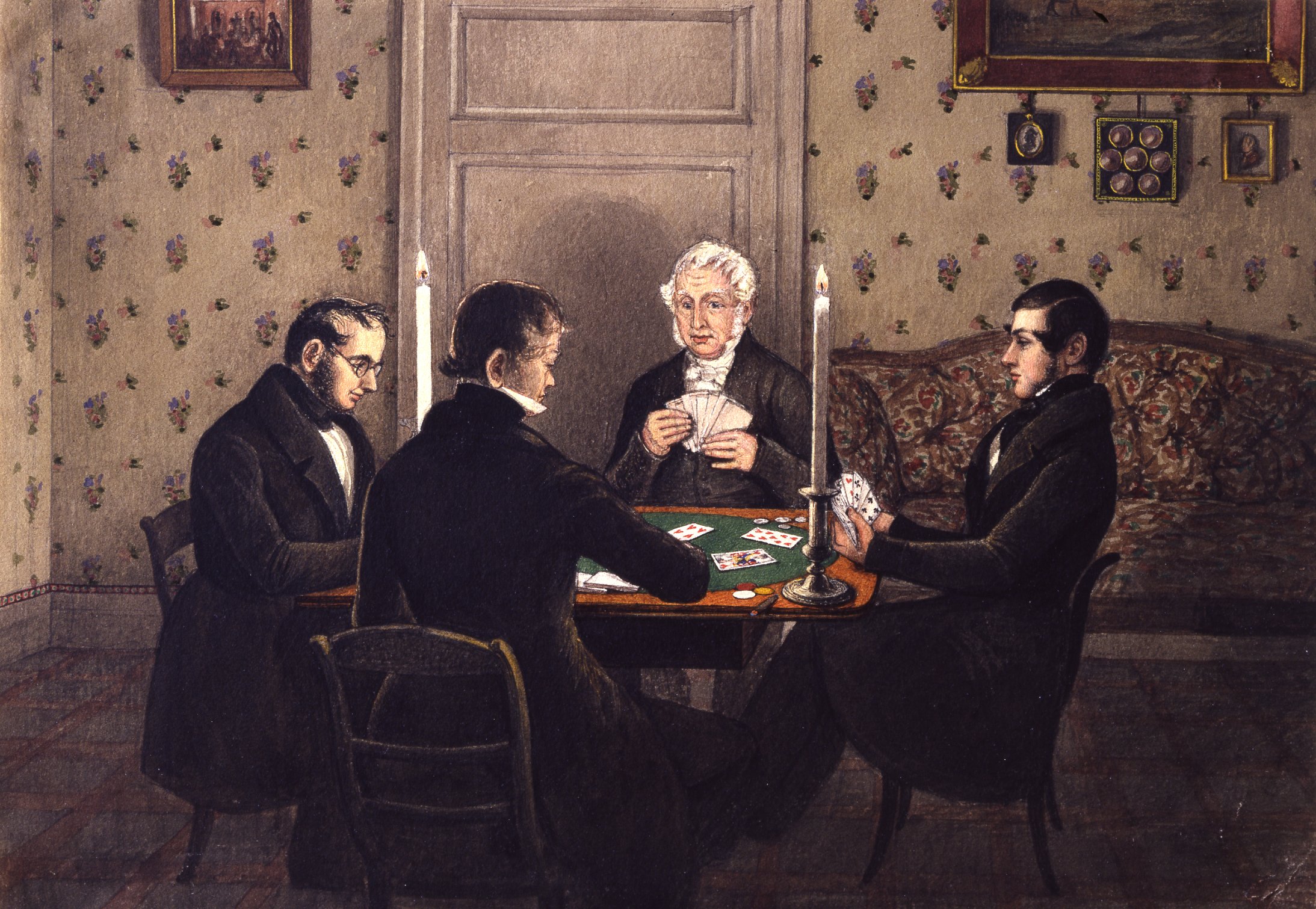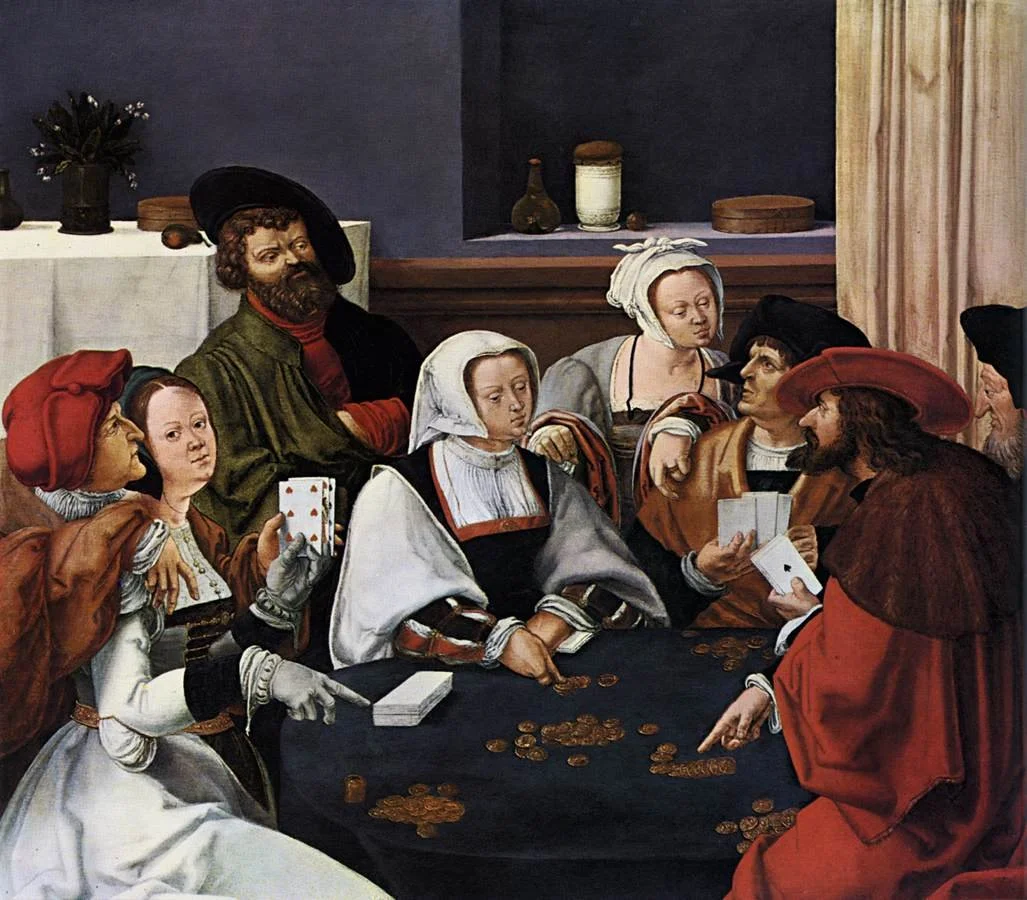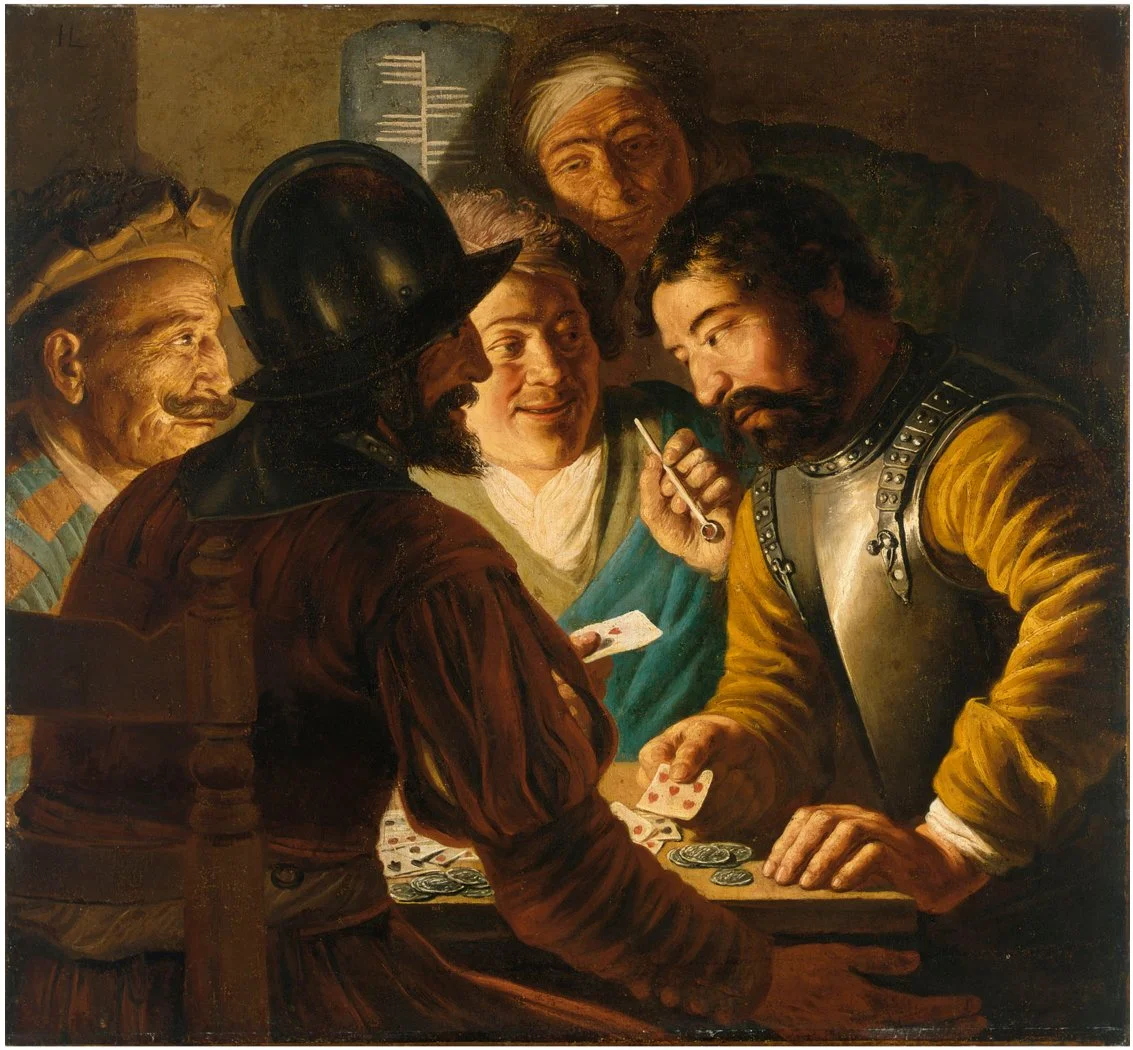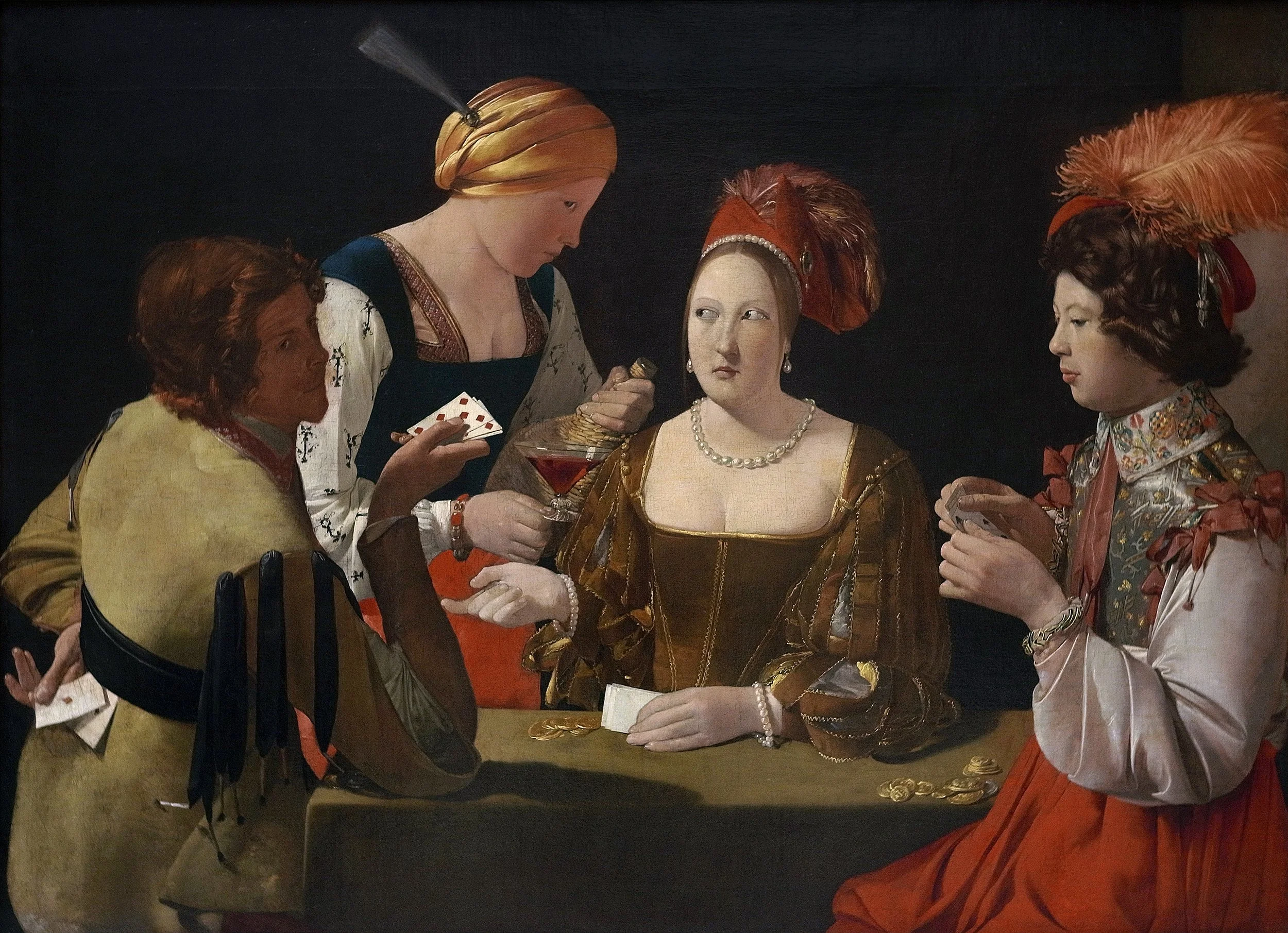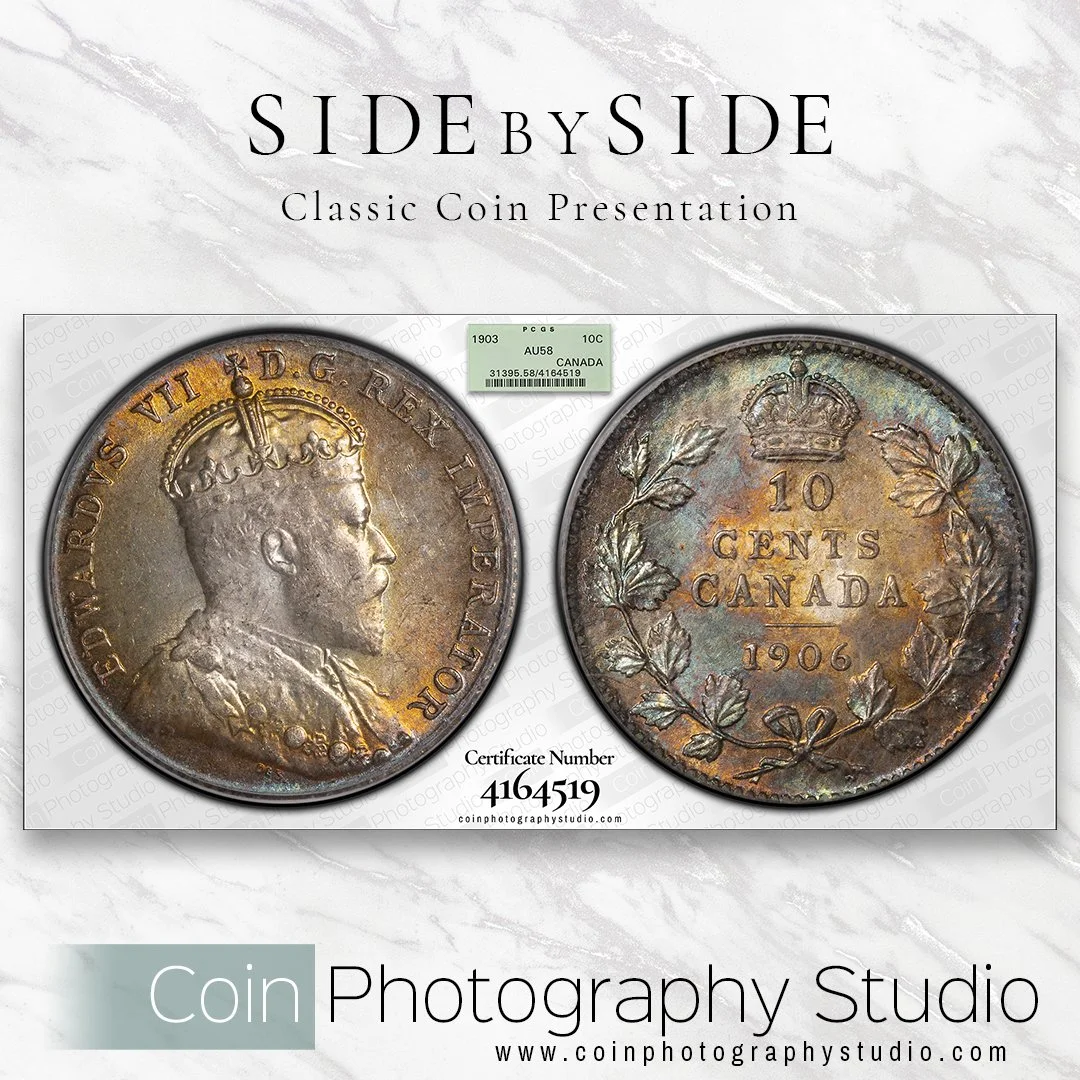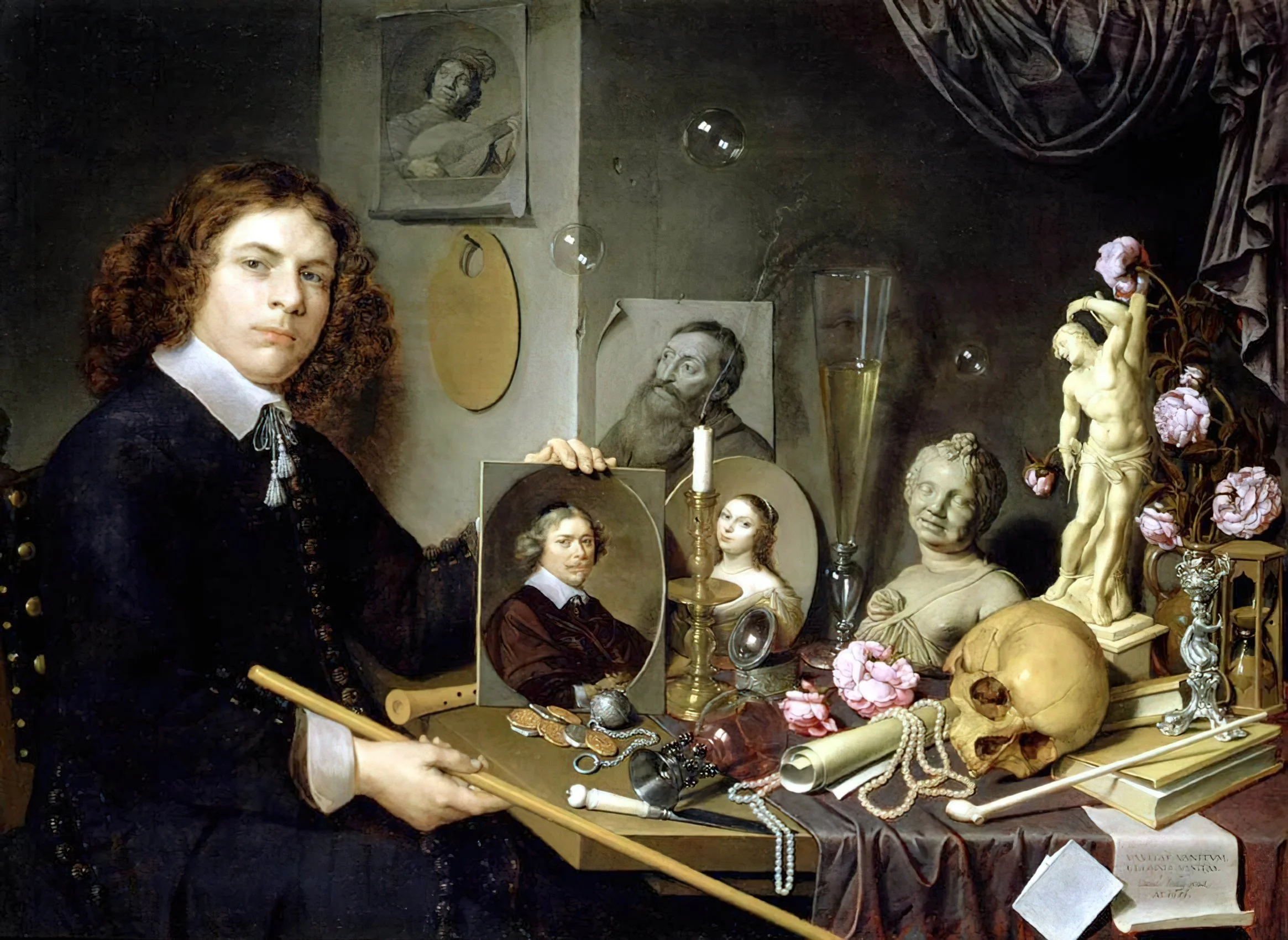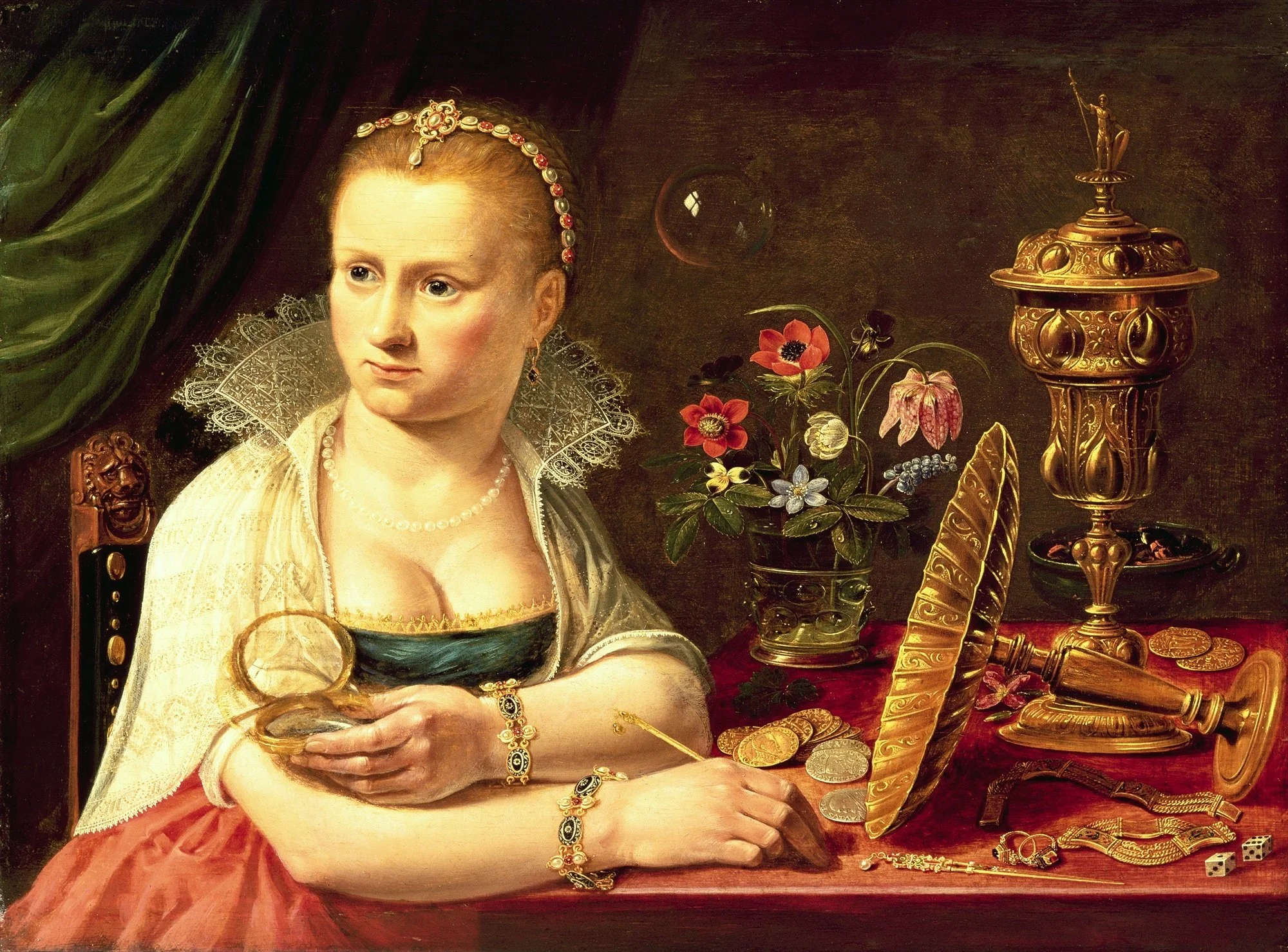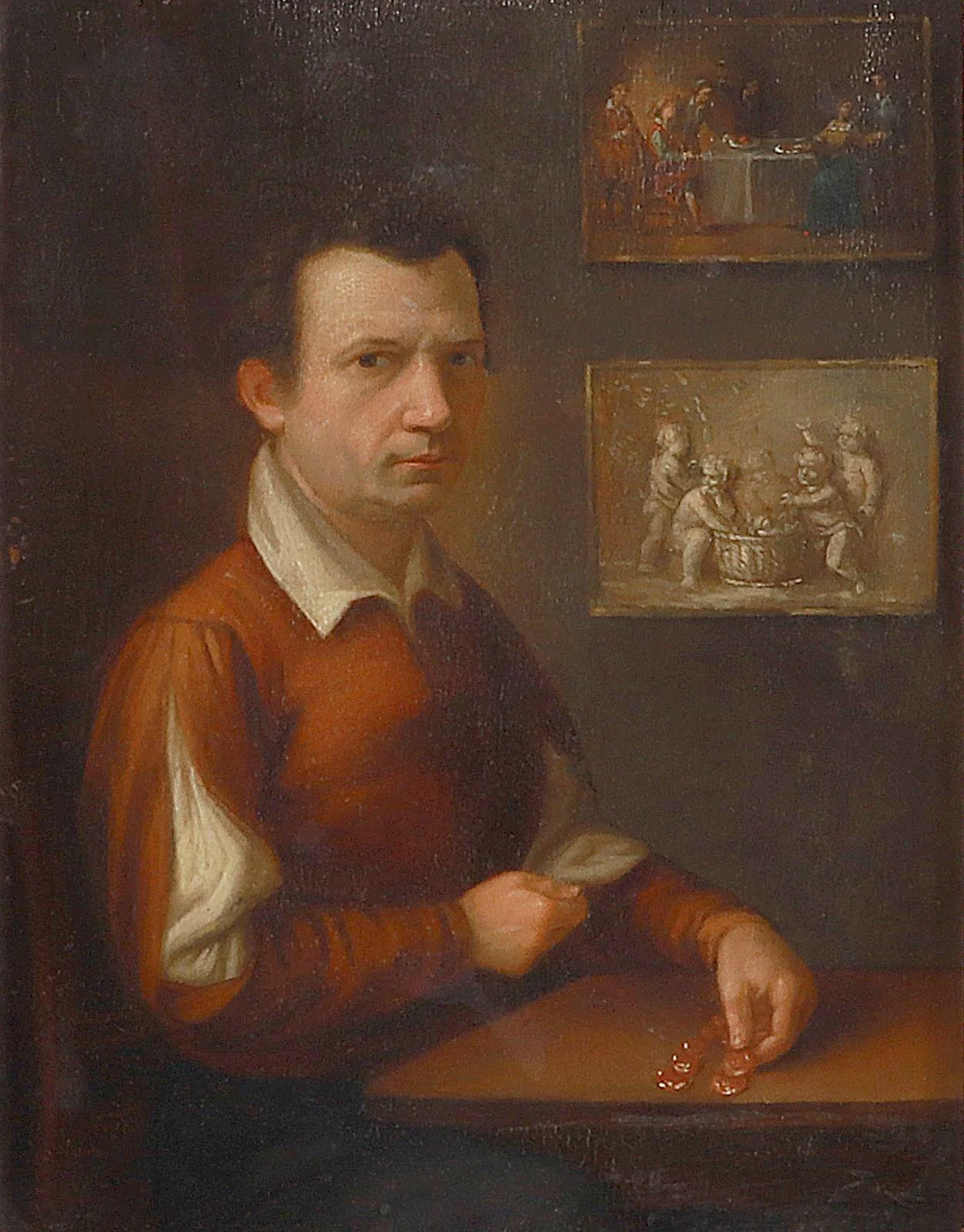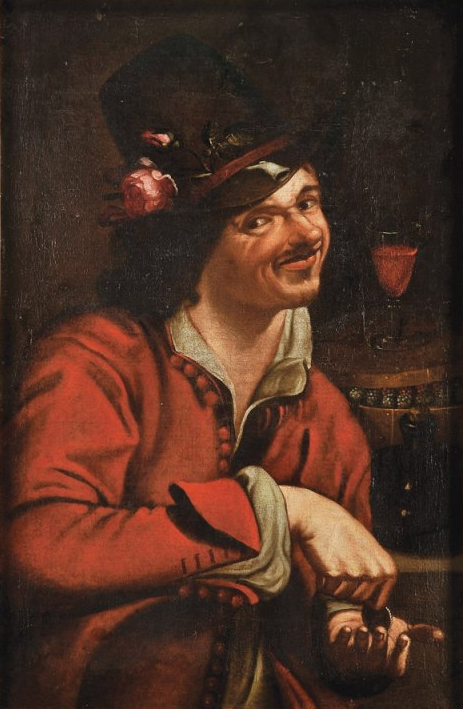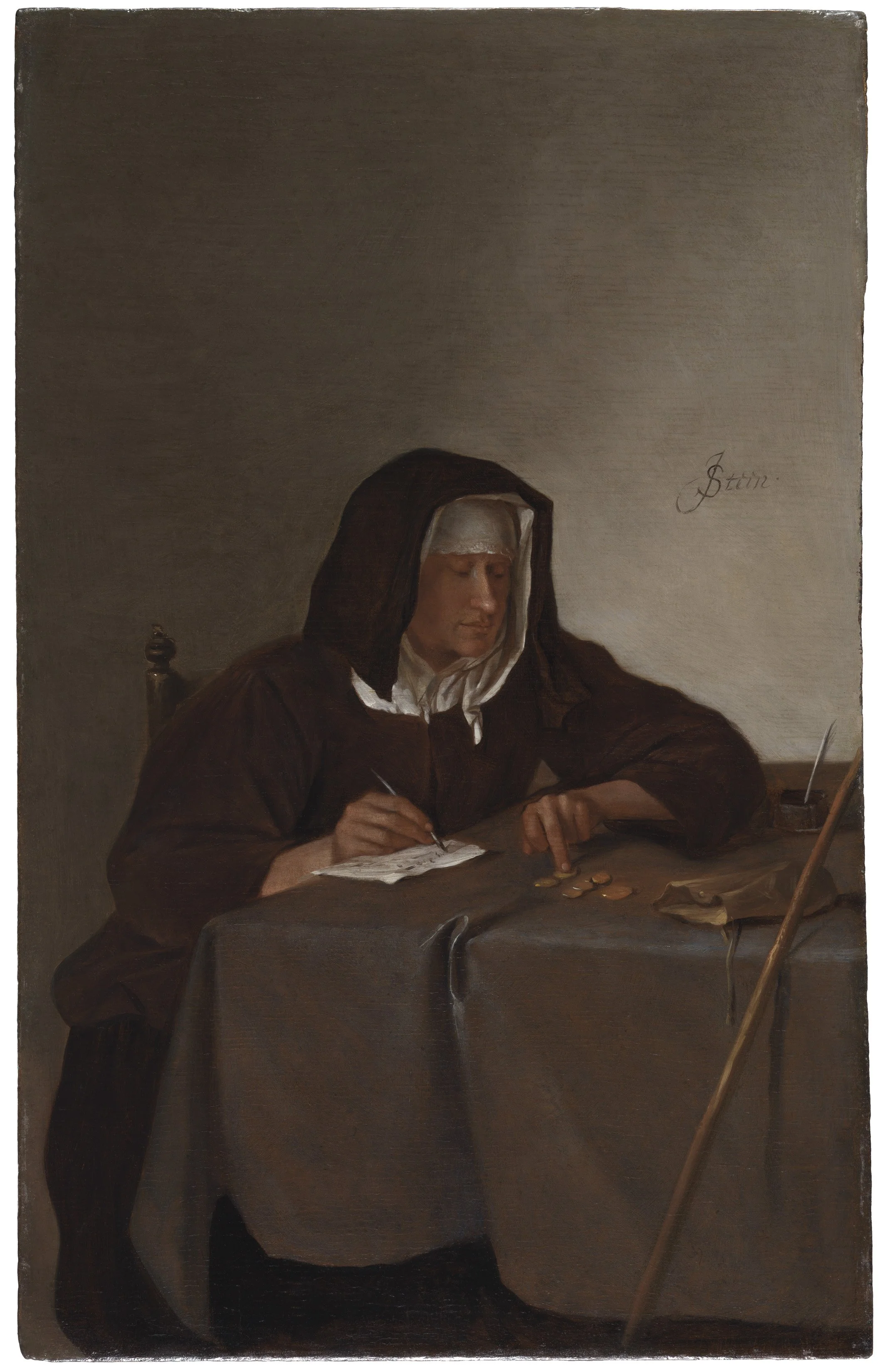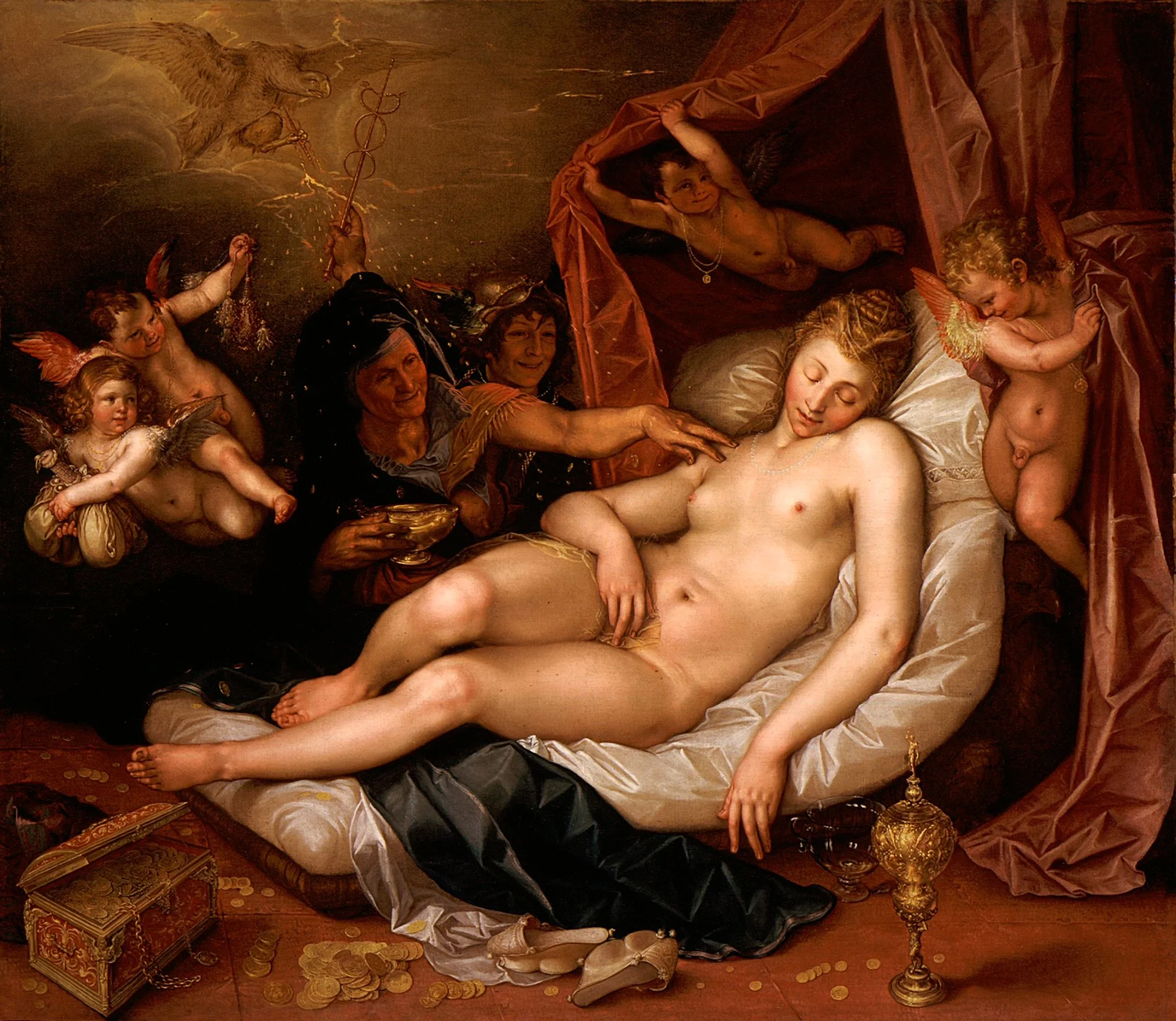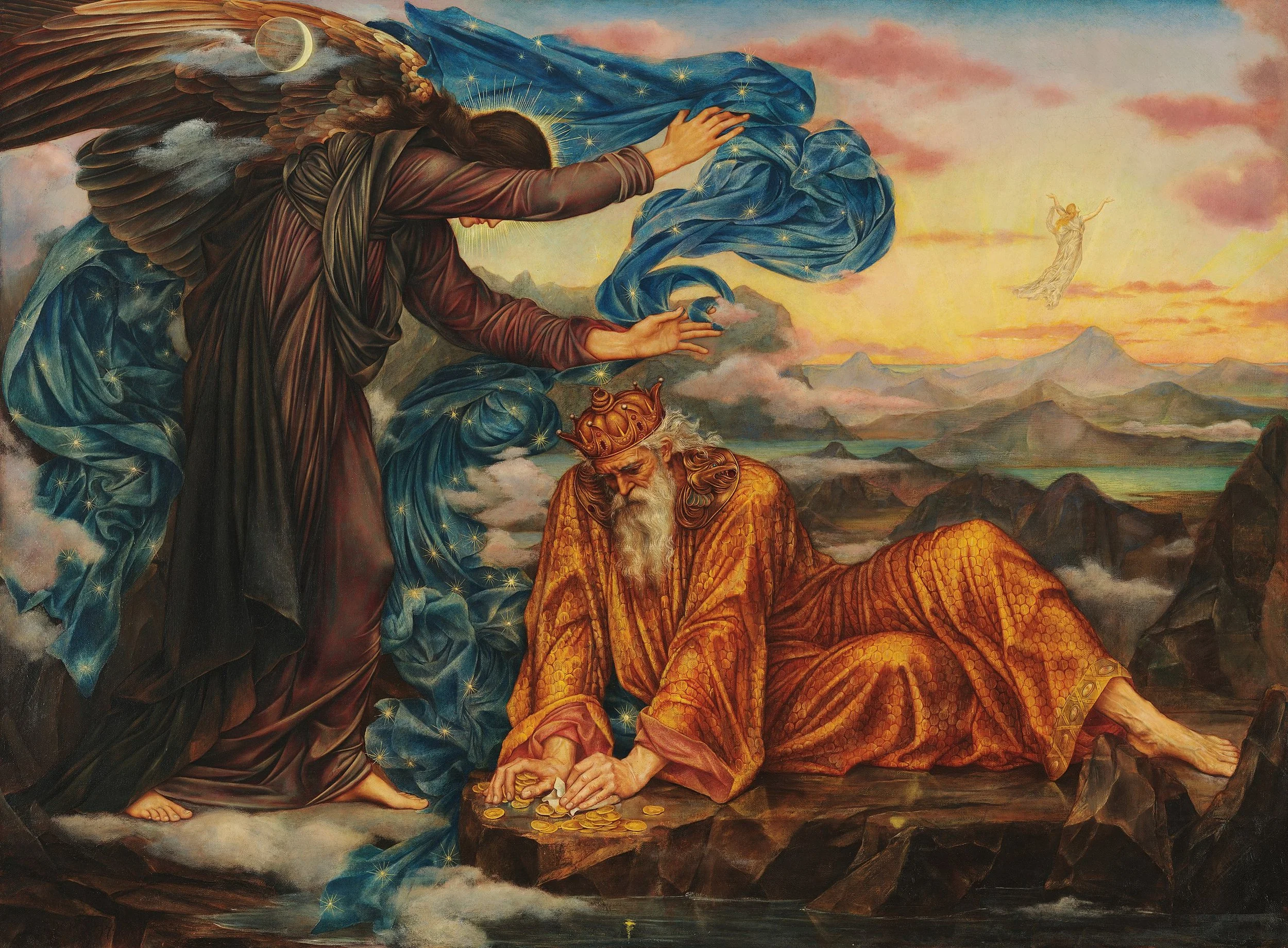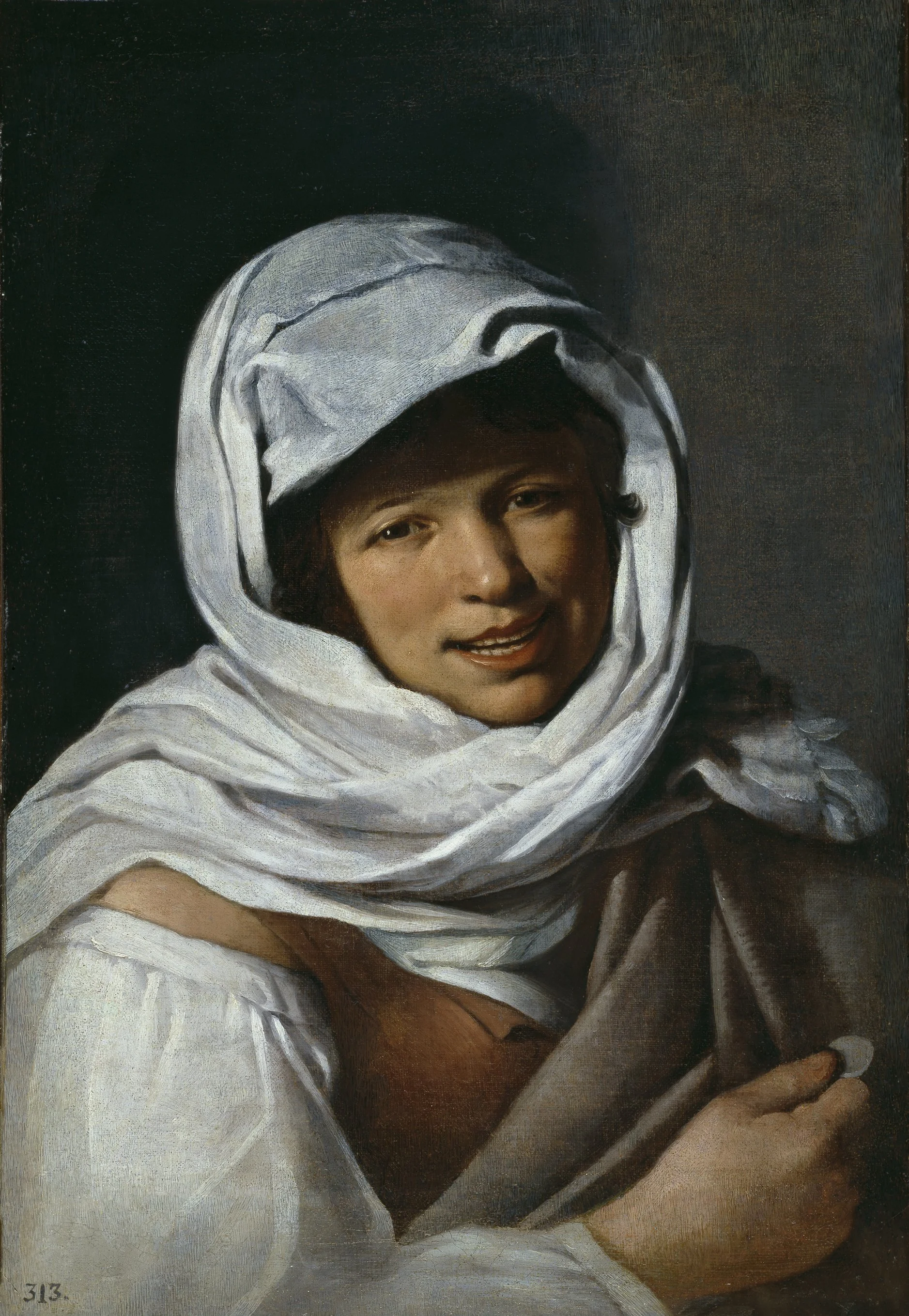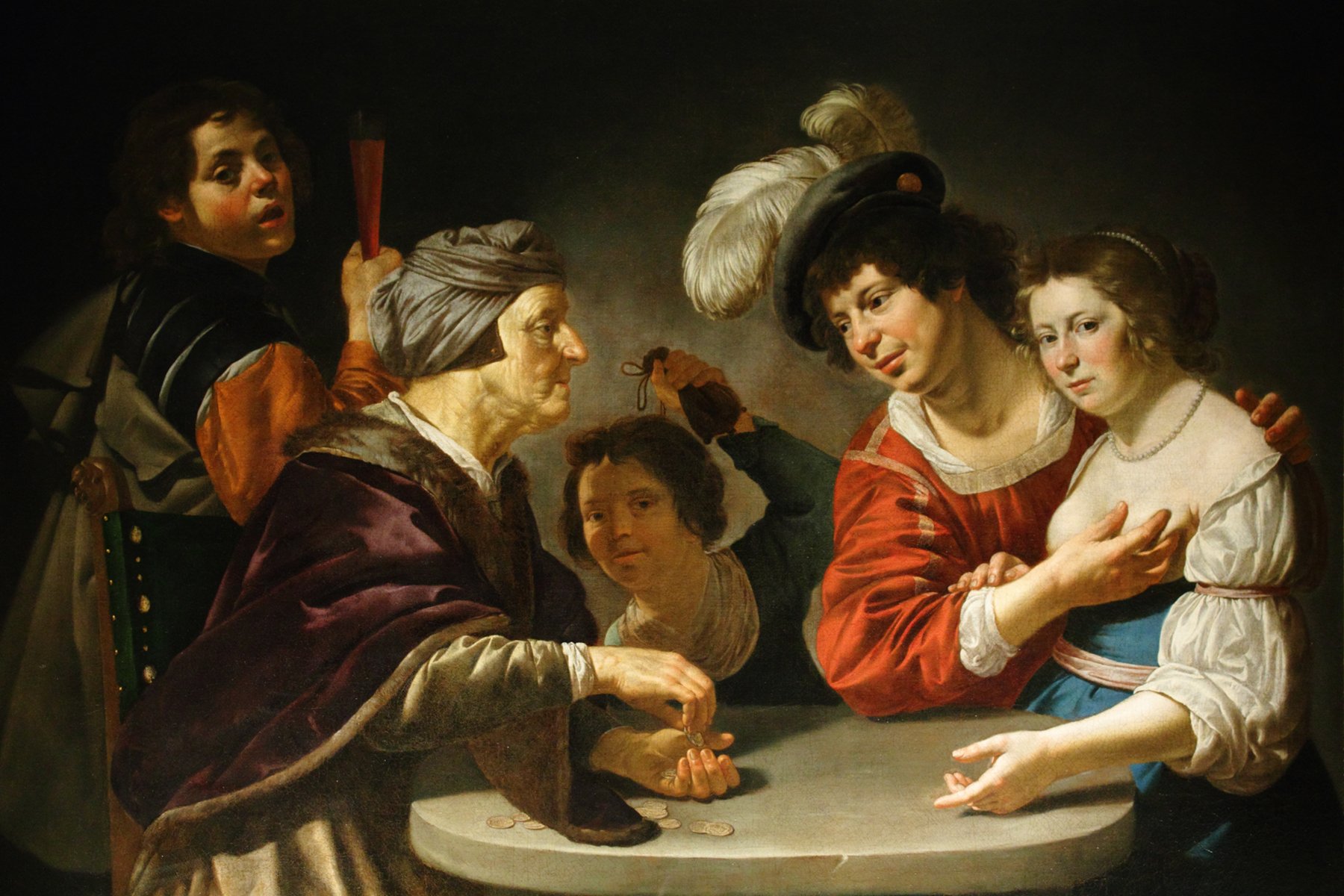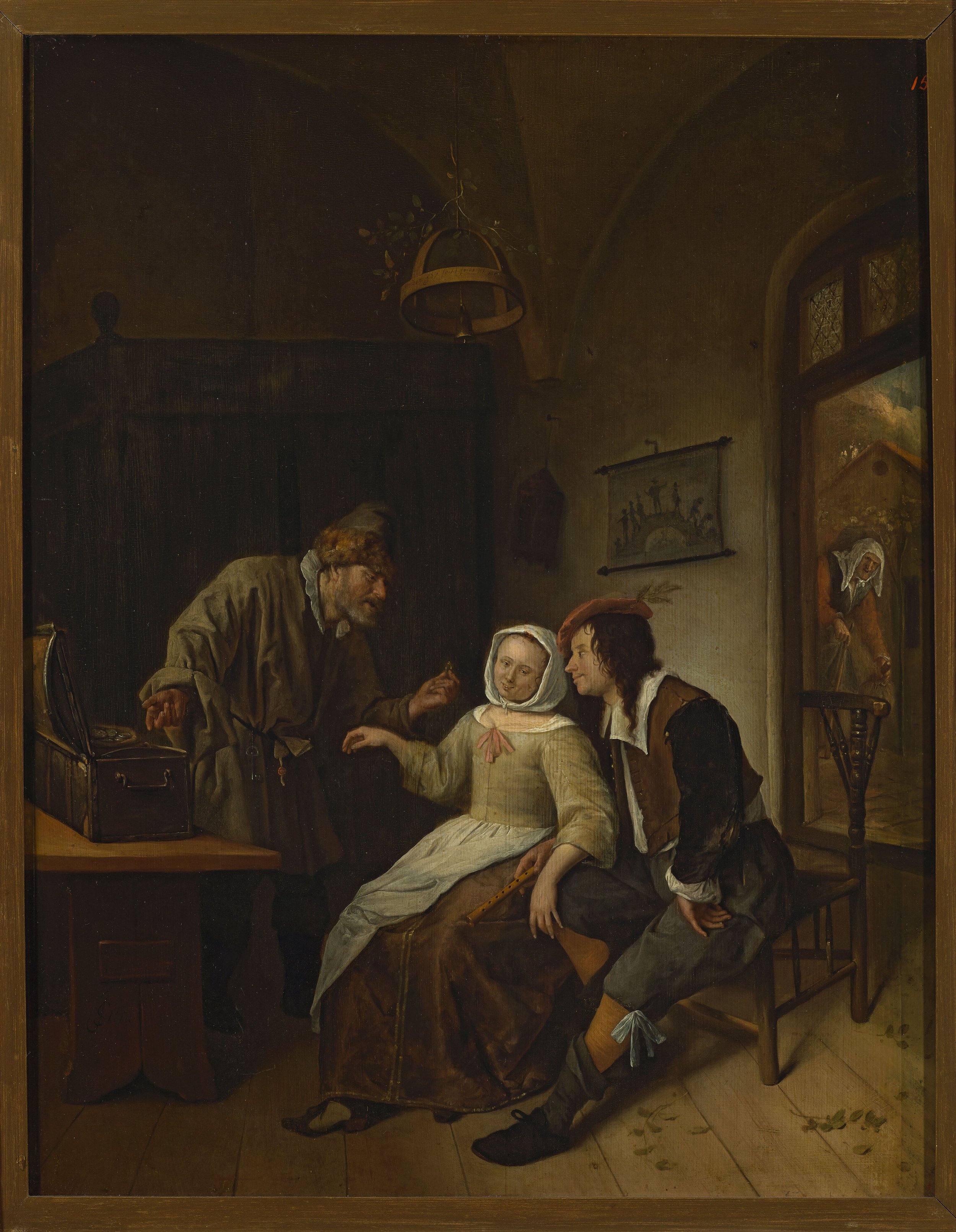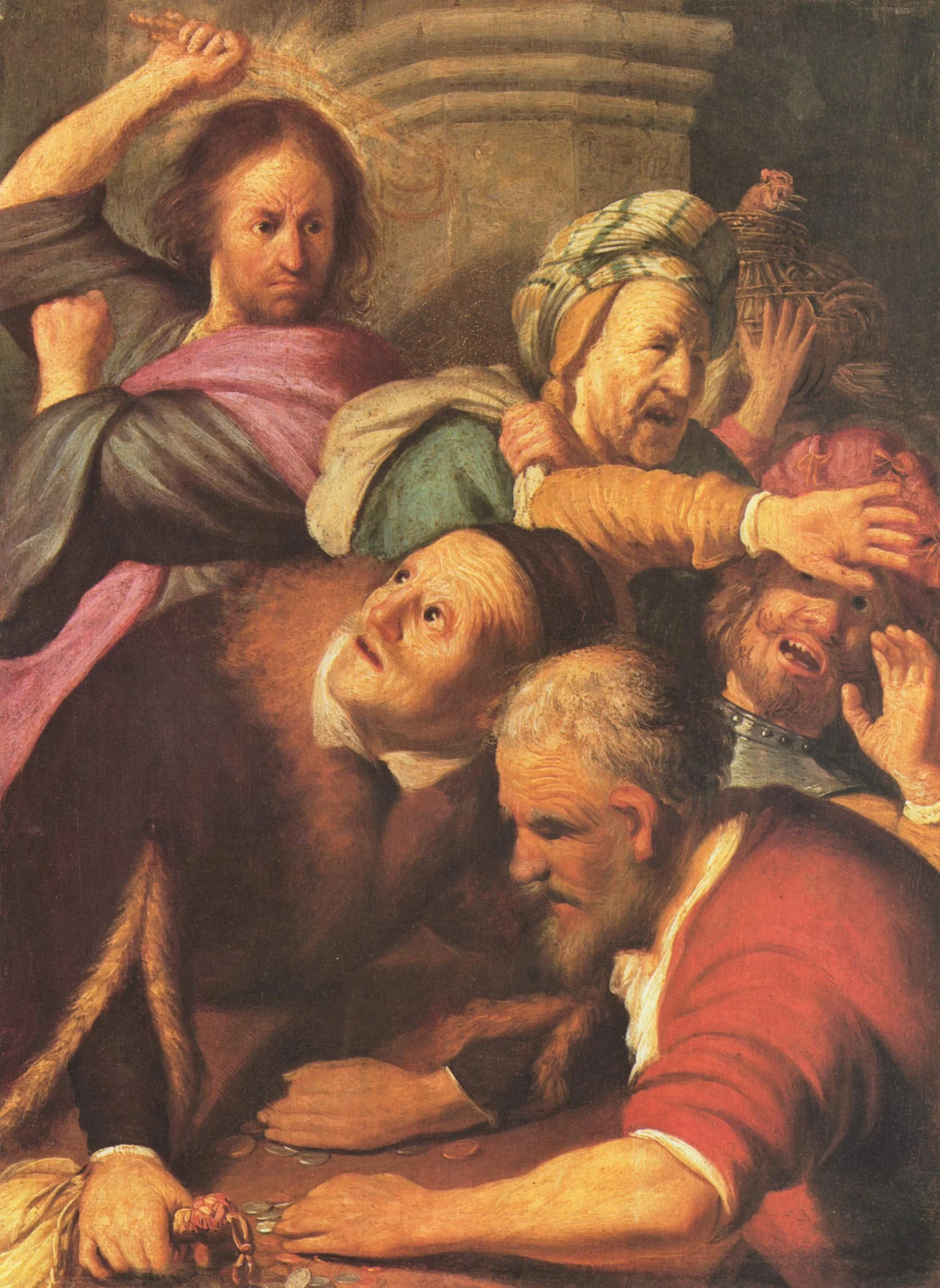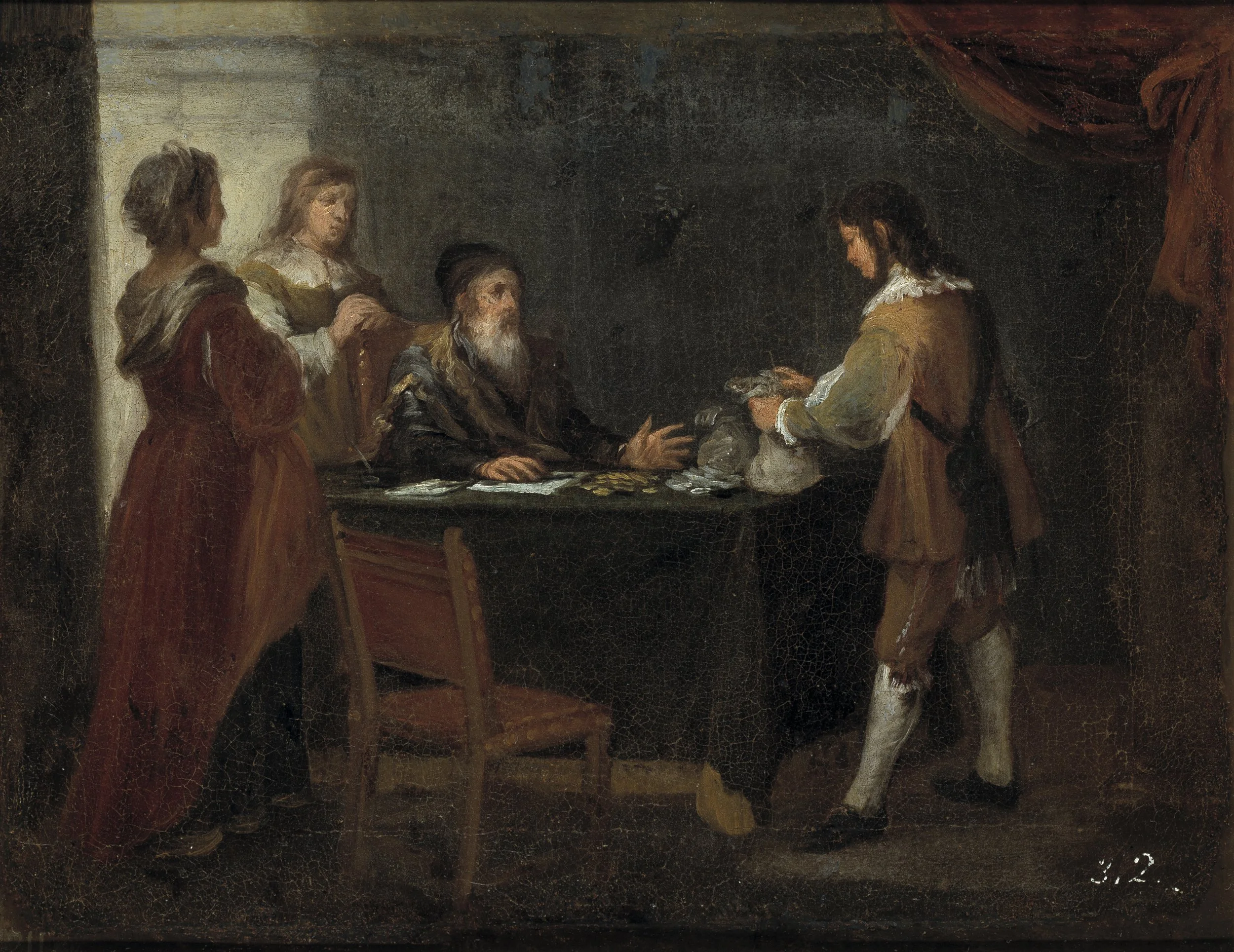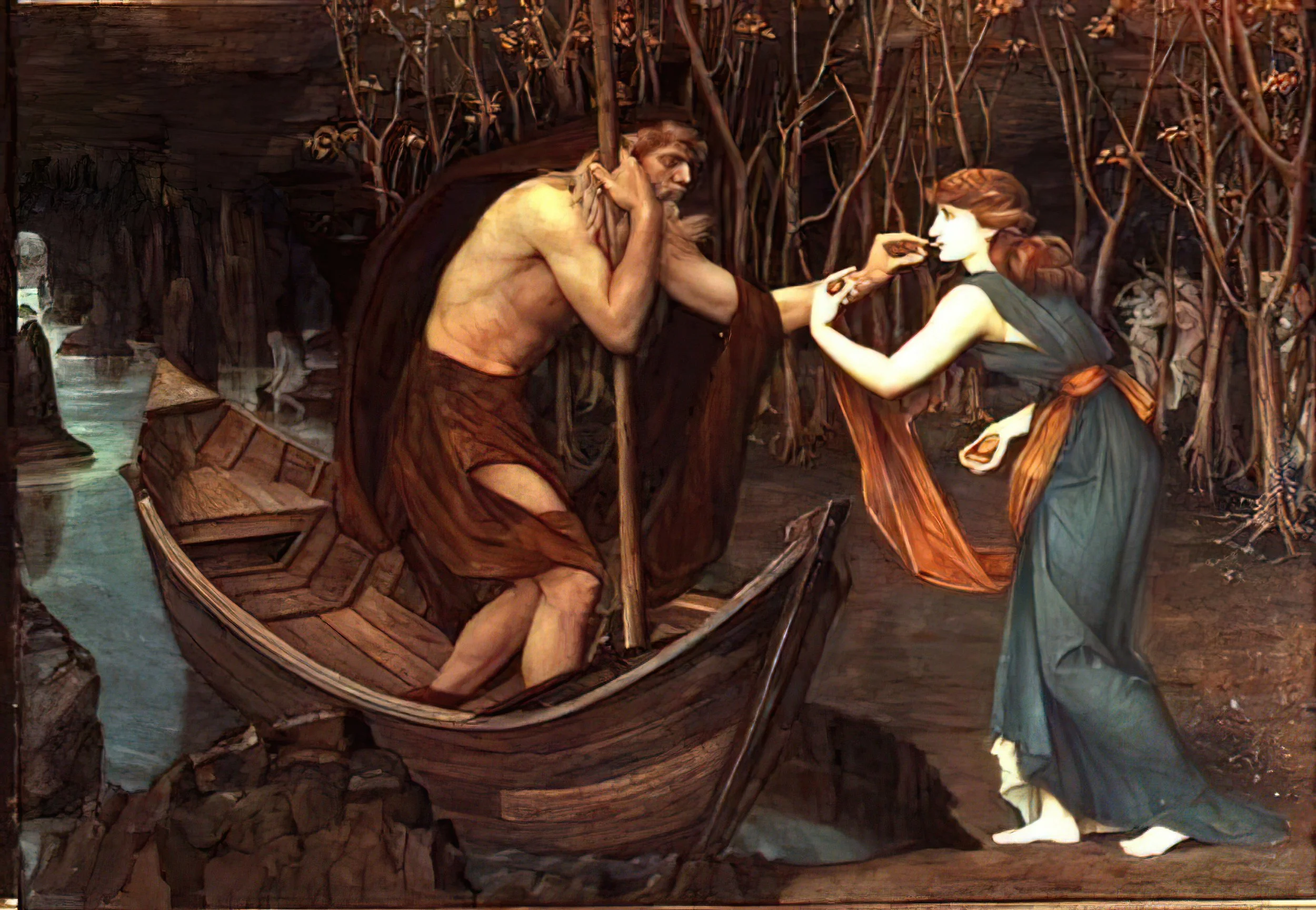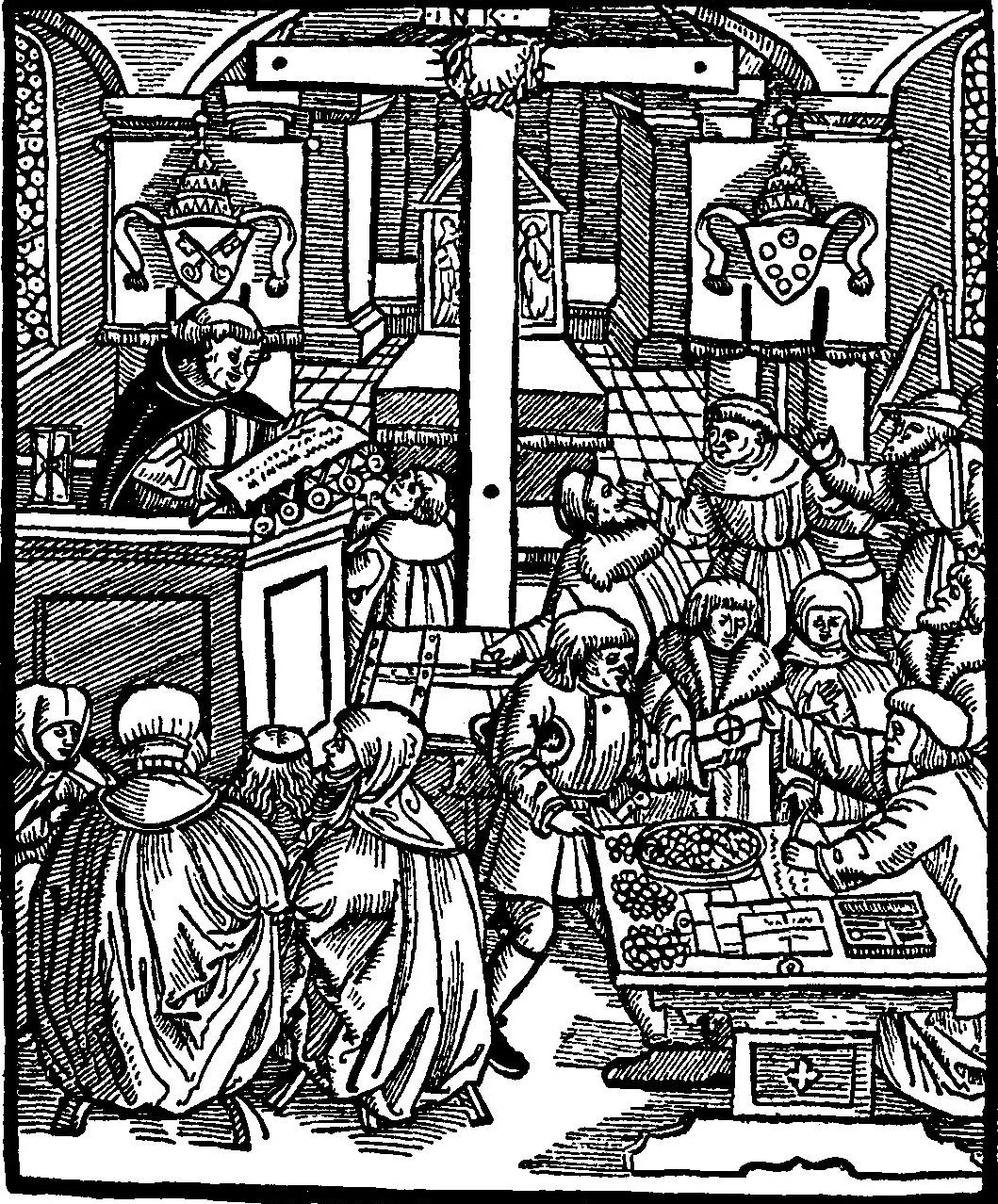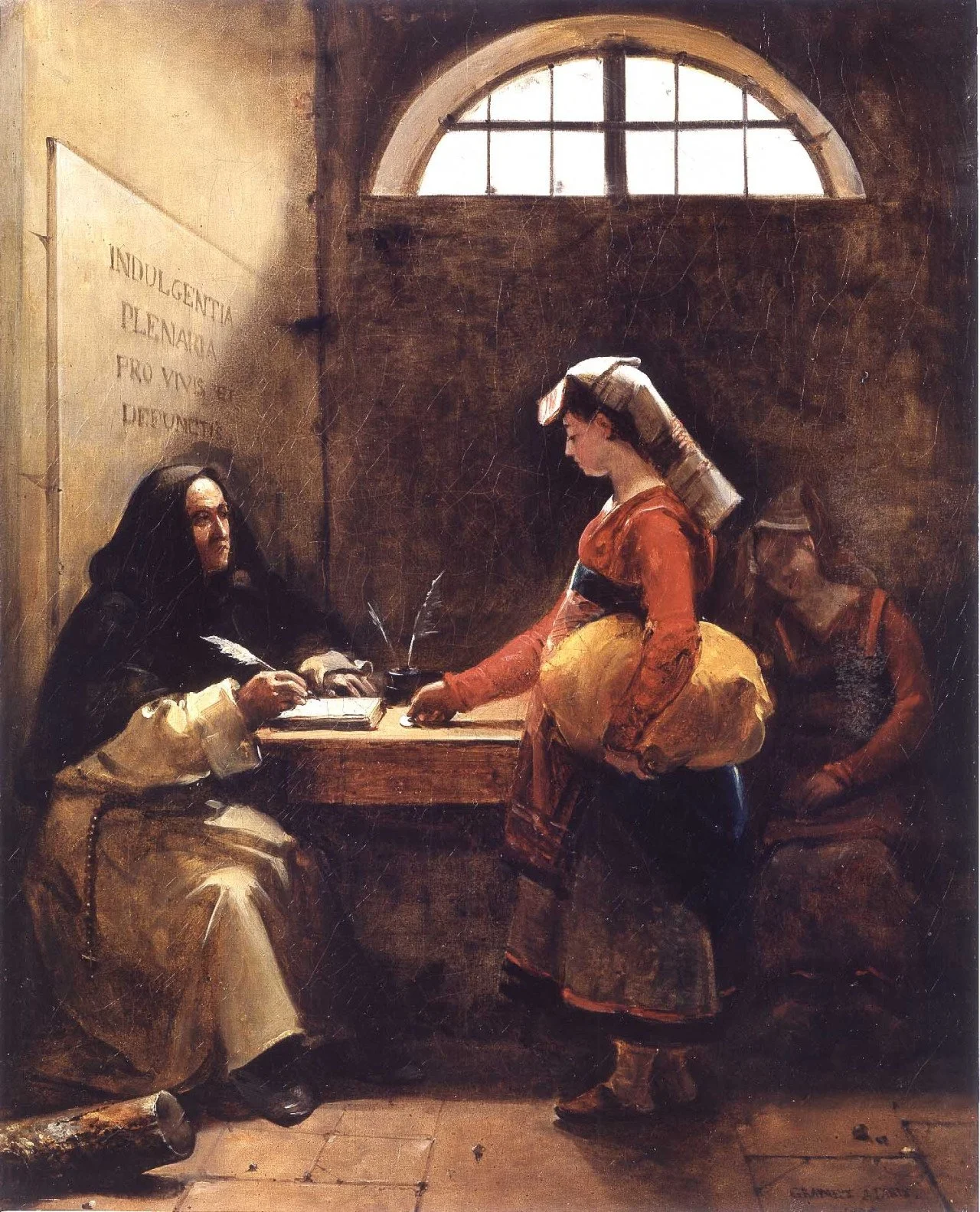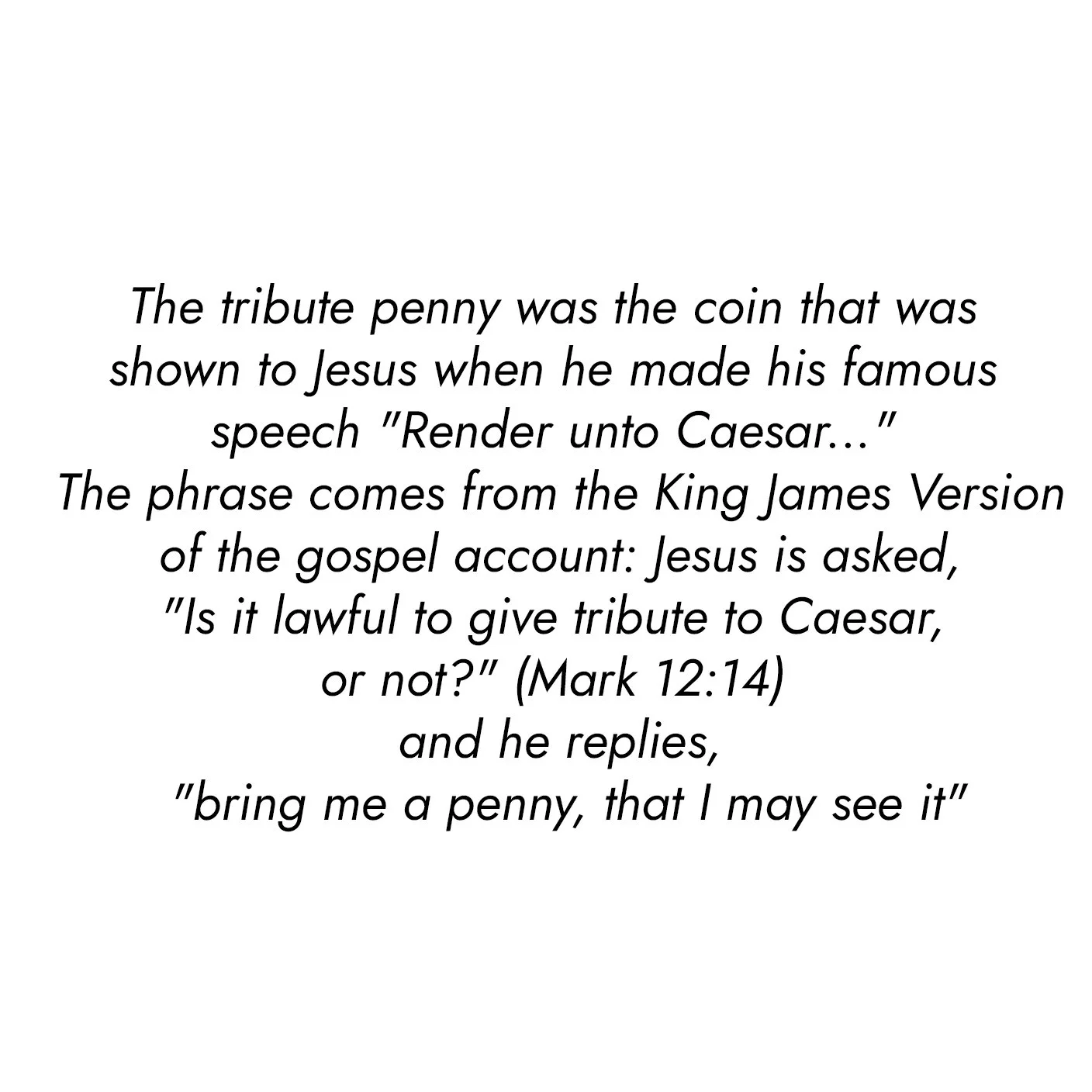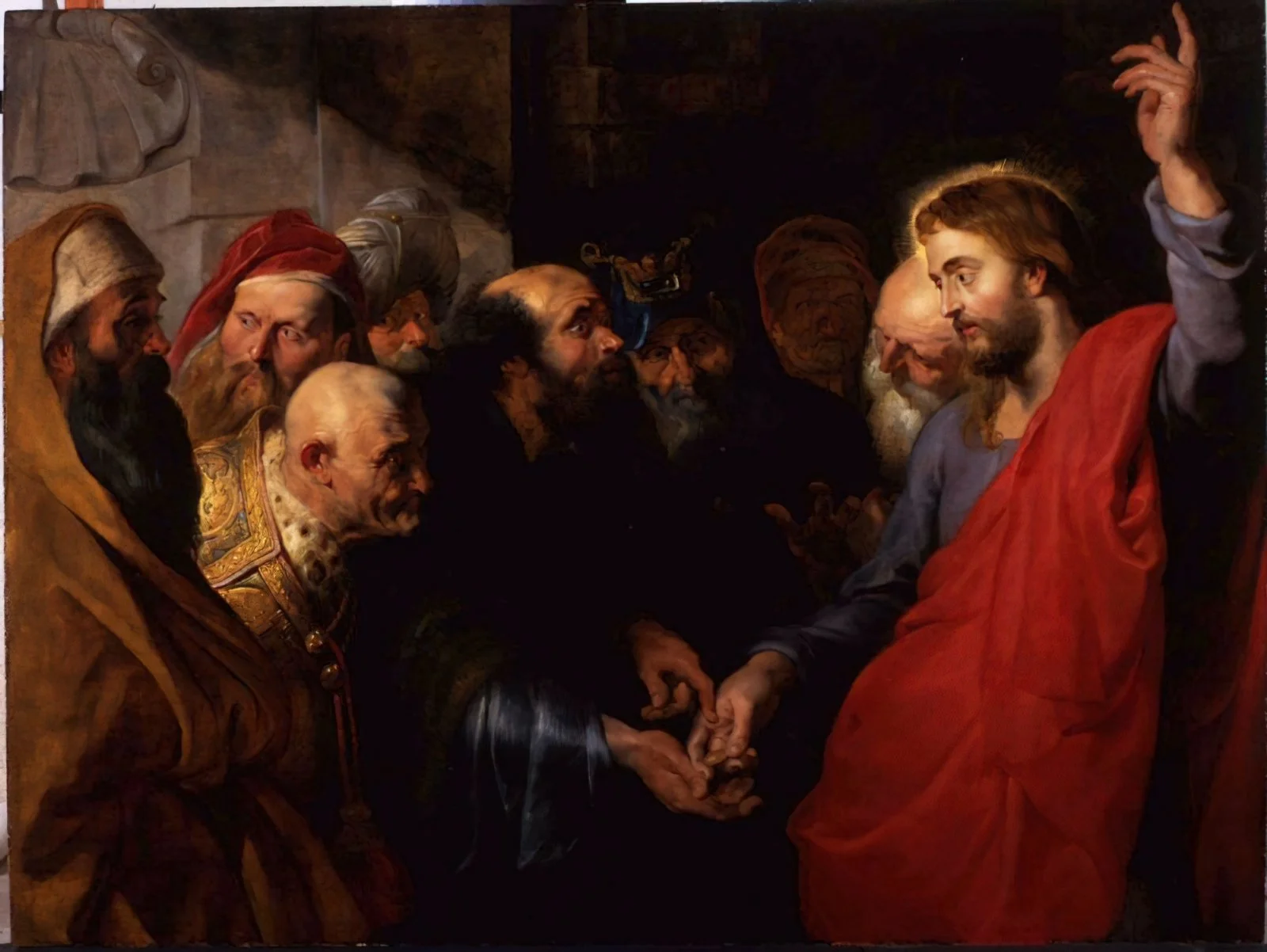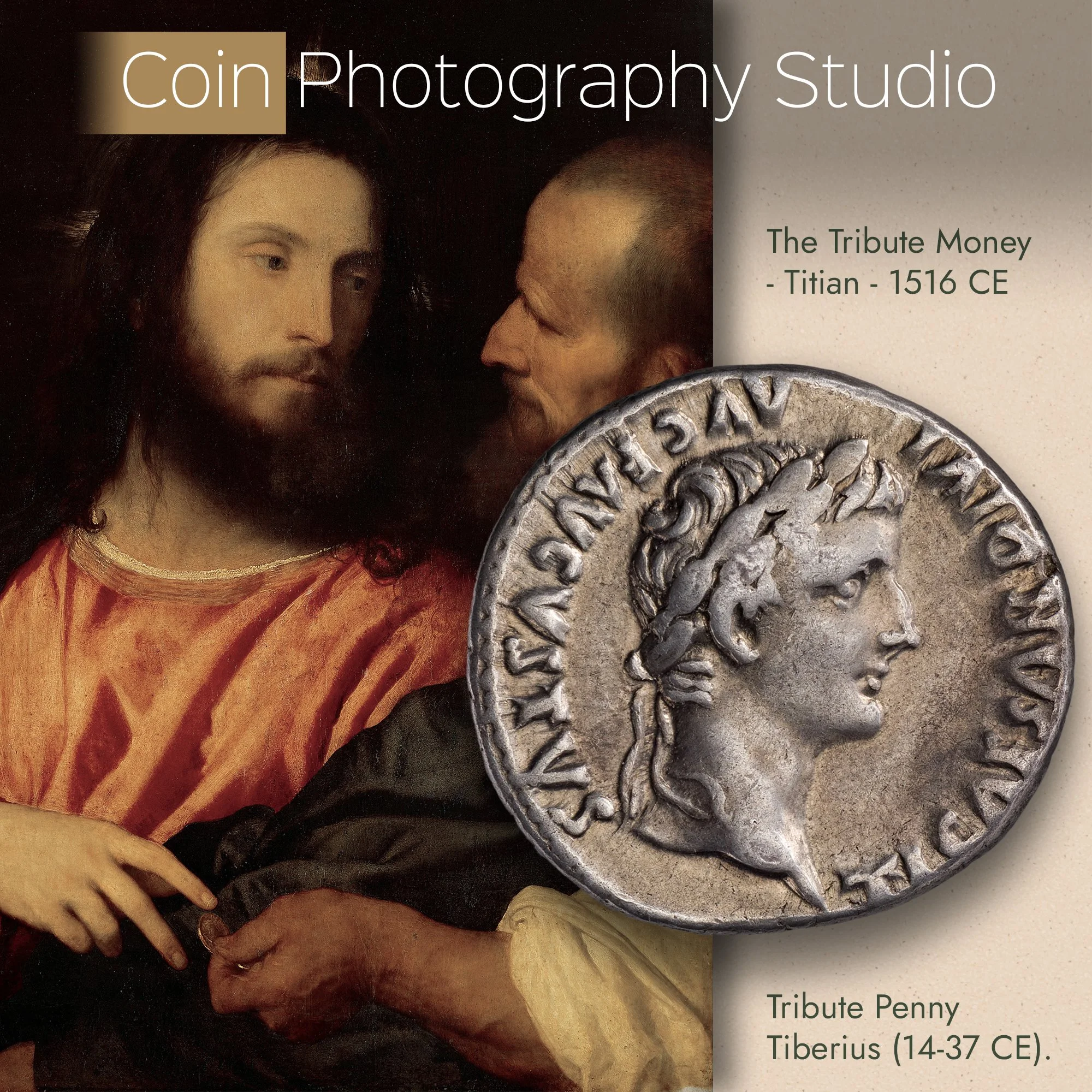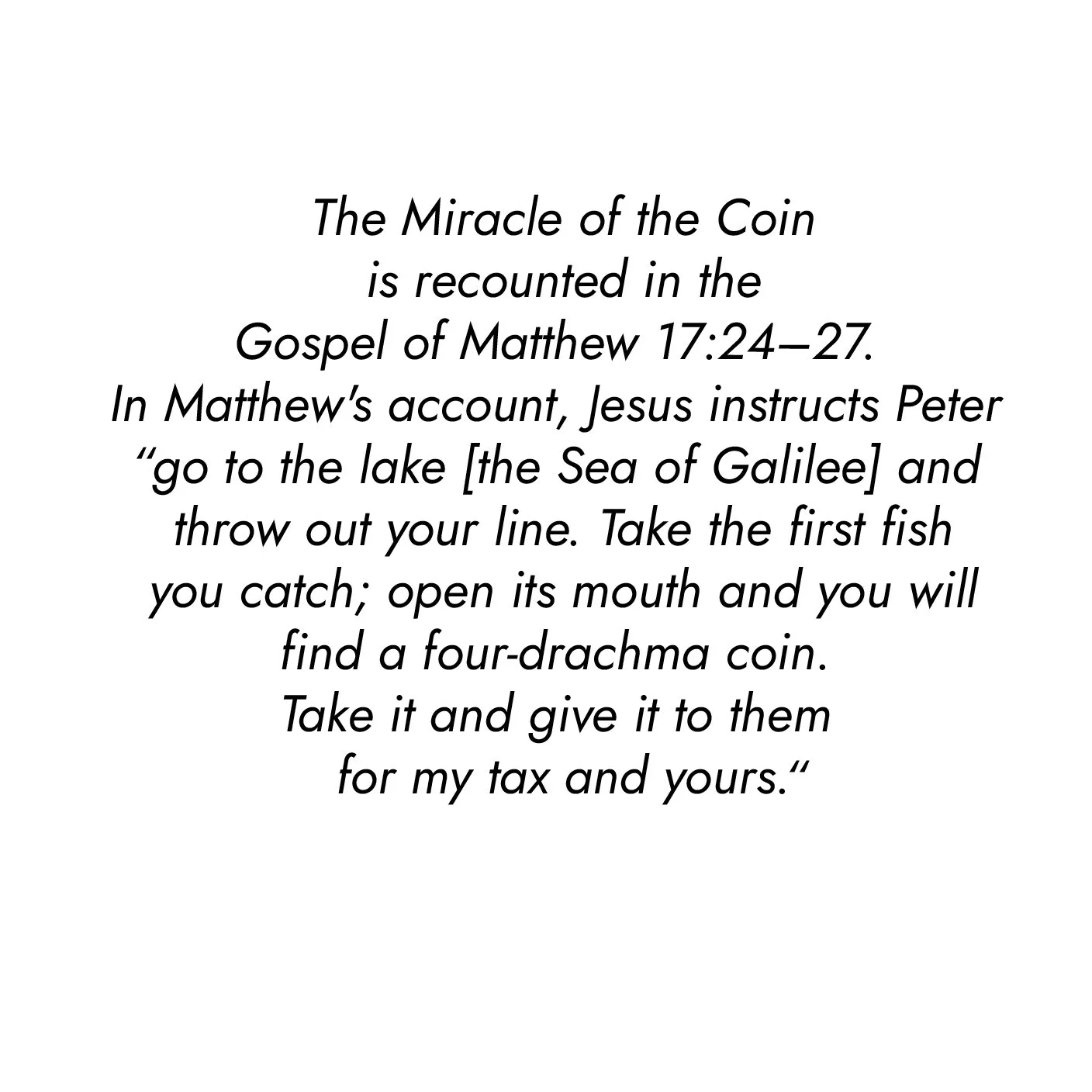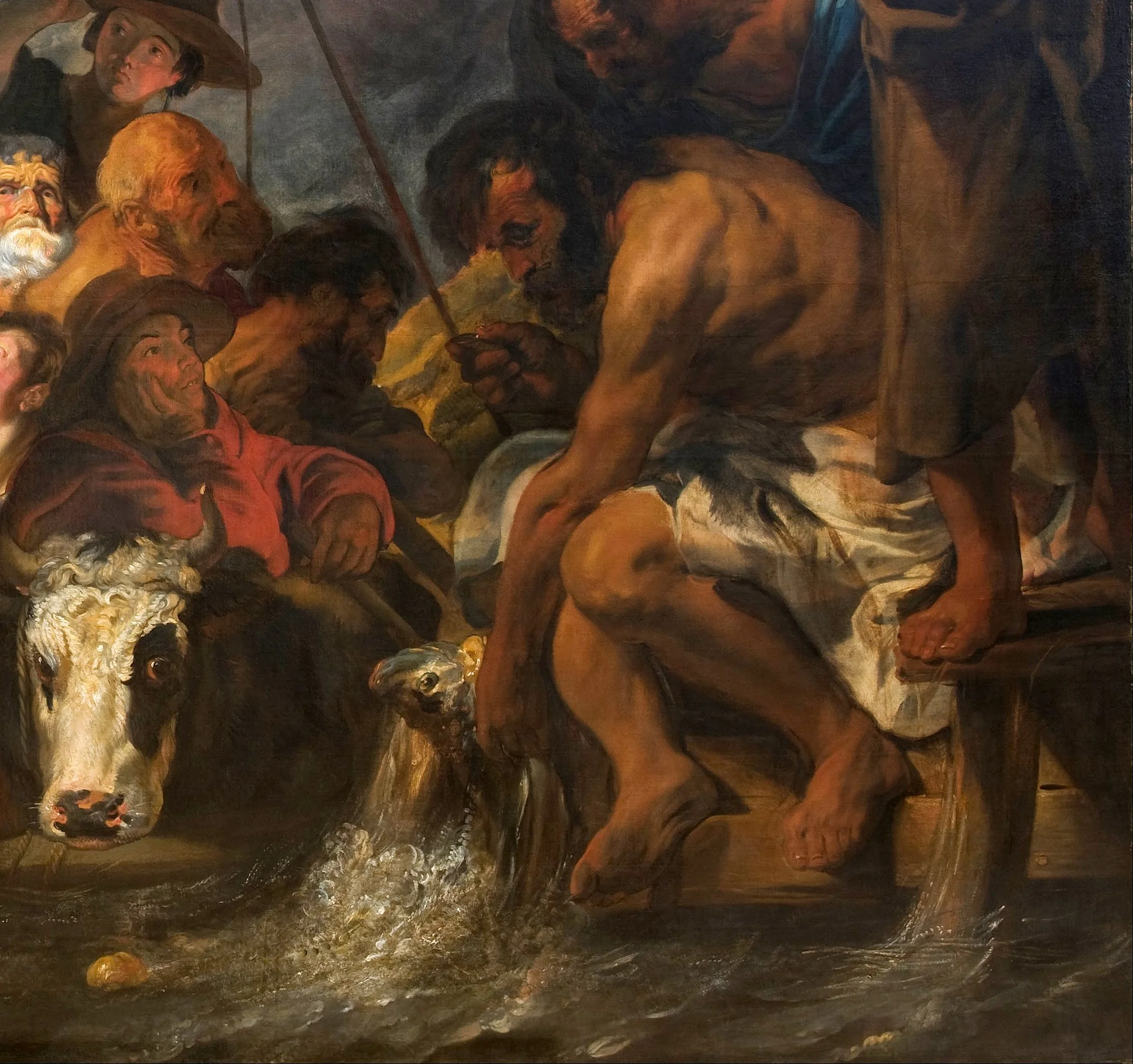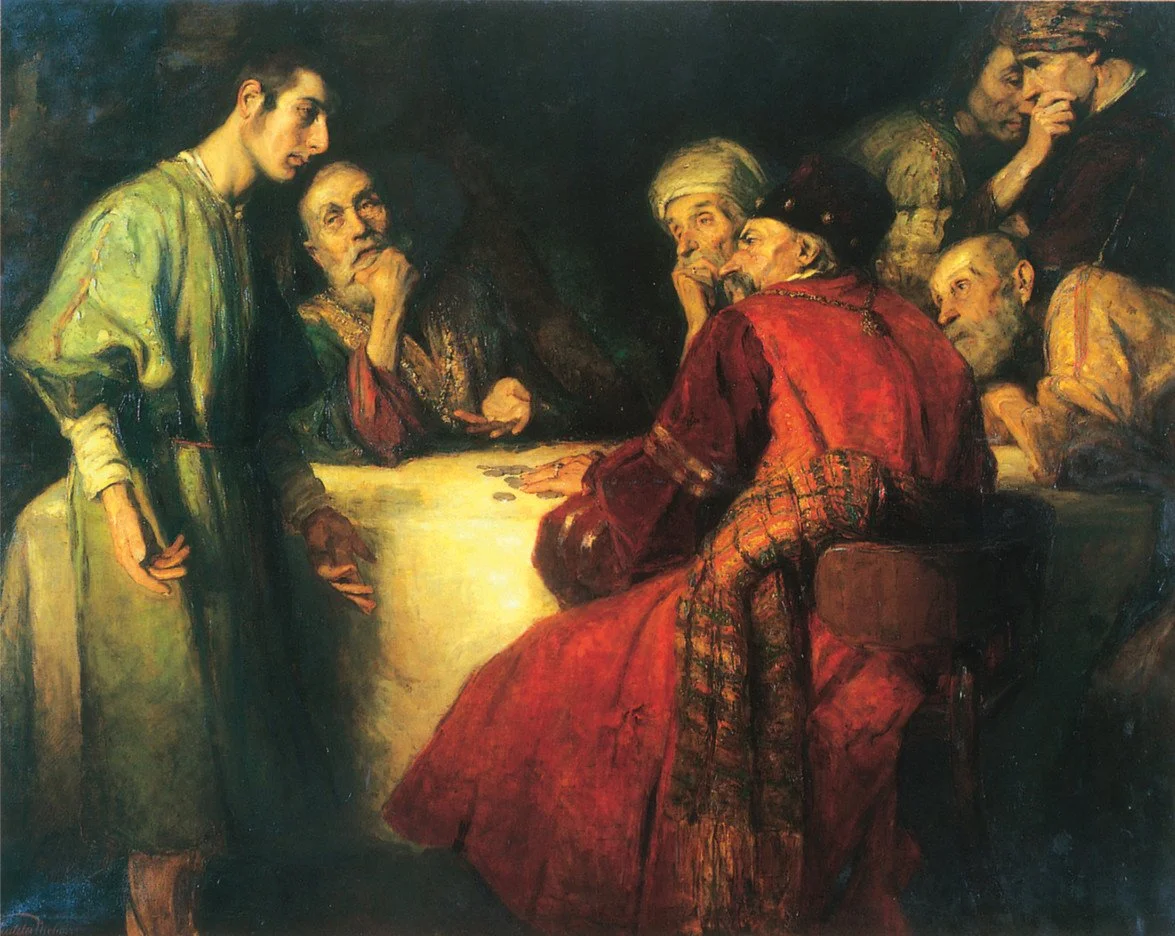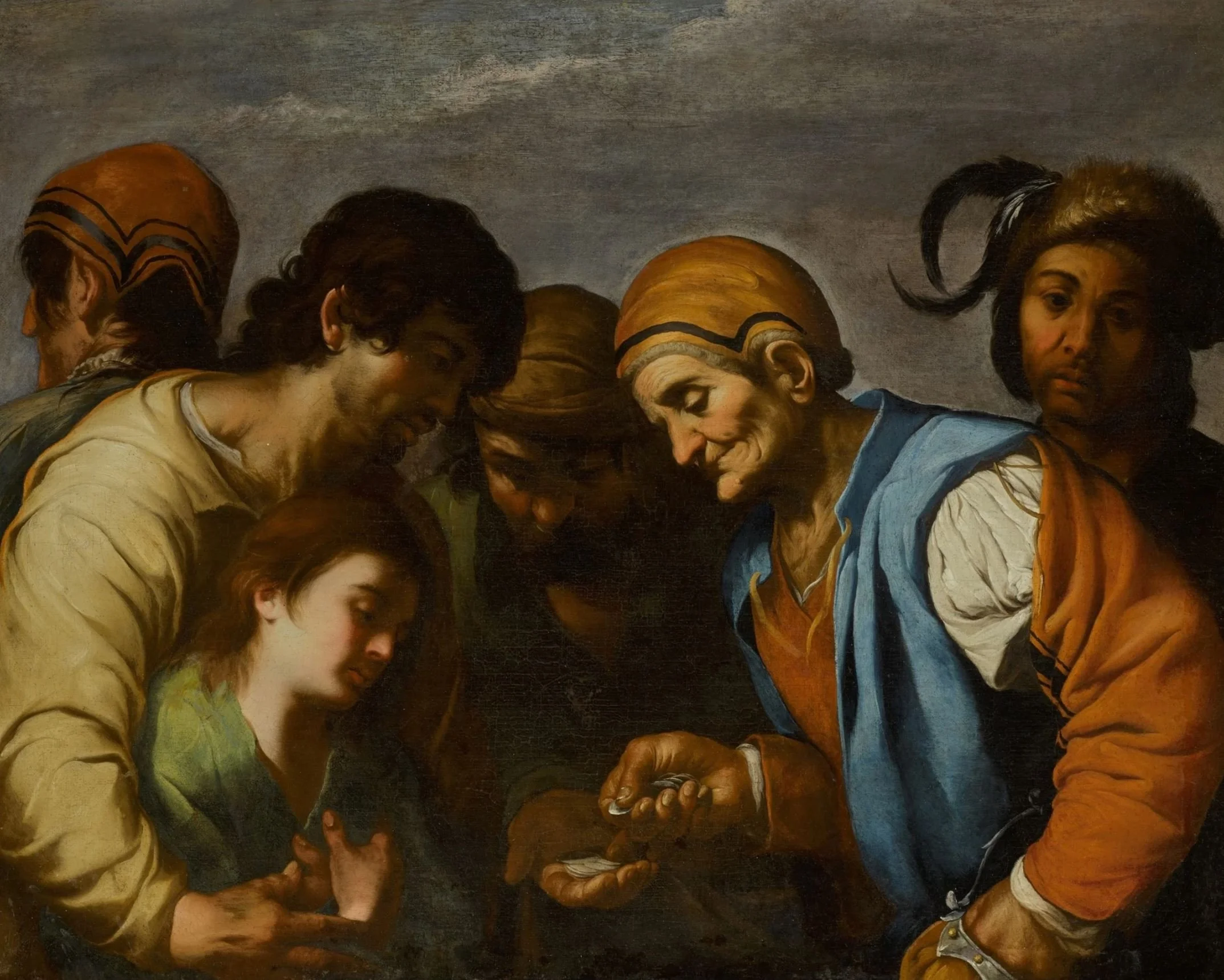
Coins in Art
Welcome to Coins and Art, an online numismatic art gallery brought to you by Coin Photography Studio, today's premier coin photography studio specializing in capturing the beauty of coins.
From the Renaissance to the modern day, master painters of the past created grand and exquisite works. They often incorporated coins into their artwork as the subject or to add texture and symbolism to these timeless masterpieces. Coins are featured in paintings by celebrated artists from Rembrandt to Rockwell, and they provide an elegant glimpse into how currency was used in different societies throughout history.
You’ll feel like you just visited a dozen art galleries.
Portrait of Matthew Boulton by Carl Frederik von Breda. Circa 1790. In 1788, Boulton established the Soho Mint as part of his industrial plant. The mint included eight steam-driven presses, each striking between 70 and 84 coins per minute.
An old woman weighing gold coins-Rembrandt van Rijn-1647 -oil on panel.
An Old Man Counting his Money by Salomon Koninck, 1635
Woman Holding a Balance by Dutch painter and art dealer Johannes Vermeer. 1664 - Oil on Canvas
Man Weighing Gold by Adriaen Isenbrant circa 1515–20.
The gold-weigher by Salomon Koninck. 1654 Oil on Canvas
Portrait of a Man with coins by Italian painter and architect Giulio Campi, 1508.
Woman weighing coins by Gabriel Metsu-1655-1657.
Die Goldwägerin- Interior with a Woman weighing Gold Coin by Pieter de Hooch- 1664- oil on canvas
An Old Man Weighing Coins by Dutch painter Salomon Koninck, painted between 1629 and 1656.
Abraham Bloemaert- L'avarice.- (Dutch, b. ca. 1564–1651)- painting on canvas.
Allegory of Avarice, by Francesco Francanzano. Painted in 1649.
Portrait of a Young Man by Flemish painter Michiel Sweerts, 1656.
Paulus Moreelse's 1621 painting of "The Allegory of Avarice"
An old woman counting coins-an Allegory of Avarice by David Teniers the Younger
A man weighing gold
Woman Weighing Gold | Alternative title- Woman Holding a Balance -circa 1530- by Jan Sanders van Hemessen-Oil on oak wood
Mayer von Bremen Umkreis Geldzählendes Mütterchen. The information available for this image is incomplete.
The Coin Collector by Vilhelm Hammershøi
'An Old Woman Holding a Purse by Candlelight' by Matthias Stomer.
Allegory of Avarice by German painter, printmaker, mathematician, illuminator, copper engraver and art theorist Albrecht Dürer. Oil on lime painted in 1507.
The Weighing of Gold by Rembrandt
"Avarice" from Matthias Stomer's workshop. Oil on canvas, circa 1650.
An old woman examing a coin-Sir Peter Paul Rubens- oil on panel.
Portrait of a Man with a Medal of Cosimo the Elder, also known as Portrait of a Youth with a Medal, is a tempera painting by Italian Renaissance painter Sandro Botticelli. The painting features a young man displaying in triangled hands a medal stamped with the likeness of Cosimo de' Medici. The identity of the young man has been a long-enduring mystery. Completed in approximately 1475, it is on display in the Uffizi Gallery of Florence.
Francesco Medici as child, 16th century, artist unknown.
The Money Changer and His Wife- 1514 oil on panel painting by the Flemish renaissance artist Quentin Matsys. A man, who is weighing the coins on the table in front of him sits next to his wife who is reading a book of devotion with an illustration of the Virgin and Child. The couple is not dressed as members of nobility, but rather as well-to-do burghers of Antwerp, where the painting was made. At the time, Antwerp had grown with the influx of many southern immigrants fleeing the Spanish Inquisition. Among this international community there was a demand for money-changers and money-lenders, as international commerce was increasing in the port city. The same motif was used 25 years later by Matsys' follower, the painter Marinus van Reymerswaele.
The Money Changer and His Wife or The Banker and His Wife by Dutch painter Marinus van Reymerswaele. Painted in the first half of 16th century.
This painting version- entitled The Moneychanger and his Wife - was painted by the Dutch artist Marinus Claeszoon van Reymerswaele in 1539. It is almost certainly an adaption of a painting of a similar name painted in 1514 by the Dutch painter Quentin Massys whom he met whilst in Antwerp.
The greedy couple weighing their possessions, by Flemish painter Gillis van Tilborgh or Gillis van Tilborch (c. 1625 – c. 1678). Oil on canvas.
Avarice and Love by Ludwig von Löfftz. 1888.
Money Changers by Salomon Komimck- 1609-1659.
A Couple Weighing Money by Franciscus van der Stieen after David Teniers. An engraving circa 1650.
A Man Weighing Gold by Dutch painter, printmaker and ornamental painter Cornelis de Man. Oil on Canvas circa 1670.
Usurer with a Tearful Woman by Gabriel Metsu- circa 1654. A usurer is one that lends money, especially at an exorbitant rate.
Old man and woman weighing coins by David Teniers (II) Flemish painter, drawer, printmaker, miniaturist and copyist- oil on wood panel painted between 1645 and 1650. At Christie’s Jan. 28, 2015, this painting brought $87,500. The lot description frames the piece in a historical context: “The subject of a couple weighing gold belongs to the tradition popularized by Quentin Massys, Marinus van Reymerswael, and other early Netherlandish painters, for whom it was associated with the admonition in Leviticus 19:35: ‘You shall do no unrighteousness in judgment, in meteyard, in weight, or in measure.’ ”
The Money Lender by Max Gaisser (1857–1922).
Avarice by Jacob de Backer.
Avarice by Jacob de Backer- coin detail.
The Moneylenders by Quentin Metsys, 1520.
Miser with Coin in Hand by Jan Steen, between 1652 and 1656. The note on the door says "Dat heb ie niet" (This you don't have)
Shylock counting his coins- An late 19th-century watercolour painting, E. Venis. A characterful portrait of a Shylock character counting his gold coins.
The Moneychanger by Marinus van Reymerswaele
The Parable of the Rich Fool, also known as The Money Changer, by Rembrandt (1627). Oil on oak wood. The parable depicts the futility of the belief that wealth can secure prosperity or a good life.
At the tax collector's office by Flemish paintger Jan Matsys- 1539- Oil on Oakwood
Two Tax collectors in their office-After Reymerswaele-16th century or later-Oil on Canvas
Portrait of a Merchant by Jan Gossaert, circa 1530.
The Miser by Jan Havickszoon Steen- 1641-1679.
The Pawnbroker, monogrammed (joined), dated 1882, oil on canvas.
The Parable of the Merciless Creditor by Flemish painter and drawer Jan Sanders van Hemessen, 1566.
Oil painting of Jewish coin clippers at work, likely created in 19th century Russia. They are depicted with beards and sidelocks, which are traditionally worn by Jewish men.
The Payment of Dues by French painter and architectural draftsperson Georges de La Tour between 1630 and 1635.
New York Artist John Ward Dunsmore’s panting captures the first US coins produced by the first US Mint producers in Philadelphia Pictured (left-to-right) are Secretary of the Treasury and Mrs. Alexander Hamilton, President Washington’s Secretary Tobias Lear, President Washington, Secretary of State (later President) Thomas Jefferson, First Lady Martha Washington (seated), First US Mint Director David Rittenhouse, First Coiner of the US Mint Henry Voigt, and Coin Producer Adam Eckfeldt.
Allegory of Justice by Giorgio Vasari. The female personification of Justice is represented semi-nude in the center of the image. Personifications of the seven Vices are chained below Justice in submission, including the bearded figure of Greed peering at a pile of coins and treasure in the foreground. Oil on panel.
Detail- The bearded figure of Greed peering at a pile of treasures in the foreground.
L'avarice by Dutch / Flemish painter Matthias Stom. This oil on canvas was painted in the 17th century.
Allegory of Covetousness by Polish painter Herman Hahn, circa 1613. Oil on panel. Hermann Hahn was born in Nysa (Neuss) on the left bank of the Rhine near Dusseldorf. He studied in Flanders, and possibly, too, in Vienna. Around 1600 he moved to Gdansk where he remained for much of his life, though he served for a period as court painter to Sigismund III of Poland.
A Frog Sitting on Coins and Holding a Sphere: Allegory of Avarice Jacob de Gheyn II, about 1609. The frog is an allegory of avarice somewhere between a realistic rendering of nature and an imaginative fantasy. The creature does not merely rest on the coins but reaches greedily and uncouthly between its legs to grasp them. The large sphere may symbolize the earth, the frog, and all the world's greed. Appropriate to the sin of avarice, the humanized frog is a monstrous perversion of the natural world.
Allegory of Abundance by Louis Counet, 1719.
An Allegory of Vanity by Spanish painter, sculptor and architect Juan de Valdés Leal, circa 1660
Allegory of Vanity - Pandora by Nicolas Régnier-1626, oil on Canvas
An allegory of love with a singing violinist and a courtesan with coins in her palm by Angelo Caroselli. Oil on slate, painted Date between 1615 and 1652.
Death and the Miser by Jan Provoost. Oil on oak wood, this religious art was painted during the first half of 16th century.
An Allegory of Greed by Pieter Verelst, circa 1668.
Woman counting coins by candlelight, an allegory of avarice, by Matthias Stom, circa 1635.
An allegory of abundance by Flemish painted Carel van Savoyen- 1651
An old woman with a purse and coins at a table: Allegory of Avarice- artist unknown- possibly a follower of Rembrandt. They popularised depictions of old men and women in various guises, including as allegories of avarice or greed, one of the Seven Deadly Sins. In the 17th century avarice was particularly associated with old age as a passion that was believed to increase as others gradually lessened.
Francesco Fracanzano-Allegory of Avaraice by Francesco Fracanzano
Allegory of the theological virtues by Italian painter, printmaker, drawer, architectural draftsperson and graphicdesigner Annibale Carracci, 17th century.
JOHANN ULRICH MAYR-Allegory of Greed (or Reality) Inscribed in the lower right in Italian: Jo voglio dir se ben non son chiamato se tú non hai denar non sei stimato (I would like to say, even though I have not been asked to do so, that if you don’t have money you are not taken into consideration.)
Allegory of greed by Egbert van Heemskerck the Younger
Allegory of Greed-Unknown Artist
Cupid spurning riches by Italian painter, drawer and fresco painter Guercino, circa 1654.
Old Woman Examining a Coin by a Lantern (Allegory of Avarice), Gerrit van Honthorst, 1623. Nocturnal scenes of this kind earned Van Honthorst the nickname "Gherardo delle notti" (Gerard of the night scenes). The present apparently mundane scene can be construed as a rendering of the Avarice or Greed, as the pince-nez, (her style of glasses) the purse with coins poking out of her top, and the coin in her hand all are traditional attributes of avarice.
Allegory on the transitoriness of the human condition. An oil on canvas still life by Flemish painter, drawer, printmaker, and miniaturist Cornelis de Vos, circa 1624.
The Lust for gold by Thomas Couture-1844
Old woman with purse and golden coins, allegory of avarice by Matthias Stom. Painted between between 1615 and 1650.
An old woman weighing gold, or Allegory of Avarice by Willem Bartsius (Dutch, 1612–1665.) Oil on canvas.
Portrait of an Usurer Lady or Allegory of the Greed-17th century Dutch school.
Woman weighing gold by Flemish printmaker, painter and drawer David Ryckaert III. Painted between from 1636 until 1661. Currently hanging in the Museum of Fine Arts of Lyon, France.
The Gold Weigher by Flemish painter and drawer Jacques de L'Ange. Oil on canvas-1642.
Frans Snyders and Anthonis van Dyck- Fish market. The still life is intended to illustrate the variety of the "treasures of the sea". In equal measure, this is accompanied by the group of figures painted by Van Dyck, whose timeless clothing suggests a religious interpretation of the scene. Perhaps the figure on the left is Peter, who went to the sea at Jesus' command and caught a fish, in whose mouth he found a coin, which he gave to the tax collectors in Capernaum as a tax coin.
Moses and Pharaoh's Crown by Dutch painter and drawer Jan Steen. Oil on Canvas circa 1670. Steen only painted a couple of religious scenes – and this is one of them. The story is about Moses who, as a child, is seen by the pharaoh’s counsellors as a threat to Egypt. They test the toddler by making him choose between gold coins and a dish of glowing coals. In his innocence, Moses picks up a coal and burns himself. The coal and coins are spilt on the floor. Steen depicted the story as a farce, focusing on the annoyance of the pharaoh and the crying toddler, who turns to his foster mother for comfort.
Moses and Pharaoh's Crown- close up of The coal and coins are spilt on the floor. The pouch of gold pieces are in the shape of coins, though "coins" didn't exist at the time.
Old Woman by Candlelight, by Dutch-Flemish painter and drawer Matthias Stom, 1630–1640.
A winged, blindfolded woman; representing avarice. Engraving by G. Pencz.
The Triumph of Death by Flemish painter, drawer and printmaker Jan Brueghel the Elder - 1597.
Allegory of Avarice by Italian painter, botanical illustrator, drawer and designer Jacopo Ligozzi. Oil on Canvas, painted between 1567 and 1626. Currently hanging in the Metropolitan Museum of Art, New York.
Death and the Usurer by Jheronimus Bosch, 1494-1516
Allegory of Avarice by Italian painter Giuseppe Nogari (1699-1763). Oil on canvas painted in the 18th century. A virile portrait of extraordinary intensity depicting an old man with a penetrating gaze and glassy eyes. He is holding a gold coin in his right hand. The figure creates a certain disturbance and lends itself well to impersonating Avarice.
Coin close up of Allegory of Avarice by Giuseppe Nogari (1699-1763).
Avarice; a drawing by André Lambert, 1918. One of a suite painted and engraved by André Lambert representing the seven deadly sins.
Avarice (Avaritia), from the series The Seven Deadly Sins. An engraving from 1558 by Flemish painter, drawer and printmaker Pieter Bruegel the Elder.
The Battle of the Moneybags and the Strongboxes (also, The Fight Over Money). A 1558 engraving by Pieter van der Heyden. Along the lower margin, two sets of three distinct verses are inscribed first in Latin and followed by Flemish, translated below: -The savage hook will reveal to all the riches, the vast heap of gleaming metal, the strong box stuffed with new coins among these great enticements, and the ranks of thieves. Booty makes the thief, the assault that serves all evil helps him, and so does the pillage suitable for furious spoils. [Go to it, you money-boxes, barrels and chests. It’s all about gold and goods, this fighting and quarreling. Even if someone tells you otherwise, don’t believe it. Therefore we bear the hook which never has failed us. They try to find means to silence us, but they shall not find it unless there were nothing to rob.
Greed (Avaritia) - A man holds a bag of money - by Flemish engraver and drawer Lucas Vorsterman the Elder between 1619 and 1675.
Old Woman, an allegory on greed by The Monogrammist I.S., an unknown and elusive figure who worked in the circle of Rembrandt and is believed to have worked in Leiden in the 1630s.
Odd couple with a fool, artist unknown, painted in the style of Quentin Massys, circa 1600.
Coin & Allegory- Angels minting coins. The Latin banner across the top reads HE DISCLOSES UNKNOWN TREASURES WEIGHT OF SILVER AND GOLD, Virgil Aeneid.l. 363." The sign, painted by an angle, reads "The golden and silver memorial D. Martini Luth";
Allegory of Greed- Artist unknown
Portrait of a Man with a Roman Medal by Flemish artist Hans Memling, dating to c. 1480 and housed in the Royal Museum of Fine Arts, Antwerp, Belgium.
Anonymous painter, Jean Warin shows an ancient medal to Louis XIV as a child, Musee de la Monnaye, Paris
The Triumph of Justice or Symbol of Justice; allegorical scene with Justice standing at centre, blindfolded and holding scales, while pointing her sword at a man who lies on his back in left foreground, coins scattered around him.
The old customs officer sits in a gatehouse and accepts coinage for the customs fee from a carter who is dressed in a doublet and hooded collar and also has a long knife tied around his neck. This is to be paid for the goods lying on the team of horses parked behind- a large bale can be seen. The carter holds out a sealed document to the customs officer.
The Coin Collector by German painter Max Gaisser (Ca. 1900-1920)
Portrait of a Man, (possibly) Pieter Gerritsz Bicker by Dutch Painter Maarten van Heemskerck, c. 1529.
The Coin Collector by Dutch painter, drawer and miniaturist Hendrik Gerritsz Pot, painted about 1655.
The Merchant Georg Gisze by Hans Holbein the Younger, 1532. This face image is used on the 100,000 Mark note in 1923 Germany.
100,000 mark note- 1923 Germany- the face is from the painting The Merchant Georg Gisze by Hans Holbein the Younger, 1532.
Detail of The Merchant Georg Gisze by Hans Holbein the Younger, 1532.
Portrait of Carlo d'Ottavio Fontana by Slovene-Italian painter Giuseppe Tominz, 1832.
In 1971, The Franklin Mint made a big statement when they approached renowned illustrator Norman Rockwell to create a painting exclusively for their members. This now-famous work of art was aptly named "The Collector", and depicted an elderly numismatist, in his smoking jacket, and white gloves in his library, closely examining his collection with a companion and his faithful dog.
Kitchen scene of Bodegón. The laughing kitchen chef holding a large bowl of red wine in his hands stands behind a table on which all sorts of food is laid out. In the front a pack of cards and some loose change is shown. Artist unknown- Between 1610 and 1625.
Juno Showering Gifts on Venetia by Paolo Veronese-between 1554 and 1556.
A Wealth of treasure by Della Rocca
The proposition by Flemish printmaker, painter and drawer David Ryckaert (III). Oil on panel painted in 1655.
The Proposition or Man offering money to a young woman (1631). Judith Leyster (1609–1660) Oil on panel, 30.9 x24.2 cm (12.1 x 9.5 in). Mauritshuis, The Hague
Unequal Lovers by Hans Baldung- 1528
Scene in a Brothel with an Old Man Giving Money to a Girl by Dutch painter and drawer Jan Steen. Painted in the 1660s.
Gerard ter Borch- The Gallant Soldier | Man Offering a Woman Coins- circa 1662- oil on canvas
The Oracle: coins and a painting as fortune-tellers by Dutch-French painter Frédéric de Haenen. In the old church of St. Demetrius, at Euxinograd, near the Summer Palace of the King of Bulgaria, is a picture of a saint, to the surface of which coins will adhere at one time and will not adhere at another. The superstitious believe that should the pieces of money they press on it not remain stuck to it, ill-luck will follow them, and they will even abandon projects when this occurs. Below the painting is a trough, into which all the money must eventually fall, to provide a revenue for the church. So continual has been the application of coins that very little can now be seen of the three figures of the picture.
Portrait of Sir Francis Ford’s Children Giving a Coin to a Beggar Boy by English portrait painter William Beechey. Circa 1793
The Chicken Vendor by Pensionante del Saraceni, circa 1618.
The Three Fates by Sodoma circa 1525
A coin workshop-chamber with the great furnace for primary melting of the silver-bearing mineral- After a 17th century glass panel, Konstanz, Rosgartenmuseum, attr. Heronymus Spengler- Exhibition of the history of money, Palazzo Massimo.
Exhibition of the history of money, PalazzoMassimo.
Saint Eligius mints coins for the King of France-Exhibition of the history of money, Palazzo Massimo.
A coin workshop: chamber for reheating and blanching theblanks. Exhibition of the history of money, Palazzo Massimo.
Exhibition of the history of money, PalazzoMassimo.
Coin maker by J Amman
The Alchemist by Dutch painter Jan Steen. A Goldsmith Melting Down a Woman’s Jewellery in the Presence of a Notary
The Alchemist by Jan Steen. Oil on oak panel painted between 1680 and 1720.
Parable of the Lost Piece of Silver by Godefridus Schalcken- 1680-Oil on Canvas
The Miser- Artist Unknown- between 1570 and 1599-Oil on canvas
The Miser by Hendrik Gerritsz Pot-circa 1640s- oil on panel
Successful Day by Hermann Armin von Kern
Card game counters on a gaming table depicted in this 1840’s watercolor painting titled “Johann Anton Sarg and three friends playing whist by candlelight”, by Mary Ellen Best.
Card Players by Dutch painter Lucas van Leyden, painted between 1508 and 1510.
The Cardplayers by Dutch painter Jan Lievens, painted between 1623 and 1624.
The Cheat with the Ace of Diamonds by French painter and architectural draftsperson Georges de La Tour. Though its commissioner is unknown, it is signed Georgius De La Tour fecit under the card sharp's elbow and in the shadow of the tablecloth. The work depicts a card game in which the well-to-do young man on the right is being fleeced of his money by the other players, who both appear to be complicit in the scheme. The card sharp on the left is actually in the process of retrieving the ace of diamonds from behind his back.
Ace of Hearts by Dutch painter Jan Havicksz Steen. Date unknown.
The Cardsharp by Southern Netherlandish sculptor, painter,drawer and cartographer Pieter Pourbus, circa 16th century.
Self-Portrait with Vanitas Symbols by David Bailey- 1561-oil on panel
A Vanitas- Still life with coins and other objects on a table by Edwaert Collier- 1661
Still Life of Fruit and Flowers- A basket of fruit with a tazza holding grapes, a bouquet of flowers and a flagon by Flemish painter Clara Peeters. Oil on copper, circa 1615
Trophy by Sir Peter Paul Rubens
Still Life with Flowers and Gold Cups of Honour, by Clara Peeters- 1612
Vanitas painting, Clara Peeters Possibly self-portrait of Clara Peeters, seated at a table with precious objects, ca. 1618.
A Vanitas - A still life painting by Dutch painter and drawer Pieter Gerritsz van Roestraten, painted between circa 1666 and circa 1700. Oil on Canvas.
A Vanitas- Small Bouquet of Flowers in a Ceramic Vase by Flemish painter Jan Brueghel the Elder. 1599- Oil on Panel.
Still life with a collection of rarities by Flemish painter Hendrik van der Borcht the elder. This tondo, (a circular painting) is oil on copper, from the first half of the 16th century.
Vanitas Still Life- Evert Collier-1697
The Cabinet of a Collector by Southern Netherlandish painter and drawer Frans Francken the Younger, 1617.
The Cabinet of a Collector by Southern Netherlandish painter and drawer Frans Francken the Younger, 1625.
Portrait of Anthonis van Hilten by Joos van Cleve, a Southern Netherlandish painter and drawer- painted in first half of the 16th century-Oil on Oak wood
Der Geldzähler, Öl auf Holz, 18th century
Man with a Coin by Portuguese painter Morgado de Setúbal. 18th century.
Man counting money or Coin Collector by Joos van Craesbeeck, a Flemish painter and drawer. Painted between 1635 and 1661. Oil on panel.
The album by William Paxton-1913
Catherine of Aragon (1485-1536), by Southern Netherlandish painter and drawer Lucas Horenbout. Queen consort of England. This is the largest miniature of Henry VIII's first wife.
A Woman Counting Coins by Jan Steen-1665- A seated woman counts the money lying before her next to an open purse on a table, and carefully records the result with a pen on a piece of paper. Counting money is generally associated with the theme of avarice, however, here it seems that the woman is seriously weighing the possible uses to which she could put her savings.
The Sleeping Danae Being Prepared to Receive Jupiter by Hendrick Goltzius- 1603
Earthbound by British painter Evelyn De Morgan circa 1897.
The Girl with a Coin (Girl of Galicia) by the Spanish painter Bartolomé Esteban Murillo, painted between 1645 and 1650. Oil on Canvas.
Lais of Corinth (1526). Oil and tempera on limewood, by Hans Holbein the Younger. This painting portrays the famous Lais of Corinth, a courtesan of ancient Greece who charged a high price for her favours. The artist uses Da Vinci's sfumato (smoky) technique to blend the skin tones,as well as the device of the parapet, on which coins are laid, to set the subject back from the viewer.
L'Entremetteuse, or The Matchmaker by Dutch painter Jan van Bijlert, circa 1625-1630.
Still life with a frog. Artist unknown but produced in a manner of Georg Flegel. Painted after 1620.
Choice between richness and youth by Dutch painter and drawer Jan Steen, 1663
Christ Driving the Money-changers from the Temple by Rembrandt, 1626
Parable of the Unforgiving Servant, formerly called Croesus Receiving Tribute from a Lydian Peasant by French painter, engraver and illustrator Claude Vignon, 1629.
The Prodigal Son receiving his Inheritance by Spanish painter Bartolomé Esteban Murillo, between circa 1660 and circa 1665. The work represents the prodigal Son, who is the protagonist of one of the Parables of Jesus Christ, receiving from hands from his father the part of the inheritance that he corresponded and that he squandered after carrying a dissipated life
Charon and Psyche by John Roddam Spencer Stanhope (1883). Oil on canvas.
The Calling of Saint Matthew by Spanish painter, artist and scrivener Juan de Pareja, circa 1661.
The calling of Saint Matthew by Dutch Painter Hendrick ter Brugghen, circa 1621.
The Calling of Saint Matthew by Italian painter Michelangelo Merisi da Caravaggio, (1599-1600) Oil on Canvas.
Sellers of indulgences. The man behind the desk shows his authorization with papal seals. This image is the title page of On Aplas von Rom kan man wol selig werden (One Can Be Saved Without the Indulgence of Rome) published in 1521.
A Peasant Girl buying an Indulgence by François Marius Granet (1775–1849). The medieval practice of buying an indulgence saw individuals purchase certificates to reduce the punishment for their sins. In A Peasant Girl buying an Indulgence, a priest is shown solemnly noting a peasant girls name and the details of her transgressions in the church’s registry.
Selling indulgences. A woodcut from around 1510.
The Tribute Money by Claude Vignon. Painted in 1630.
The Parable of the Interest Penny by Italian painter Bernardo Strozzi, circa 1620.
The Tribute Money by Sir Peter Paul Rubens - 1612-1614- It illustrates the Biblical account of Christ and the tribute money.
The Tribute Money (Italian: Cristo della moneta, lit. 'Christ of the coin') is a panel painting in oils of 1516 by the Italian late Renaissance artist Titian, now in the Gemäldegalerie Alte Meister in Dresden, Germany. It depicts Christ and a Pharisee at the moment in the Gospels when Christ is shown a coin and says "Render unto Caesar the things that are Caesar's, and unto God the things that are God's". It is signed "Ticianus F.[ecit]", painted on the trim of the left side of the Pharisee's collar. It is possibly the earliest representation in art of this scene. Fittingly, it was created for the door of a cupboard or cabinet containing the collection of medals and ancient and modern coins of Alfonso I d'Este, Duke of Ferrara, the patron of this image.
The tribute Money- Titian's later composition, c. 1543–1568, of the same scene-This was perhaps begun around 1543, but not completed until the 1560s; it was sent to Philip II of Spain in 1568. X-radiographs reveal that the gold coin in it was originally inscribed with "Ferrara", the artist's patron.
Christ of the Coin-Anthony van Dyck-circa 1625-Oil on canvas
The Miracle of the Coin- SAINT PETER PAYING THE TRIBUTE WITH A PIECE OF SILVER FOUND IN A FISH by Sir George Hayter. Indistinctly signed and dated upper left: H.1817
Miracle of the Coin- The Tribute Money of Saint Peter, attributed to Guercino
The Miracle of The Coin-Sir Peter Paul Rubens - Apostle Peter finding a coin inside a fish (Matthew 17-27)
The Mircle of the Coin-Peter Finding the Silver Coin in the Mouth of the Fish | Also called "The Ferry Boat to Antwerp" by Jacob Jordaens. Painted between 1616 and 1634. See detail in next image.
Detail of The Mircle of the Coin-Peter Finding the Silver Coin in the Mouth of the Fish
Judas Repentant, Returning the Pieces of Silver by Rembrandt. Judas before the Sanhedrin returning the pieces of silver; he throws the money to the ground. Oil on panel, painted in 1629.
The Thirty Pieces of Silver by Hungarian painter János Pentelei Molnár. Oil on Canvas, painted in 1909.
Judas bringing back the pieces of silver- 1754 - 1811- Judas before the Sanhedrin returning the pieces of silver; he throws the money to the ground.
Joseph sold into slavery by Francesco Francanzano. Monopoli 1612 - Naples 1656. Oil on canvas.

Are we missing a piece? Let us know.
We have worked hard to compile and present the most complete selection of paintings and art containing numismatics, but we know we don’t have everything, so we need your help! If you notice any text omissions or know of any other images that should be included in our list, or additional history about the images presented here, please drop us a note. We'd love to hear from you and add even more gems to this collection! Together, let's ensure that no part of history remains hidden! Thank you for your help!



